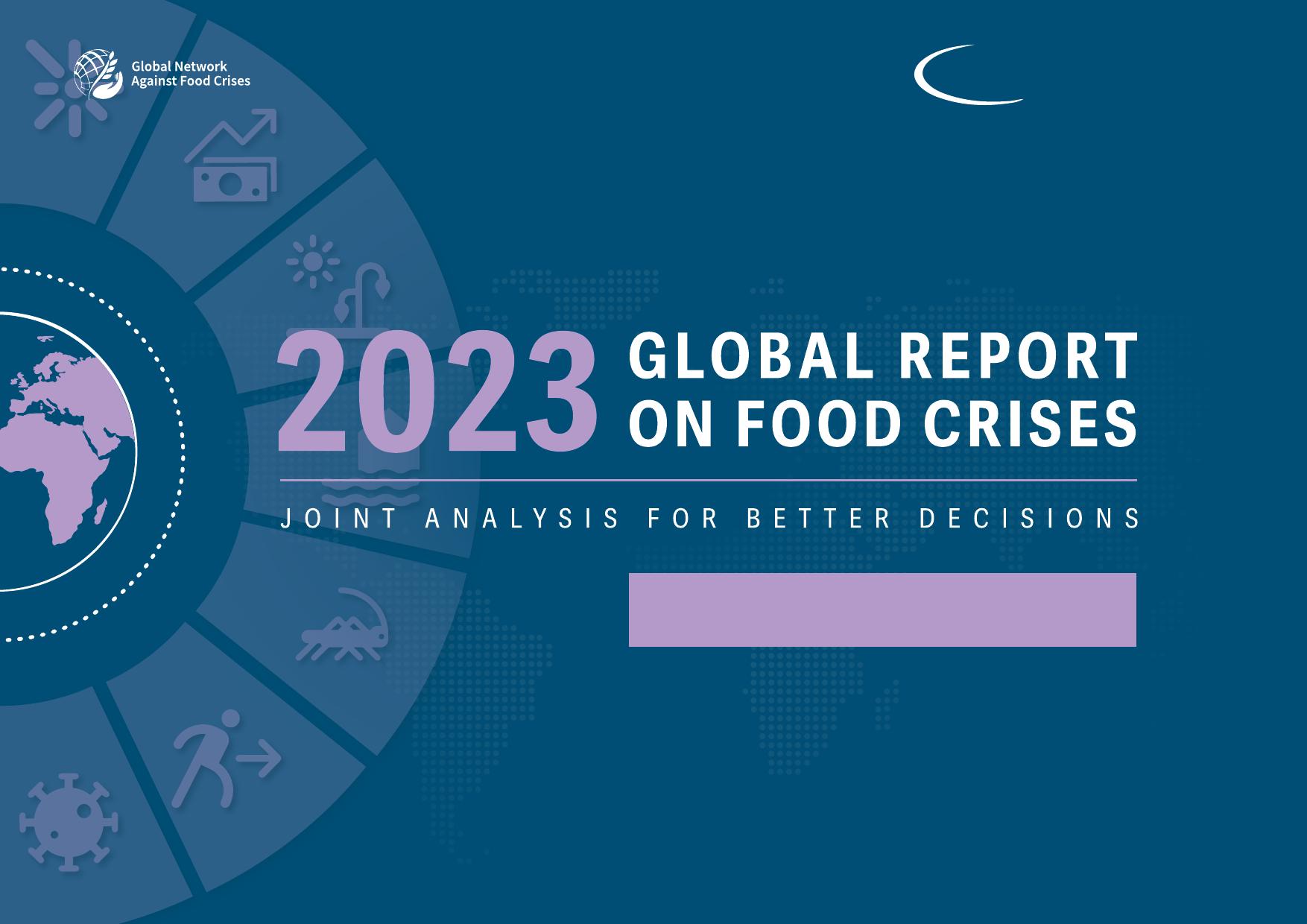FSINFoodSecurityInformationNetworkJointanalysisforbetterdecisionsMID-YEARUPDATEFContentsAcknowledgementsTheGlobalReportonFoodCrisesistheoutputofaremarkablepartnershipbetween16organizationsthattogetherFSINSecretariatcollect,analyseandinterpretavailabledatatoreportonvulnerablepopulationsfacingacutefoodinsecurityaroundtheworld.Wearethankfultothegovernments,internationalagencies,non-governmentorganizationsandinstitutionsFedericaCarfagna,EvanCarr,LynnClark,CarlosManuelEstevezReyes,GiulioFabris,MariaPaolaGuerra,thateachyearcontributetotheproductionoftheGRFC,includingthisGRFC2023Mid-YearUpdate.SaraMcHattie,PaulNeuman,EmilyOlssonandKatyWilliams.TheFoodSecurityInformationNetworkSecretariatisparticularlythankfultotheindividualswithwhomweTechnicalsupportfromGRFCpartnerorganizationscollaboratetodevelopthisproduct.Theyprovidethedataandreviewthereport'scontentusingtheirspecificexpertise,whichiswhatmakesthisreportsovaluable.Thankyoualsotothevulnerableindividuals,familiesandLaviniaAntonaci,ImmaculateAtieno,HeleneBerton,RogerioBonifacio,EricBranckaert,EnnieShonhiwaChikwanha,communitieswhosharetheirexperienceofhungerandenableustocommunicateitthroughthisdocument.ItisforSophieChotard,CristinaCoslet,AlessandroCostantino,AnneCelineDelinger,NanaDlamini,AntenehDobamo,themthatweproducethereport.IreneFerrari,AbdiFidar,GwenaelleGarnier,ValerieGatchell,NickGoetschalckx,ShannonHayes,NikkiAlexandraHerwanger,ArifHusain,BaouaIssoufou,SallyJames,DouglasJayasekaran,DamienJoud,ItisdifficulttolistallthenamesofpeoplewhocontributetothereportandthelistontherightisbynomeansKudzayiKariri,JanetKimani,BrendaLazarus,JoséLopez,OliverMaes,HamadounMahlamoudou,AbdulMajid,comprehensive.WilliamsMassaoud,AurélienMellin,QuraishiaMerzouk,NaserMohmand,SiphokaziMoloinyane,CinziaMonetta,GiampieroMuci,CharityMumbua,AnuradhaNarayan,MaryNjenga,TheuriTerryNjeri,AdamouOusmane,ThankyoutotheEuropeanUnionwithoutwhosefundingthisreportwouldnotbepossible.CinziaPapavero,ElisePolak,BenedettaPompili,JonathanPound,MelanieRabier,HasinaRakotomanana,FelixRembold,BrendanRice,JavierRodriguezCorrales,JoséRuizEspí,MohamedSalem,DuncanSamikwa,EdgarScrase,AlmudenaSerrano,RicardoSibrián,JungEunSohn,ChristineStrassmaier,AhmedSulaiman,FeliciaTakavarasha,GaolatheThobokwe,PhilippeThomas,LauraTosi,MonikaTothova,JoseManuelVeigaLopez-Pena,RoosmarijnVerstraeten,JoseluisVivero,RobVos,AnneWagner,LisamarieZammit,MarioZappacostaandHeinZeelie.GlobalNUTRITIONCLUSTER1GRFC2023MID-YEARUPDATEFContentsRequiredcitationFSINandGlobalNetworkAgainstFoodCrises.2023.GRFC2023Mid-YearUpdate.Rome.Allrightsreserved.Reproductionanddisseminationofmaterialinthisinformationproductforeducationalorothernon-commercialusesareauthorizedwithoutanypriorwrittenpermissionfromthecopyrightholdersprovidedthesourceisfullyacknowledged.Reproductionofmaterialinthisinformationproductforresaleorothercommercialpurposesisprohibitedwithoutwrittenpermission.ApplicationsforsuchpermissionshouldbeaddressedtotheFoodSecurityInformationNetworkSecretariat,email:fsin-secretariat@wfp.orgThedesignationsemployedandthepresentationofmaterialinthisinformationproductdonotimplytheexpressionofanyopinionwhatsoeveronthepartoftheFoodSecurityInformationNetwork(FSIN),itsconstituentpartiesanditspartnersconcerningthelegalordevelopmentstatusofanycountry,territory,cityorarea,orofitsauthorities,orconcerningthedelimitationofitsfrontiersorboundaries.©FSIN20232GRFC2023MID-YEARUPDATEContentsAcronyms.......................................................................................................................4Keyfindings......................................................................................................................5Introduction.....................................................................................................................6CHAPTER1AGLOBALOVERVIEWOFFOODCRISES.........................................................................8Acutefoodinsecurityoverview,mid-2023.........................................................................................9SpotlightLowerinternationalfoodpriceshavenoteasedeconomicpressuresatmacroandhouseholdlevels.................16SpotlightElNiñoreturnsamidmultipleglobalcrises..........................................................................18CHAPTER2REGIONALOVERVIEWOFFOODCRISESIN2023...............................................................20CentralandSouthernAfrica.....................................................................................................21EastAfrica.....................................................................................................................23FocusConflictintheSudan.................................................................................................26WestAfricaandtheSahel......................................................................................................28Asia............................................................................................................................30LatinAmericaandtheCaribbean...............................................................................................32MiddleEastandNorthAfrica...................................................................................................34APPENDICES..............................................................................................................36Tableofacutefoodinsecurityestimates,2021–2023.............................................................................37Appendix2CountryselectioncriteriaandcoveragefortheGRFC2023.......................................................42TECHNICALNOTES........................................................................................................44BIBLIOGRAPHY.............................................................................................................573GRFC2023MID-YEARUPDATEFContentsAcronymsACAPSAssessmentCapacitiesProjectITAInterimTalibanAuthorityASALAridandsemi-aridlandsIOMInternationalOrganizationforMigrationBSGIBlackSeaGrainInitiativeIPCIntegratedFoodSecurityPhaseClassificationCARIConsolidatedApproachtoReportingIndicatorsofFoodSecurityIPCAMNIntegratedFoodSecurityPhaseClassificationAcuteMalnutritionCGIARConsultativeGrouponInternationalAgriculturalResearchIPCFRCIntegratedFoodSecurityPhaseClassificationFamineReviewCommitteeCHCadreHarmoniséMAMModerateAcuteMalnutritionCILSSPermanentInterstateCommitteeforDroughtControl(ComitépermanentMUACMid-UpperArmCircumferenceinter-ÉtatdeluttecontrelasécheresseauSahelNDMANationalDisasterManagementAgency(Kenya)COVID-19Coronavirusdisease2019NOAANationalOceanicandAtmosphericAdministrationDTMDisplacementTrackingMatrixOCHAUnitedNationsOfficefortheCoordinationofHumanitarianAffairsFAOFoodandAgricultureOrganizationPBWPregnantandbreastfeedingwomenFAOGlobalInformationandEarlyWarningSystemonFoodandRPCAFoodCrisisPreventionNetwork(RéseaudePréventiondesCrisesFAO-GIEWSAgricultureAlimentaires)FederalCapitalTerritorySADCSouthernAfricanDevelopmentCommunityFCTForciblyDisplacedMyanmarNationalsSAMSevereAcuteMalnutritionFDMNFamineEarlyWarningSystemsNetworkSNNPREthiopianSouthernNations,Nationalities,andPeoples’RegionFEWSNETFoodSecurityInformationNetworkSOFITheStateofFoodSecurityandNutritionintheWorldFoodSecurityandNutritionAssessmentUnitTWGTechnicalWorkingGroupFSINFoodSecurityandNutritionWorkingGroupUnitedNationsFSNAUGlobalAcuteMalnutritionUNUnitedNationsConventiontoCombatDesertificationFSNWGGrouponEarthObservationsGlobalAgriculturalMonitoringInitiativeUNCCDUnitedNationsCountryTeamGlobalFoodSecurityClusterUnitedNationsOfficeforDisasterRiskReductionGAMGlobalNetworkAgainstFoodCrisesUNCTUnitedNationsChildren’sFundGEOGLAMGlobalNutritionClusterUNDRRUnitedStatesAgencyforInternationalDevelopmentGlobalReportonFoodCrisesUNICEFUnitedStatesDepartmentofAgricultureGFSCHumanitarianNeedsOverviewUSAIDWater,SanitationandHygieneGNAFCHumanitarianResponsePlanWorldBankInternallyDisplacedPersonUSDAWorldFoodProgrammeGNCInternationalFoodPolicyResearchInstituteWASHWeight-for-heightZ-scoreGRFCIntergovernmentalAuthorityonDevelopment(inEasternAfrica)HNOInternationalMonetaryFundWBWFPHRPWHZIDPIFPRIIGADIMF4GRFC2023MID-YEARUPDATEFContentsKeyfindingsHighlevelsofacutefoodinsecuritypersistin2023duetoprotractedfoodInfourcountriesatotalof128000peoplefaceCatastrophein2023crisesandnewshocks–butthereareimprovementsinsomecountries.73ThisMid-YearUpdateonlyincludes48ofIn36outof39countrieswithIPC/CHAt128000,thenumberofpeopleinscale‑upofhumanitarianassistancetopopulations48the73GRFC2023food-crisiscountries/analyses,around33.6millionpeoplefaceCatastrophe(IPC/CHPhase5)inBurkinamostinneed.InBurkinaFaso,42700peoplefaceCHterritorieswithanalysescovering2023Emergency(IPC/CHPhase4),withalmostFaso,Mali,SomaliaandSouthSudanislowerPhase5,thehighestinthehistoryoftheCH,andMali21%thatwereavailablebyearlyAugust.halfofthemintheSudan,Afghanistanandthanin2022when376000peoplewereinthisphaseinhaspopulationsprojectedinthisphaseforthefirsttheDemocraticRepublicoftheCongo.Afghanistan,BurkinaFaso,Haiti,Nigeria,Somalia,time(2500people).InSomalia,40400peoplefaceIPCAt21percent,theshareofthetotalSouthSudanandYemen.ThisismainlyexplainedbyPhase5,80percentfewerthanin2022,andnoareasanalysedpopulationinneedofurgentfoodIn39countrieswithIPC/CHanalyses,improvementsinsomecontexts(e.g.droughtinEastareatRiskofFamine.InSouthSudanthenumberassistanceinthe48countriesislargelyaround285millionpeoplefaceStressedAfricamitigatedbyimprovedrainfall)andbytheprojectedtobeinIPCPhase5hashalvedto43000.unchanged(from22percentin2022).(IPC/CHPhase2)in2023.Zambia,the25DemocraticRepublicoftheCongoandRegionaloverviewsdecreasedinGuatemalaandHonduras,andincreasedInthese48countries,21.6millionmore73BurundihavethehighestsharesoftheirinHaiti.peoplefacehighlevelsofacutefoodpopulationsinthisphase.InCentralandSouthernAfrica,upto46.7millionpeopleinsecuritythanin2022(a10percent(19percentoftheanalysedpopulation)faceIPCPhase3IntheMiddleEastandNorthAfricaregion,uptoincrease),bringingthenumbertoIn2023,27.2millionchildrenunder5yearsorabovein12countries,adecreasesince2022largely20.7million(54percentoftheanalysedpopulation)face238million.Theincreaseisduebothtoaareaffectedbywastingin21food-crisisduetoimprovedfoodavailability.highlevelsofacutefoodinsecurityinthreecountries.16percentexpansioninanalysiscoveragecountrieswithdata,ofwhomnearlyThisisduetothehighvulnerabilityofSyrianrefugeesamongvulnerablepopulationsinafew7.2millionareseverelywasted.EastAfricafacesfurtherdeteriorationwithuptoinJordan,refugeesandresidentsinLebanon,andcountriesincludingBangladesh,Angola,65.2millionpeoplefacinghighlevelsofacutefoodpopulationsinYemen.Ghana,PakistanandNigeria,andpersistentAnestimated6.3millionpregnantandinsecurity(23percentoftheanalysedpopulation)ineightorintensifyingconflict/insecurity,breastfeedingwomenareaffectedcountries.ThisisdrivenbyconflictintheSudanandtheDriversin2023weatherextremesandeconomicshocks.byacutemalnutritionin15food‑crisispersistingimpactofthedroughtintheHornofAfrica.countrieswithdata.SignificantincreasesinConflict/insecurityThewarinUkrainestillConditionshaveworsenedinninenumbersofwastedchildrenareestimatedInWestAfrica,around44.1millionpeoplefacehighcausesuncertaintyinglobalfoodmarkets.Warcountriessince2022,includingtheSudaninKenya,MauritaniaandtheSudan.levelsofacutefoodinsecurity(11percentoftheanalysedintheSudancontinuestodevastatethewithanadditional8.6millionpeoplefacingpopulation)in15countries.Agoodagriculturalseasoncountryanddrivehighlevelsofdisplacementregionally.highlevelsofacutefoodinsecurity,andTheoverallnumberofpeoplefacinghighmitigatedtheimpactsofeconomicshocksandconflict.ProtractedinsecurityandconflictcontinuetodriveacuteSomaliaandBurundiwitharound1millionlevelsofacutefoodinsecurityin2023Politicalinstabilityfollowingthecoupd'étatintheNigerfoodinsecurityacrossmanyfood‑crisiscountries.moreeach.TheDemocraticRepublicofwilllikelyincreaseasnewdatabecomecouldaffectlivelihoodsandfoodsecurityandimpactthetheCongo,NigeriaandtheSudanhavetheavailableforGRFCcountries/territorieswiderregion.EconomicshocksDecreasingglobalfoodlargestnumbersofpeople,whileSouththatdonotyethave2023data,andifpricesarenottransmittingtocountrieswhereSudan,YemenandHaitihavethelargestdriversintensify.Asiacountsanestimated47.5millionpeople(34percentpricesremainhigh.Continuedhighpublicdebtshare.MorethanhalfofrefugeesinJordanoftheanalysedpopulation)inhighlevelsofacutelimitsgovernmentoptionstoimportfoodandmitigateandLebanonarefacingthesehighlevels.Datagapsremainaconcern.Nodataarefoodinsecurityinfourcountries.Numbersreducedtheeffectsofhighprices.availablefor25countries/territories,teninSriLanka,andtherewasanincreaseinanalysedThe15countrieswithimprovementsofwhichhaddatain2022accountingpopulationsinBangladeshandPakistan.WeatherextremesManycountriesarefacingincludeSriLanka,theNigerandthefor41millionpeoplefacinghighlevelsofprolongedrecoveryfromdroughtorflooding.DemocraticRepublicoftheCongo,butacutefoodinsecurity.TheyincludesomeInLatinAmericaandtheCaribbeanupto13.6millionThereisahighprobabilityofamoderatelyrecentdevelopmentsintheNigermayofthelargestfoodcrises,suchasMyanmar,people(22percentoftheanalysedpopulation)facehighstrongElNiñoevent,drivingweatherextremesandreversethis.theSyrianArabRepublicandUkraine.levelsofacutefoodinsecurityinsixcountries.Numberspeakinginearly2024.5GRFC2023MID-YEARUPDATEIntroductionFContentsIntroductionThisGRFC2023Mid-YearUpdateprovidesaglobalTheGRFCfoundation:evidence-basedpublicgoodIPC/CHacutefoodinsecurityphasedescriptionandresponseobjectivesoverviewoffoodcrisesforthecurrentyearbasedondataavailableby2August2023.AstrongpartnershipPhasePhasedescriptionandpriorityresponseobjectivesTheGRFC2023,publishedinMay2023,providedtheAhighlyconsultativeprocessPhase1Householdsareabletomeetessentialfoodandnon-foodneedswithoutengaginginatypicalandestimateofthepeaknumberofpeoplefacinghighlevelsNone/Minimalunsustainablestrategiestoaccessfoodandincome.Actionrequiredtobuildresilienceandfordisasterriskofacutefoodinsecurity(IPC/CHPhase3orabove,orAcompilationofmultipleconsensus-reduction.equivalent)in58countries/territorieswithdata(outbasedfoodsecurityandnutritionanalysesof73identifiedasfoodcrises)for2022.ItprovidedPhase2Householdshaveminimallyadequatefoodconsumptionbutareunabletoaffordsomeessentialnon-foodestimatesandprojectionsfor2023for38ofthemwhereAtechnicaldocumentofreferenceStressedexpenditureswithoutengaginginstress-copingstrategies.Actionrequiredfordisasterriskreductionandtodatawereavailable.onfoodcrisesprotectlivelihoods.BetweenthepublicationoftheGRFC2023andearlyFurtheranalysesareanticipatedforadditionalcountriesPhase3Householdseither:August2023,newanalysesandprojectionupdatesthroughtotheendof2023,includingforMyanmar,theCrisis•�havefoodconsumptiongapsthatarereflectedbyhighorabove-usualacutemalnutrition;orbecameavailable,bringingthetotalnumberoffood-crisisSyrianArabRepublicandUkraine,andpeakestimates•�aremarginallyabletomeetminimumfoodneedsbutonlybydepletingessentiallivelihoodassetsorthroughcountrieswithdatafortheyear2023to48.mayalsoincreaseforcountriesreportedonhere.crisis-copingstrategies.Usingtheavailabledatafromthenew2023analysesWhatisafoodcrisis?URGENTACTIONrequiredtoprotectlivelihoodsandreducefoodconsumptiongaps.aswellasthe2023projectiondatafromanalysesconductedin2022wherenecessary,thisreportprovidesFoodcrisesaresituationswhereacutefoodinsecurityPhase4Householdseither:thelatestpeakfiguresforacutelyfood-insecureandacutemalnutritionriseoraresustainedatlocalEmergencypopulationsin2023.ornationallevels,exceedingthelocalresources•�havelargefoodconsumptiongapswhicharereflectedinveryhighacutemalnutritionandexcessmortality;andcapacitiestorespond,andraisingtheneedfororNodatafor2023areavailablefor25ofthe73GRFC2023emergencyandexternalfoodassistance.Theyarefood‑crisiscountries/territories,includingthreeofthemorelikelyamongpopulationsalreadysufferingfrom•�areabletomitigatelargefoodconsumptiongapsbutonlybyemployingemergencylivelihoodstrategiesandlargestfoodcrisesof2022–Myanmar,theSyrianArabprolongedfoodinsecurityandmalnutrition,andinareasassetliquidation.RepublicandUkraine.wherestructuralfactorsincreasetheirvulnerabilitytoshocks.TheycanalsooccurincountriesthathaveURGENTACTIONrequiredtosavelivesandlivelihoods.Ofthe48countrieswithavailabledatafor2023,37areimportanteconomicactivitiesandaremajorfooddefinedasmajorfoodcrisesaccordingtotheGRFCexporters,suchasUkraine.ThecapacityofgovernmentsPhase5Householdshaveanextremelackoffoodand/orotherbasicneedsevenafterfullemploymentofcopingcriteria.Seeappendix2.torespondcaninfluencethemagnitudeandseverityCatastrophe/strategies.Starvation,death,destitutionandextremelycriticalacutemalnutritionlevelsareevident(foroffoodcrisesinacountry.TheycanbetemporaryorFamineFamineclassification,areaneedstohaveextremecriticallevelsofacutemalnutritionandmortality.)protracted,andwhentheyarerepeatedand/orsustainedtheycanprovokechronicfoodinsecurity(FAO,IFAD,URGENTACTIONrequiredtorevert/preventwidespreaddeathandtotalcollapseoflivelihoods.UNICEF,WFP&WHO,July2023).AFamineclassificationrequiresevidenceonfoodsecurity,nutritionandmortalityatoraboveIPCPhase5thresholds.IfthereareinsufficientdataforTheGRFCprocessesaimtoidentifyfoodcrisesbasedFamineclassificationbuttheavailableinformationindicatesthatFamineislikelyoccurringorwilloccur,thentheFamineclassificationiscalled‘FamineontheinteractionofshocksexperiencedinthepreviousLikely’.ItisimportanttonotethatFamineandFamineLikelyareequallysevere.yearthataffectoneormoreofthefourpillarsoffoodTheGRFC2023identified73food‑crisissecurity:foodavailability,access,utilizationandleadingtoarequestfortheurgentmobilizationofthedataonacutelyfood-insecurepopulationsinStressedcountries/territoriesstability.Itfocusesoncountries/territorieswherethereinternationalcommunity.(IPC/CHPhase2)whorequirelivelihood,disasterriskisevidencethatthemagnitudeand/orseverityofacutereductionand/orsocialprotectionassistance.When7325GRFC2023countriesfoodinsecurityandacutemalnutritionexceedsthelocalMethodologyanIPC/CHanalysisisnotavailable,theGRFCTechnicalwith2023databyearlyresourcesandcapacitiesneededtorespondeffectively,WorkingGroupsevaluatetheuseofothersourcesofcountries/August2023.TheGRFCreliesprimarilyondatafromIntegratedFoodevidence.ThisMid-YearUpdateusesFEWSNETanalyses,territoriesSecurityPhaseClassification(IPC)andCadreHarmoniséwhichareIPC-compatible,andWFPConsolidatedGRFC2023countries/(CH)analyses.ItpresentspopulationsinCrisisorworseApproachforReportingIndicators(CARI),whichusesinfoodterritorieswithout(IPC/CHPhase3orabove)whofacehighlevelsofacutehousehold-levelanalysistoreportmoderateandsevere48crisis2023datatodate.foodinsecurityandneedurgenthumanitarianassistancelevelsofacutefoodinsecurity,whicharereportedtoreducefoodconsumptiongaps,andtoprotectandasanapproximationtopopulationsfacingIPC/CHsavelivelihoodsandlives.ThisreportalsoprovidesPhase3orabove.6GRFC2023MID-YEARUPDATEIntroductionFContentsMAP1.1Mid-YearUpdate:Availabilityofdatain73GRFC2023countries/territories,byearlyAugust2023UKRAINETÜRKIYETAJIKISTANDEMOCRATICPEOPLE’SREPUBLICOFKOREAAFGHANISTANSYRIANARABREPUBLICIRAQIRANLEBANONJORDANPAKISTANPALESTINENEPALALGERIALIBYAEGYPTCUBABANGLADESHMYANMARLAOPEOPLE’SDEMOCRATICREPUBLICHONDURASHAITIDOMINICANREPUBLICMAURITANIACABOVERDEMALINIGERSUDANERITREAYEMENGUATEMALASENEGALBURKINACHADPHILIPPINESELSALVADORGAMBIAFASONICARAGUAGUINEA-BISSAUDJIBOUTICOLOMBIAVENEZUELAGUINEAGHANANIGERIASOMALIA(BolivarianTOGORepublicof)SIERRALEONECENTRALAFRICANSOUTHETHIOPIALIBERIAREPUBLICSUDANSRILANKACAMEROONECUADORUGANDAKENYACONGODEMOCRATICRWANDAREPUBLICOFTHEBURUNDICONGOUNITEDREPUBLICPAPUANEWGUINEAOFTANZANIAPERUANGOLAMALAWIZAMBIAZIMBABWEMADAGASCARNAMIBIAMOZAMBIQUEESWATINITONGALESOTHODataavailableNodata(datagap,datanotmeetingGRFCpartnersconsensus,populationnotanalysed)CountrynotselectedforanalysisIndicatesmigrants/refugeepopulations(colourcodingasthiskey)TheboundariesandnamesshownandthedesignationsusedonthismapdonotimplyofficialendorsementoracceptancebytheUnitedNations.FinalboundarybetweentheRepublicofSudanandtheRepublicofSouthSudanhasnotyetbeendetermined.FinalstatusoftheAbyeiareaisnotyetdetermined.SeeAppendix2forcountryselectioncriteriaandcoveragefortheGRFC2023.Source:FSIN,GRFCMid-YearUpdate2023.7GRFC2023MID-YEARUPDATECHAPTER1AGLOBALOVERVIEWOFFOODCRISESChapter1AglobaloverviewoffoodcrisesFContentsAcutefoodinsecurityoverview,mid-2023ACUTEFOODINSECURITYPEAK2023BasedondataavailableasofearlyAugust,around©WFP/ELOGEMBAIHONDOUM238millionpeoplefacehighlevelsofacutefood48ofthe73GRFC2023food-crisisinsecurity(IPC/CHPhase3oraboveorequivalent)in48countriesin2023.73countries/territorieshave2023dataInthe39countrieswithIPC/CHanalyses,33.64million48byearlyAugust.peoplefaceEmergency(IPC/CHPhase4)conditionsin36countriesand128600peopleCatastrophe(IPC/CH238Mpeople–21%oftheanalysedPhase5)conditionsinfourcountries.population–in48countriesfacehighlevelsofacutefoodinsecurityin2023ThisreportprovidesapartialupdateofacutefoodinsecuritynumbersbyearlyAugust2023.Duetoalackof187.5Mofthemarein39countrieswithIPC/updateddata,thenumbersdonotincludeestimatesfortencountrieswhere41millionpeoplefacedhighlevelsCHanalysesofacutefoodinsecurityin2022(includingthreeofthelargestfoodcrisesof2022–Myanmar,theSyrianArab153.75Min33.64Min0.13MinRepublicandUkraine).The2023numbersarelikelytoThemagnitudeofacutefoodinsecurityintheSudanhasincreasedsharplysincethestartofclashesinApril2023.39countries36countries4countriesincreaseasnewanalysesbecomeavailable.Phase3Phase4Phase5Whencomparingdatafromthe48countriesincludedinboththeGRFC2023andtheGRFC2023Mid-YearThisdoesnotinclude19200peoplefacingCatastrophe(IPCPhase5)Update,thenumberofpeopleinIPC/CHPhase3oraboveinsecuritymarginallydeclinedfrom22percentin2022toincreaseintheprevalenceofpeopleinIPCPhase3oroutsidethe2023peakperiod(March–June2023)ofacutefoodorequivalenthasincreasedbyaround10percent,from21percentin2023.above,risingfrom24percentto42percent.ThenumberinsecurityinHaiti.216.25millionin2022.ThisisduebothtoexpandingofpeoplefacinghighlevelsofacutefoodinsecurityanalysiscoverageamongalreadyvulnerablepopulationsExpandedanalysiscoveragein2023increasedby74percenttoreach20.3million,includingUpto46Mofthemareinsevencountriesandpersistentorintensifyingdrivers.Overall,theanalysedpopulationincreasedby16percent6.3millioninEmergency(IPCPhase4).Burundi,Djibouti,since2022withmajorincreasesconcentratedinafewtheGambia,Haiti,Lebanon(residentsandrefugees),withFEWSNETanalysesOverall,inthese48countries,theproportionofthecountriessuchasBangladesh(+2254percent),AngolaLiberia,SenegalamdSomaliaarealsoexperiencinganalysedpopulationfacinghighlevelsofacutefood(+1100percent),Ghana(+139percent)andPakistansignificantyear‑on‑yeardeteriorations.Nodatadisaggregatedbyphaseareavailableforthesecountries.(+85percent).InNigeria,a22percentincreaseintheFIGURE1.1analysedpopulationtranslatesto35millionadditionalConversely,improvementsarenotableacross4.4Mofthemareintwocountriespeoplebeinganalysed.15countries,particularlyinNamibia,wheretheshareOverallchangesin48food-crisiscountriesoftheanalysedpopulationfacinghighlevelsofacutewithWFPCARIanalysesShocksdriveupacutefoodinsecurityinsomefoodinsecuritydecreasedfrom30percentto15percent,between2022and2023countries,notablyintheSudanandinSriLanka,whereitdeclinedfrom28percenttoNodatadisaggregatedbyphaseareavailableforthesecountries.1,400Ninecountrieswithcomparableanalysiscoverage17percent.Seemaps1.2and1.3.arefacinganincreaseinthenumberandshareofthe285MpeopleareinStressed1,2001.16BNAnalysiscoveragepopulationfacingIPC/CHPhase3oraboveorequivalent,Conflictremainsthemaindriverupby16%todrivenbyshockssuchasthewarintheSudan,highfood(IPC/CHPhase2)in39countrieswithIPC/CHMILLIONSOFPEOPLE1,0001.0BN920.921.16billion.inflationandextremeweatherevents.Thedriversoffoodcrisesareinterlinkedandmutuallyanalysesreinforcing.Acutefoodinsecurityisrarelydrivenbya800NumberofpeopleAmongthecountrieswitheithernoorminimalsingleshockorhazard,butratherbytheinteractionSource:IPCTWGs,CH,FEWSNET,WFPCARI,2022and2023.facinghighlevelsdifferencesinthepopulationanalysedbetween2022andbetweenshocks–singleorcumulative–andunderlying600785.782023,theSudanstandsoutashavingthebiggestpoverty,structuralweaknessesandothervulnerabilityfactors.Whileeconomicshocksaresignificantlyaffecting400ofacutefood200237.89insecurityup216.25by10%.0JAN–DEC2022JAN–AUG2023IPC/CHPhase1and2andnonIPC/CHPhase3+andnonIPC/IPC/CHfoodsecure+marginalCHmoderate+severeacutefoodsecurityfoodinsecuritySource:IPCTWGs,2022and2023;CH,2023;FEWSNET,2023.9GRFC2023MID-YEARUPDATEChapter1AglobaloverviewoffoodcrisesFContentsthevastmajorityoffood‑crisiscountries,conflictremainsbystarvation,criticallevelsofacutemalnutrition,highFIGURE1.3FIGURE1.4themaindriverformostpeopleexperiencinghighlevelslevelsofexcessmortalityandcollapseoflivelihoods.ofacutefoodinsecurity.WeatherextremescontinuetoManydeathsoccurevenbeforeIPC/CHPhase5isThetencountrieswithmorethan1millionCountrieswithmorethan40percentofthebeasignificantdriverinanumberofcountries.reached,suchthatatthisphaseanyhumanitarianpeopleinIPC/CHPhase4analysedpopulationinIPCPhase2responseisalreadytoolateformany.SUDAN6.26ZZAAMMBBIAIA49%AsofearlyAugust2023,about128600areestimatedDEMDOECMRAOTCIRCARTEICPURBELPIUCBOLFICTOHFE45%AcutefoodinsecuritybyIPC/CHorprojectedtobeinIPC/CHPhase5duringthepeakAFGHANISTAN6.0844%phasebyearlyAugust2023analysesinfourcountries(seefigure1.2).InHaiti,192003.38CONGOTHECONGO42%peoplewereprojectedtobeinIPCPhase5inearly2023.DEMDOEMCROACTRIACTRIECPRUEBPLUICBLOICF2.90BURUNDI40%ThissectionprovidesmoredetailedanalysisoftheHowever,aprojectionupdatefortheperiodMarch–JuneOFTHETCHOENCGOONGO40%mostseverephasesofacutefoodinsecurity(IPC/CH2023capturingthepeaknumberofpeopleinIPCPhaseLEBANON(RESIDENTS)Phase4and5)aswellasanoverviewofpopulationsin3orabovedidnotincludeanypopulationinIPCPhase5.SOUTHSUDANIPC/CHPhase2.Ninecountrieswithnearly50millionThetotalpopulationinIPC/CHPhase5in2023islowerMMADOAZGAMASBCIQAUREhighlyacutelyfood-insecurepeopledonothaveIPC/thanthe376000estimatedin2022insevencountriesBANGLADESH2.22CHanalysesandthereforeabreakdownbyphaseisnot–Afghanistan,BurkinaFaso,Haiti,Nigeria,Somalia,MMAODZAAGMABSIQCUAREavailable.SouthSudanandYemen–partlyduetothescale-upPPAAKKISISTATANN2.21oftimelyassistanceincontextslikeAfghanistan,HaitiandSomalia,andimprovingconditionsinsomeareas.SOMALIA1.85However,nobreakdownbyphaseisavailablein2023forYemen,whichhad31000peopleinIPCPhase5in2022.HAITI1.81InMadagascar,21%ofthetotalpopulationwasanalysed.InZambia,71%wasanalysed.PopulationsinCatastrophe(IPC/CHPhase5):InSouthSudan,thepopulationinIPCPhase5wasKENYA1.220.13millionpeopleinfourcountriesprojectedtohalvefrom87000inApril–July2022toSource:IPCTWGs,2022and2023.43000inApril–July2023.NIGERIA1.14PopulationsinStressed(IPC/CHPhase2):InBurkinaFaso,thepopulationinCHPhase5increased285millionpeoplein39countriesCatastrophe(IP20C22/CHPhase8750)0i0sthemostseverephaseSOUTHSOMALIASOUBTUHRKINAFASOSOUTSHUDANSOMALIAMALIBURKISNOAMFALSIOAMSAULBIDUARNKINAFSAOSMOAMLAILIASUDANBUSROKIMNALAIFAASOBSURUKDIANNAFASOSUDANsignificantlyfrom1800inOctober–December2022toIPCanalysispendinggovernmentapprovalatthetimeofpublication.ofacutefoodin20s2e32c0u224r3it0y0.0Peopl8e7f0a0c0eanextremelack42700inJune–August2023,thehighestCHPhase5Source:IPCTWGs,2022and2023;CH,2023.PeoplefacingStressed(IPC/CHPhase2)haveminimallyoffoodandareunabletomeetotherbasicneedsevenfigureeverprojectedforthecountry.adequatefoodconsumptionbutmustadoptstresswithemergencyc2o0p23ing4s3t0r0a0tegies.ThephaseismarkedPopulationsinEmergency(IPC/CHPhase4):copingstrategiestosupportnon-foodneeds.TheyareThereisasignificantdecreaseinSomaliafrom33.64millionpeoplein36countriesacutelyfoodinsecureandhighlyvulnerabletoshocks,so20221800214100peopleduringOctober–December2022toincreasesinpopulationsfacingthisphasecouldindicate40400duringApril–June2023.AreasclassifiedatRiskHouseholdsestimatedtobeinEmergency(IPC/CHadecreaseinresilienceandincreasedriskofpopulationsFIGURE1.220232200222242710800087000ofFaminein2022arenolongersoin2023,includingPhase4)eitherhavelargefoodconsumptiongaps,whichfallingintomoreseverephasesofacutefoodinsecurity.agropastoralcommunitiesinBurhakabadistrict(BayarereflectedinveryhighacutemalnutritionanddeathNumberofpeop2200l22e33fa44c23i70n000g0IPC/CHPhase5inregion),andIDPsinMogadishuandBaidoasettlements.ratesthatare2–4timeshigherthaninnormalconditions,In2023,nearly285millionpeopleareinIPC/CHPhase2Thisisattributabletohumanitarianassistance,decliningortheycanmitigatethesefoodgapsonlybyemployingin39countrieswithIPC/CHanalyses.Thisishigherfourcountries214000foodprices,andimprovedaccesstoincome-generatingemergencylivelihoodstrategiesandassetliquidation,thanin2022(around253millionpeoplein41countries),2022activities–mainlyduetoabetter-than-expectedputtingatseriousrisktheirfuturelivelihoods.ByearlyalthoughfurtheranalysiswouldbenecessarytoperformanceoftheOctober–December2022DeyrAugust2023,33.64millionpeoplefaceorareprojectedtodeterminethedynamicsacrossdifferentphases.BURKINAOct–D20e2c3222000222224204108000214000rainyseason.faceIPC/CHPhase4in36countrieswithIPC/CHdata.FASOJun–Aug2220002223324402740000ThecountrieswiththehighestnumbersofpeopleinIPC/SMOAULITH87000InMali,forthefirsttimeinthehistoryoftheCHandtheWhencomparingthesamecountrieswithdisaggregatedCHPhase2areNigeria(63.98million),theDemocraticGRFC,2500peoplefaceCHPhase5in2023.datain2022and2023,theprevalencehasremainedRepublicoftheCongo(46.84milliom)andtheSudanMALI20232200223250403000214000unchangedat3.8percentoftheanalysedpopulationwith(17.09million).Theyaccountfor45percentofthetotalJun–Aug222000222322500TheprevalenceoftheanalysedpopulationinIPC/notabledifferencesbycountry.Numbersparticularlynumberofpeopleinthisphase.ForaclearerpictureofSOUTHCHPhase5acrossthefourcountriesrangesfromincreasedintheSudan(+3.15million)anddecreasedacountry’shighervulnerabilitytopotentialshocksandSUDAN22002232SOUTH410804000870000.01percent(Mali)to0.35percent(SouthSudan).intheDemocraticRepublicoftheCongo(-450000).needforexternalsupporttoprotectlivelihoods,figure1.4Bangladesh,wheretheanalysiscoveragewasexpandedhighlightstheproportionoftheanalysedpopulationinApr–Jul220022242700in2023,has2.2millionpeopleinIPCPhase4.TheSudanthisphase:sixcountrieshavemorethan40percentof202343000andAfghanistanhavethelargestpopulationsinthistheiranalysedpopulationinIPCPhase2indicatingthat2500phase(seefigure6),whileSouthSudanandHaitihaveahighproportionofpeoplerequiresocialprotection,Apr–Jul2200223thehighestproportionoftheirpopulationsinthisphase,disasterriskreductionandlivelihoodsupporttoreduce2023at23percentand18percentrespectively.theirvulnerabilitytoshocks.Oct–Dec220022222140002022SOMALIA1800Apr–Jun2200223320234040042700IPC/CHPhase5(2023)214000202325002022Thesearebasedonprojectedanalyses.Source:IPCTWGs,2022202a3nd24002430;0CH,2022and2023.MALI2023250010GRFC2023MID-YEARUPDATEChapter1AglobaloverviewoffoodcrisesFContentsMAP1.2PercentagechangeinnumberofpeopleinCrisisorworse(IPC/CHPhase3orabove)in33countries/territoriesfrom2022–2023WESTAFRICAANDMIDDLEEASTANDASIANORTHAFRICATHESAHELInSriLanka,thereisa38%InLebanon,themagnitudedecreaseinmagnitude,duetoIneightcountriesthemagnitudeincreasesforSyrianrefugees(+15%)theimprovingmacroeconomicdeclines,mostlyinGuinea(-42%),andLebaneseresidents(+13%).situation.Afghanistan’speakMali(-31%)andNiger(-25%).estimatestraddlesbothyears.However,inMaliandBurkinaUKRAINEFaso,severityincreaseswithmorepeoplefacingCatastrophe(CHTÜRKIYETAJIKISTANDEMOCRATICPEOPLE’SREPUBLICOFKOREAPhase5).Inthreecountries–theNEPALGambia(+54%),Liberia(+42%)andSYRIANARABREPUBLICIRAQIRANAFGHANISTANSenegal(+43%)–themagnitudeLEBANONJORDANPAKISTANincreasessignificantly.PALESTINEALGERIALIBYAEGYPTLATINAMERICAANDCUBADOMINICANREPUBLICMAURITANIABANGLADESHMYANMARLAOPEOPLE’SDEMOCRATICREPUBLICHAITIPHILIPPINESTHECARIBBEANCABOVERDEMALINIGERSUDANERITREAYEMENSRILANKAHONDURASBURKINAFASOInHaiti,themagnitudeincreasesGUATEMALASENEGALCHADSOUTHEASTAFRICA(+4%)anditdecreasesinELSALVADORGAMBIASUDANGuatemala(-7%)andHondurasNICARAGUAGUINEA-BISSAUDJIBOUTIInfourcountries,themagnitude(-9%).DominicanRepublic’speakUGANDASOMALIAincreases,withthesharpestrisesestimatestraddlesbothyears.VENEZUELAGUINEANIGERIAintheSudan(+74%),Burundi(Bolivarian(+65%)andDjibouti(+49%)Republicof)SIERRALEONECENTRALAFRICANETHIOPIAfollowedbySomalia(+6%).LIBERIAREPUBLICInSomalia,however,fewerCOLOMBIATOGOpopulationsareinCatastropheGHANACAMEROON(IPCPhase5).InSouthSudanthemagnituderemainssimilar,buttheKENYApopulationsinIPCPhase5havehalved.ECUADORDEMOCRATICRWANDAREPUBLICOFTHEBURUNDICONGOCONGOUNITEDREPUBLICCENTRALANDOFTANZANIAPERUPAPUANEWGUINEASOUTHERNAFRICAANGOLAMALAWIInfourcountriesthemagnitudedeclines,especiallyinNamibiaZAMBIA(-48%)andEswatini(-23%),andtoalesserextentintheDemocraticZIMBABWEMADAGASCARRepublicoftheCongoandLesotho.InsixcountriespeakacutefoodNAMIBIAMOZAMBIQUEinsecurityestimatesstraddletheESWATINITONGAtwoyears–theCentralAfricanLESOTHORepublic,Madagascar,Malawi,Mozambique,theUnitedRepublicofTanzaniaandZambia.PercentagedecreaseinnumbersPercentageincreaseinnumbersSameanalysis2022/23Countrynotselectedforanalysis>30percent0to10percent>10to30percent>10to30percentDatanotcomparableMigrants/refugeepopulations(colourcodingasthiskey)0to10percent>30percentNodata(datagap,datanotmeetingGRFCpartnersconsensus,populationnotanalysed)Ofthe48countrieswith2023data,33havecomparablepointestimatesbecausetheyusethesamedatasourcefor2022and2023andhavelessthana10percentdifferenceinanalysiscoverage.TheboundariesandnamesshownandthedesignationsusedonthismapdonotimplyofficialendorsementoracceptancebytheUnitedNations.FinalboundarybetweentheRepublicofSudanandtheRepublicofSouthSudanhasnotyetbeendetermined.FinalstatusoftheAbyeiareaisnotyetdetermined.Source:FSIN,GRFCMid-YearUpdate2023.11GRFC2023MID-YEARUPDATEChapter1AglobaloverviewoffoodcrisesFContentsMAP1.3ThedifferenceinshareofpeopleinCrisisorworse(IPC/CHPhase3orabove)in33countries/territoriesfrom2022–2023WESTAFRICAANDMIDDLEEASTANDNORTHAFRICAASIATHESAHELFurthereconomicdeteriorationincludingInSriLanka–theonlycountrywithdepreciationoftheLebanesepound(LBP),andcomparableyear-on-yeardata–Acrosseightcountries,thereprotractedinflationdrivesincreasingprevalencethedecreaseinprevalencefromisadeclineinprevalence,frominLebanon:amongresidentstheprevalencewas28%in2022to17%in2023facing13.4%in2022to10.6%in2023,projectedtoincreasefrom33%to38%andamongmoderateacutefoodinsecurityreflectinghigher-than-averagethe1.5millionSyrianrefugeesfrom46%to53%.stemsfromreducedfoodpricesagriculturalproductionboostingandimprovedincomesamongfoodavailability.However,thereUKRAINEfarmingcommunitiesduringtheareincreasesinGambia,Liberiamainharvestingperiod.andSenegalwithpersistinghighLATINAMERICAANDinflation,especiallyincoastalTÜRKIYETAJIKISTANDEMOCRATICPEOPLE’SREPUBLICOFKOREATHECARIBBEANcountries,akeydriver.NEPALSYRIANARABREPUBLICIRAQIRANAFGHANISTANInHaiti,themarginalincreaseLEBANONJORDANPAKISTANinprevalencefrom48%to49%reflectspersistinginsecurityPALESTINEandgangviolence,coupledwitheconomicshocksandALGERIALIBYAreducedagriculturalproductionunderpinnedbytheimpactofEGYPTweatherextremes.AlthoughthereareslightdeclinesinprevalenceinCUBADOMINICANREPUBLICMAURITANIABANGLADESHMYANMARLAOPEOPLE’SDEMOCRATICREPUBLICGuatemalaandHondurasmainlyHONDURASHAITIPHILIPPINESduetoimprovementsineconomicCABOVERDEMALINIGERSUDANERITREAYEMENSRILANKAactivities,aroundoneinfourBURKINAFASOpeopleremainhighlyacutelyfoodGUATEMALASENEGALCHADSOUTHEASTAFRICAinsecure.ELSALVADORGAMBIATOGOSUDANNICARAGUAGUINEA-BISSAUGHANADJIBOUTITheregion’sescalatingfoodcrisisTONGACOLOMBIAVENEZUELAGUINEANIGERIASOMALIAisreflectedintheincreasing(BolivarianprevalenceacrossthefiveRepublicof)SIERRALEONECENTRALAFRICANETHIOPIAcountrieswithcomparabledataLIBERIAREPUBLICinbothyears.ThedeteriorationisdrivenbytheimpactsoftheCAMEROONconflictintheSudanaswellasthedifficultrecoveryfromdroughtECUADORKENYAintheHornofAfrica,widespreadUGANDAeconomicshocks,weatherextremesandinsecurity.CONGODEMOCRATICRWANDAREPUBLICOFTHEBURUNDICENTRALANDSOUTHERNAFRICACONGOUNITEDREPUBLICOFTANZANIAPERUInthefourcountrieswithPAPUANEWGUINEAcomparableanalyses–theDemocraticRepublicoftheCongo,ANGOLAMALAWIEswatini,LesothoandNamibia–thedeclineinprevalencelargelyZAMBIAreflectsimprovedhouseholdfoodaccessandavailabilityfollowingZIMBABWEMADAGASCARharvests.Namibiaseesthebiggestimprovementinprevalence.NAMIBIAMOZAMBIQUEESWATINILESOTHOPercentagepointdecreaseinprevalencePercentagepointincreaseinprevalenceSameanalysis2022/23Countrynotselectedforanalysis>10percent0to5percent>5to10percent>5to10percentDatanotcomparableMigrants/refugeepopulations(colourcodingasthiskey)0to5percent>10percentNodata(datagap,datanotmeetingGRFCpartnersconsensus,populationnotanalysed)Ofthe48countrieswith2023data,33havecomparablepointestimatesbecausetheyusethesamedatasourcefor2022and2023andhavelessthana10percentdifferenceinanalysiscoverage.TheboundariesandnamesshownandthedesignationsusedonthismapdonotimplyofficialendorsementoracceptancebytheUnitedNations.FinalboundarybetweentheRepublicofSudanandtheRepublicofSouthSudanhasnotyetbeendetermined.FinalstatusoftheAbyeiareaisnotyetdetermined.Source:FSIN,GRFCMid-YearUpdate2023.12GRFC2023MID-YEARUPDATEChapter1AglobaloverviewoffoodcrisesFContentsFIGURE1.5TheworstfoodcrisesbyFIGURE1.6HighlevelsofchildwastingmagnitudeandbyprevalenceinfoodcrisesThe10foodcriseswithlargestpopulationsfacingThe10foodcriseswithhighestprevalenceofhighacutefoodinsecuritybyearlyAugust2023HighestnumbersofpeopleinIPC/CHPhase3Persistinghighlevelsofacutefoodinsecurity,coupledoraboveorequivalenttheanalysedpopulationfacinghighacutefoodwithotherunderlyingfactors,suchasinadequateJORDAN(SYRIANREFUGEES)62%childandmaternalfeedingpractices,limitedaccesstoinsecuritybyearlyAugust2023healthcare,andhighprevalenceofinfectiousdiseases,continuetodrivehighlevelsofchildwastingandDemocraticRepublic26.4MLEBANON(SYRIANREFUGEES)53%maternalacutemalnutritionacrossfood-crisiscountries.DEMOCRATICREPUoBfLtIhCeCong2o02225.8MByearlyAugust2023,upto167millionpeopleareinIPC/63%AccordingtoestimatesavailableasofearlyAugustOFTHEDCeOmNoGcrOaticRep2u0b2li3cCHPhase3oraboveorequivalentinthetenlargestfoodSOUSOTUHTHSUSUDDAANN52–55%2023for21ofthe48foodcrisesincludedinthisMid-YearoftheCongocrises.No2023dataareavailableforthreeofthelargestYEYEMMEENNUpdate,about27.2millionchildrenunder5yearsarefoodcrisesof2022–Myanmar,theSyrianArabRepublicHHAAITITII51–55%affectedbywasting–whichisthemainformofchildNIGERIANi2g0e2ri2a19.4MandUkraine,whichcollectivelyhadmorethan36million49%acutemalnutrition–ofwhomnearly7.2millionareN2ig0e2ri3a24.9Mhighlyacutelyfood‑insecurepeoplein2022.AFGAHFGAHNAINSISTTAANN46%severelyaffected.DataonmaternalmalnutritionareSeefigure1.5.CENTCRAELNATFRRAICLANAFRERPIUCBALNIC44%availablefor15countrieswhereanestimated6.3millionSUDANS2u0d2an211.7M20.3M42%PregnantandBreastfeedingWomen(PBW)sufferfromS2u0d2a3nForthesevencountriesthathavebeenamongtheREPUBLIC39%acutemalnutrition.tenlargestfoodcrisesinboth2022and2023,theSUSUDDAANN38%ETHIOPIAEth2io0p2i2a23.6MpopulationinIPC/CHPhase3oraboveincreasedfrom36%SincemanyofthemalnutritionanalysescoveredEth2io0p2i3a19.0–19.99M127millionin2022toupto141millionin2023withtheSOSMOMAALLIIAA32%periodsstraddling2022and2023,itisnotpossibletoSudanaccountingforthebulkoftheincrease.ThereLEBALNEBOANNO(RNE(SRIEDSIEDNENTTSS))provideyear-on-yearcomparisons.WherecomparisonsAFGHANISTANAfghan2is0t2a2n19.9MwerechangesinmethodologiesforEthiopiaandYemenarepossible,increasesinthenumberofchildrenAfghan2is0t2a3n19.9MandasignificantincreaseinthepopulationanalysedMAMDADGAAGSACSCAARRunder5yearssufferingfromwastingbetween2022andinBangladesh,PakistanandNigeria,whichneedtobePAPKAIKSISTTAANN2023wererecordedinMauritania(+23percent),KenyaDemocraticRepublic17.4M25.8Mconsideredwhenmakingyear-on-yearcomparisons.(+10percent)andtheSudan(+9percent).ofYthEeMCENongoYe2m02e2nYe2m02e3n17.0–17.99M24.9MInBurkinaFasoandYemen,areductionoftheNigeriageographicalcoverageofthenutritionassessments1.3M20.3Massociatedwithconflict-relatedaccessconstraintsandBANGLADESHBaSngulad2da0en2sh211.9MinadequateevidenceresultedinlowerestimatesforchildBangla2d0e2sh3andmaternalmalnutrition.However,whentheareas8.6M19.0–19.99MIneightofthecountries,morethan10millionpeopleKENYA32%coveredinboth2022and2023arecomparedthereisaEthiPoapk2iis0at2an211.8M19.9MarefacingIPC/CHPhase3orabove.Sixcountriesaloneyear-on-yearriseinthenumberofchildrenunder5yearsPAKISTAN17.0–17.99MaccountforoverhalfofthenumberofpeopleinIPC/CHIPC/CHPhase3+affectedbywasting.7.7MPhase3oraboveorequivalentglobally–theDemocraticPak2is0t2a3n7.8MRepublicoftheCongo,Nigeria,theSudan,Ethiopia,BANGLADESH31%DatagapsarenotableinAsia,theMiddleEastandNorthAfghanistanAfghanistanandYemen.Africa,andLatinAmericaandtheCaribbeanregions.OnlylocalizedareaswereanalysedinMadagascarandPakistan.SOUTHSUDANSoYuethmS2eu0nd2an2ThesituationinEastAfricaisofconcernasrecentSouthS2u0d2an311.9MSource:IPCTWGs,2022and2023;FEWSNET,2023.estimatesindicatethataseveredeteriorationofthe11.8MnutritionsituationmightbehappeningintheSudanBanglaSdoe2m0sah2li2a5.6MandneighbouringcountriesbasedonscreeningsmadeSOMALIA6.6Mamongdisplacedpopulations.SeeFocus:ConflictintheSudan,page27.So2m0a2li3aFIGURE1.7PakistanIn2022,over36mSoilultihoSnupdeanoplefacedhig7h.8aMcutefoodinsecurityHighestsharesofpeopleinIPC/CHPhase3Countrieswithmorethan50percentoftheoraboveorequivalentrefugeepopulationfacinghighacutefoodinthreecountriesthathadnodatabyearlyAugust2023insecuritybyearlyAugust2023SomaliaAcrossthe48countries,21percentoftheoverall6.6ManalysedpopulationarefacingIPC/CHPhase3oraboveorequivalent.MYANMARM2y02a215.2MSYRIANARABREPUBLICS2A0R2212.1MJJOORRDDAANN((SSYY(SRRYIIAARINNANRREERFFEUUFJUOGGGREEEDEEEASSSN)))6622%%UKRAINEU2k02e28.9MSouthSudanhasthehighestshare(63percent)followedLLEEBBAANNOONN((SSYY(SRRYIIAARINNANRREERFFLEUUEFUBGGAGEENEEEEOSSSN)))5533%%byYemen(52–55percent).Afghanistan,theCentralIPC/CHPhase3+IPC/CHPhase3+(FEWSNETrangeestimate)AfricanRepublic,HaitiandtheSudaneachhavemoreIPC/CHPhase3+00%%2200%%4400%%6600%%8800%%110000%%than40percentoftheirpopulationinIPCPhase3orWFPCARImoderate+severeacutefoodinsecurityabove.Seefigure1.6.NonIPC/CHmoderate+severeacutefoodinsecuritySource:IPCTWG,2022;WFPCARI,2023.Myanmar,theSyrianArabRepublicandUkrainewereamongthetenInsomecountries,thefoodsecurityanalysesfocussedfoodcriseswiththelargestpopulationsfacinghighlevelsofacutefoodonthemostfood‑insecureareas.Forinstance,ininsecurityin2022.Bangladesh,Kenya,MadagascarandPakistanwherelessthanathirdofthenationalpopulationswereanalysed,Source:IPCTWGs,CH,FEWSNET,HRP,HNO,REACH,2022and2023.31–36percentareinIPCPhase3orabove.13GRFC2023MID-YEARUPDATEChapter1AglobaloverviewoffoodcrisesFContentsMAP1.4NumbersofpeopleinCrisisorworse(IPC/CHPhase3orabove)orequivalentin48countries/territoriesin2023UKRAINEDEMOCRATICPEOPLE’SREPUBLICOFKOREATÜRKIYETAJIKISTANNEPALLEBANONSYRIANARABREPUBLICAFGHANISTANPALESTINEPAKISTANIRAQJORDANIRANALGERIALIBYAEGYPTCUBADOMINICANREPUBLICBANGLADESHMYANMARLAOPEOPLE’SDEMOCRATICHAITICABOVERDEMAURITANIAMALIHONDURASREPUBLICBURKINANIGERERITREAYEMENFASOGUATEMALASENEGALCHADSUDANPHILIPPINESELSALVADORGAMBIAGHANANICARAGUATOGODJIBOUTIGUINEASOMALIAVENEZUELANIGERIA(BolivarianRepublicof)SIERRALEONESOUTHETHIOPIASRILANKACENTRALAFRICANSUDANLIBERIAREPUBLICCAMEROONCOLOMBIAKENYAUGANDAECUADORDEMOCRATICRWANDAREPUBLICOFBURUNDICONGOTHECONGOUNITEDREPUBLICOFTANZANIAPAPUANEWGUINEAPERUANGOLAMALAWIZAMBIANAMIBIAZIMBABWEMADAGASCARMOZAMBIQUEESWATINITONGALESOTHO<0.5million0.5–0.99million1–2.99million3–4.99million5–9.99million10–14.99million≥15millionNodata(datagap,datanotmeetingGRFCpartnersconsensus,populationnotanalysed)CountrynotselectedforanalysisIndicatesmigrants/refugeepopulations(colourcodingasthiskey)TheboundariesandnamesshownandthedesignationsusedonthismapdonotimplyofficialendorsementoracceptancebytheUnitedNations.FinalboundarybetweentheRepublicofSudanandtheRepublicofSouthSudanhasnotyetbeendetermined.FinalstatusoftheAbyeiareaisnotyetdetermined.Source:IPCTWGs,CH,FEWSNET,WFPCARI,2022and2023.14GRFC2023MID-YEARUPDATEChapter1AglobaloverviewoffoodcrisesFContentsMAP1.5ShareofpeopleinCrisisorworse(IPC/CHPhase3orabove)orequivalentin48countries/territoriesin2023UKRAINEDEMOCRATICPEOPLE’SREPUBLICOFKOREATÜRKIYETAJIKISTANNEPALSYRIANARABREPUBLICIRAQIRANAFGHANISTANLEBANONJORDANPAKISTANPALESTINEALGERIALIBYAEGYPTCUBADOMINICANREPUBLICBANGLADESHMYANMARLAOPEOPLE’SDEMOCRATICHAITICABOVERDEMAURITANIAMALIHONDURASREPUBLICBURKINANIGERERITREAYEMENFASOGUATEMALASENEGALCHADSUDANPHILIPPINESELSALVADORGAMBIAGHANANICARAGUATOGODJIBOUTIGUINEASOMALIAVENEZUELANIGERIA(BolivarianRepublicof)SIERRALEONESOUTHETHIOPIASRILANKACENTRALAFRICANSUDANLIBERIAREPUBLICCOLOMBIACAMEROONUGANDAKENYAECUADORDEMOCRATICRWANDAREPUBLICOFBURUNDICONGOTHECONGOUNITEDREPUBLICPAPUANEWGUINEAOFTANZANIAPERUANGOLANAMIBIAMALAWIMADAGASCARZAMBIAZIMBABWEMOZAMBIQUEESWATINITONGALESOTHO<5percent5–9.99percent10–24.99percent25–49.99percent≥50percentNodata(datagap,datanotmeetingGRFCpartnersconsensus,populationnotanalysed)CountrynotselectedforanalysisIndicatesmigrants/refugeepopulations(colourcodingasthiskey)TheboundariesandnamesshownandthedesignationsusedonthismapdonotimplyofficialendorsementoracceptancebytheUnitedNations.FinalboundarybetweentheRepublicofSudanandtheRepublicofSouthSudanhasnotyetbeendetermined.FinalstatusoftheAbyeiareaisnotyetdetermined.Source:IPCTWGs,CH,FEWSNET,WFPCARI,2022and2023.15GRFC2023MID-YEARUPDATEChapter1AglobaloverviewoffoodcrisesSpotlightFContentsSpotlightLowerinternationalfoodpriceshavenoteasedeconomicpressuresatmacroandhouseholdlevelsInternationalfoodpriceshadbeentrendingdownwardThismacroeconomicdistressinthecountries/territoriesFIGURE1.8nearly1.6millionand1.1milliontonnesrespectively(UN,sincetheirpeakinMarch2022withthestartofthewarselectedforinclusionintheGRFC2023–over75percentJuly2023).inUkraine,buttheyremainathistoricallyhighlevelsofwhicharenet-foodimporters–continuedtoconstrainFAONominalFoodPriceIndex,(FAO,June2023).householdpurchasingpowerandexacerbateissuesofJanuary2022–July2023SincethesigningoftheBSGIMemorandumoffoodaccess(GRFC2023;FAO/WFP,May2023).Understanding,theRussianFederationexportedlargeTheFAOFoodPriceIndexaveraged123.9pointsinJulyBaseyearequivalent:2014–2016=100volumesoffertilizers,wheatandoilseedsafterideal2023,whichrepresentsa1.3percentincreaseovertheGovernments’roomtomanoeuvrefiscalpolicy,inweatherconditionsduringthe2022/23seasonsupportedpreviousmonth,butstilla12percentdecreasefromJulyparticulartheirabilitytosustainsocialprotectionorStartoftheBSGIBSGIrecord-highwheatoutputs.Thishighquantityofexports2022(FAOFoodPriceIndex,July2023).Seefigure1.8.othermeasuresthatcouldmitigatethisnegativeimpactwarinUkrainesignedterminatedoccurreddespitetheRussianFederationimposingTheselowerpriceshavenottranslatedintoreliefinmanyonhouseholds,islimitedbythecombinationofweak170restrictionsontheexportoftheirownagriculturaldomesticmarketsforahostofreasons,includingagrowthprospects,lowforeignexchangereserves,highproducts,suchassunfloweroil,rice,wheat,maizestrongerUSdollarvis-à-visnationalcurrencies,continuedlevelsofpublicdebtandelevatedborrowingcosts(FAO,160andnitrogen-basedfertilizers(USDA,May2023;FAO,highpricesofagriculturalinputs,andrisinglevelsofJune2023;WB,June2023).June2023;UN,July2023).publicdebtinmanycountries,asexplainedfurtherbelow150(FAO/WFP,May2023).ThewarinUkrainecontinuestocreateTheBSGIwasnotrenewedbytheRussianFederationonuncertaintyinglobalfoodmarkets14017July2023.UkrainemustnowfindalternativestoexportThirtynineofthe73countries/territoriesselecteditsagriculturalproducts,includingthroughtheSolidarityforinclusionintheGRFC2023experiencedminorUncertaintyduetothewarinUkrainecontinuestomake130Lanes,whichwouldbecostlier.ThiscouldleadtolowerdecreasesinfoodinflationduringthefirstsixmonthsofinternationalfoodpricessensitivetoanyglobalfoodpricesforUkrainianproducers,thusdrivingreduction2023(5percentagepointsonaverage).Rwanda,Türkiyesupplychanges–perceivedorreal.TheKakhovkadam120inthe2024productionofwheatandmaize(IFPRI,JulyandSriLankasawsignificantreductions:havingstartedbreachinJune2023andtheterminationoftheBlack2023;FAO,July2023).theyearwithfoodpriceinflationratesofover50percent,SeaGrainInitiative(BSGI)inJuly2023,aretwofactors110theysawthemdecreasebymorethan20percentagelinkedtotheconflictthatcoulddecreasetheamountWhiletheimmediateeffectoftheBSGIterminationpointsbyJune2023.Theoppositeoccurredinanotherofexportablesurplusesandthevolumeofexports,100oninternationalfoodpriceswasnegligible,itremains20GRFCcountries/territorieswheredomesticfoodthereforeinfluencingfutureglobalfoodsuppliesandtheJFMAMJJASONDJFMAMJJunclearwhatthelong-termimpactwillbe.Pricesforpricescontinuedtorise,withthelargestincreasesstabilityofinternationalfoodprices.keyfoodcommoditiesarelikelytoremainresponsivetoseeninEgypt,LebanonandtheBolivarianRepublicof20222023potentialshortfallsintermsofthecontinuedavailabilityVenezuela.Seemap1.6.TheactualimpactofthedambreachwilllargelydependofUkrainianexportablesurplusesincombinationwithonproductiondevelopmentsinothermainproducingSource:FAO,July2023.theevolutionofcroppingconditionsinotherlargeHighdomesticfoodprices,togetherwithincreasedcountriesthatcontributetoavailabilityontheglobalproducingcountries(FAO,July2023).energycosts,particularlyinlowandmiddleincomemarkets.Nevertheless,disruptioninirrigationonboththeupwardpressuresonglobalfoodpricesafteritwascountries,havebeenthemaindriversofthepersistencesidesoftheDniproRiverwillhaveasignificanteffectsignedinJuly2022(GRFC2023)despiteunpredictabilityAnypotentialchangestoglobalmarketsuppliesandofthecost-of-livingcrisis.Countriescontinuetomoveontheproductionofnutritioushigh-valuefoods,suchsurroundingitsimplementation.InDecember2022,internationalpricescouldbeexacerbatedbylowlevelsthroughthecycleofinflation,increasingdebtburdensasfruitsandvegetables,supplyingmostlydomesticandagainatthebeginningofMay2023,theRussianofglobalgrainstocksandtheerosionofcountryandandcurrencydepreciation(IMF,June2023;GRFC2023).markets(FAO‑GIEWS,July2023).InsouthernUkraineFederationslowedtherateofdailyinspectionsofhouseholdresilience(FAO,July2023).ThelingeringAsignificantnumberoflow-incomecountrieshasbeenlossofirrigationcoulddecreaseyields,aswellasreduceshipsleavingtheportsofOdesa,Chornomorskandineffectsofsuccessiveeconomicshockscombinedwithassessedasbeingat,orathighriskof,debtdistressasoflocalincomesandproducers’investmentsintheirlandparticularPivdennyi(UN,July2023).Thelatestconstraintlikelychangesinsupplyanddemandforfoodstuffsdueearly2023(WB,June2023).Asaresult,manycountries(UNCT,June2023;IFPRI,June2023).tovesselmovementhalvedtheamountofcargoshippedtoweatherextremesresultingfromElNiñosuggestahavebeenlimitedintheirabilitytoimportfoods(FAO,–downfromover2.7milliontonnesinApril2023toturbulentrestof2023.June,2023).TheUnitedNations-brokeredBSGIbetweentheRussian1.3millioninMay2023(UN,July2023).Federation,TürkiyeandUkrainehelpedalleviatesomeofNevertheless,nearly33millionmetrictonnesofgrains,maizeandotheragriculturalproductswereexportedfromUkraineintheyeartomid-July2023(UN,July2023),withoverhalfgoingtolowandmiddle-incomecountriesandhumanitarianoperationsinAfghanistan,EthiopiaandSomalia(UN,July2023;IFPRI,August2023).EgyptandBangladeshwerethetwoGRFC2023countriesthatreceivedthemostfoodcommoditiesthroughtheBSGI,16GRFC2023MID-YEARUPDATEChapter1AglobaloverviewoffoodcrisesSpotlightFContentsMAP1.6AnnualfoodinflationinGRFC-qualifyingcountries/territoriesasofJune2023UKRAINETÜRKIYETAJIKISTANDEMOCRATICNEPALPEOPLE’SREPUBLICSYRIANARABREPUBLICIRAQIRANAFGHANISTANLEBANONPAKISTANBANGLADESHOFKOREAPALESTINEPHILIPPINESJORDANALGERIALIBYAEGYPTCUBAMYANMARDOMINICANREPUBLICMALILAOPEOPLE’SDEMOCRATICHAITIMAURITANIABURKINANIGERSUDANERITREAYEMENFASOREPUBLICSENEGALGUATEMALAHONDURASCABOVERDEGAMBIAGHANACHADELSALVADORNICARAGUATOGOGUINEAVENEZUELASIERRALEONENIGERIAETHIOPIADJIBOUTI(BolivarianRepublicof)CAMEROONSOMALIALIBERIACENTRALAFRICANSOUTHSRILANKAREPUBLICSUDANCOLOMBIAECUADORCONGODEMOCRATICUGANDAKENYAREPUBLICOFRWANDATHECONGOBURUNDIPAPUANEWGUINEAUNITEDREPUBLICOFTANZANIAPERUANGOLAMALAWINAMIBIAZAMBIAZIMBABWEMOZAMBIQUEMADAGASCARESWATINILESOTHOFoodinflationisbasedonnumberspublishedbyeachcountry’sCentralStatisticsOffice.<0percent0–10percent11–20percent21–50percent51–100percent>100percentDataunavailableCountrynotselectedforanalysisAlgeria,Egypt,Iran,Jordan,RwandaandTürkiyewereselectedforinclusionintheGRFConlybecausetheywerehostingrefugeepopulationsinneedofhumanitarianassistance.TheboundariesandnamesshownandthedesignationsusedonthismapdonotimplyofficialendorsementoracceptancebytheUnitedNations.FinalboundarybetweentheRepublicofSudanandtheRepublicofSouthSudanhasnotyetbeendetermined.FinalstatusoftheAbyeiareaisnotyetdetermined.Source:WFPEconomicExplorer,2023.17GRFC2023MID-YEARUPDATEChapter1AglobaloverviewoffoodcrisesSpotlightFContentsSpotlightElNiñoreturnsamidmultipleglobalELcNrIiÑsOeAsNDRAINFALLElNiñoconditionsinthetropicalPacificareknowntoshiftrainfallpatternsinmanydifferentpartsoftheworld.TheregionsandseasonsshownonthemapbelowindicatetypicalbutnotguaranteedimpactsofElNiño.AfterararethreesuccessiveyearsofLaNiña,itwasWetDryconfirmedinJune2023thatElNiñoconditionshaddevelopedinthetropicalPacific,settingthestageWhatisElNiño?MAP1.7forincreasedglobaltemperaturesandmoreintenseweatherextremesoverthenextnineto12monthsElNiñoisthewarmingphaseofthenaturallyTypicalimpactsofElNiñoonprecipitationpatterns(NOAA,June2023;WMO,July2023).occurringLaNiña/ElNiñoclimatepattern,otherwiseknownastheElNiño-SouthernOscillation(ENSO).Nov-MarTheseconditionsarecurrentlypredictedtoincreaseintoeitheramoderatelystrong(80percentprobability),DuringanElNiñoyear,warmingwatersinthePacificJan-AprJun-Jan-AprDec-Marstrong(50percent),orhistoricallystrongeventOceanresultinchangestoglobalatmosphericJun-SepOctNov-Apr(20percent),withconditionspeakinginJanuary/circulationthattypicallyleadtoabove-averageFebruary2024(NOAA,July2023).rainfallinCentralAsiaandtheHornofAfricaandNov-Febdrought-likeconditionsinCentralAmerica,mostofThereturnofElNiñothisyearcouldhavesignificantSouthandSoutheastAsia,aswellasSouthernAfricaJul-SepJan-AprFeb-JunJul-AprJun-OctimpactsasitcoincideswithandcontributestotheandtheSahel(FEWSNET,2020).Seemap1.7.Jun-Aprongoingeffectsofmultipleglobalcrises(NOAA,JulyJul-DecJun-2023),includingthecontinuedrecoveryfromCOVID-19,ThesocioeconomicimpactsofthesechangesinthewarinUkraineandalreadyexceptionallyhighglobalweatherpatternsarenotdistributedevenlyaroundSep-JanOct-DecJun-JanJan-MayMarApr-Juntemperatures.theglobe,withsomecountriesbenefitingandothersSep-suffering.However,theoveralleffectonglobalNov-MarJul-MarSep-MarDec-AprDecDuringatypicalElNiñoevent,globaldeclinesintheagriculturalproduction,pricesandeconomicgrowthWetJul-NovApr-Octproductionofmajorstaplecrops(wheat,riceandmaize)hastendedtobenegative.Seemap1.8.Sep-JanandassociatedincreasesintheirpricesareobservedJul-Jan(CGIAR,2014).ThesecropsrepresentanimportantshareDroughtsdrivehighlevelsofacutefoodofcaloriesintotalfoodconsumption,especiallyinlow-insecurityduringElNiñoinmajorfoodcrisesJun-Sepincomecountries.Reducedsupplyandincreasedpricesaffectvulnerablehouseholds’foodaccess,especiallyinAnFSINanalysisofcountriesdefinedasmajorfoodDryimport-dependentcountries(FAO,April2023).crisesintheGlobalReportonFoodCrises(GRFC)from2017to2021(i.e.,datafrom2016to2020)foundthatFormoreinformationonElNiñoandLaNiña:http://iri.columbia.edu/ensoReductionsinglobaleconomicgrowthwerealsomorethan100majorfoodcriseswereprimarilydrivenobservedfollowingpreviousElNiñoevents,withsomebyweatherextremes–nearlyaquarterofwhichwereSSoouurrcecse::ColumbiaClimateSchoolInternationalResearchInstituteforClimateandSociety.negativecountry-levelimpactspersistingforyears.linkedtothetwopreviousElNiñoeventsin2015–16and1.Lenssen,GoddardandMason,2020.SeasonalForecastSkillofENSOTeleconnectionMaps.WeatherForecasting,2387–2406AstudyontheeffectsofElNiñobytheInternational2018–19.1Ineachcase,thechangeinweatherpatterns2.MasonandGoddard,2001.ProbabilisticprecipitationanomaliesassociatedwithENSO.Bull.Am.Meteorol.Soc.82,619-638MonetaryFund(IMF),whichanalysedhistoricaldataprolongeddroughtconditions.Haitiwastheonlycountryfrom1979to2013,showedstrongregionalvarianceinitstoexperiencebothadroughtandhurricane(HurricaneMAP1.8/climatesociety@climatesocietyimpactandthatalmostallcountriesexperiencedashort-Matthewin2016)inducedbythe2015–16ElNiño.livedincreaseininflationarypressuresduetospikesinWhilenotwoElNiñoeventsarethesame,thisanalysisAnnualnationalcerealproductionincomparisontoaverageduringenergyandnon-fuelcommodityprices(IMF,April2015).supportseffortstomitigateandminimizethepotentialElNiñoyears,1981–2022adverseimpactsoffutureevents,particularlyinareasAmorerecentstudyshowedthatElNiñoreduceswheretherecouldbeback-to-backweatherextremes.Themapshowsanalysesatthenationallevel.Atasub-nationallevel,cerealproductiontrendsmaybedifferent,dependingonthelocalcroppingeconomicgrowthovertime,attributingUSD4.1trillionsystemandtimingofrainfall/agriculturalseasons.Additionally,forareasthatreceivemorethanonerainyseasonperyear,ElNiñosmaynotaffectandUSD5.7trillioninglobalincomelossestothe1OthercountriesthatwereeithernotselectedforinclusionintheGRFC,allrainyseasonsduringtheyearequally.1982–83and1997–98ElNiñoevents,respectivelylackeddata,ornotdefinedasmajorfoodcriseswerealsoaffectedby(Science,May2023).the2015–16and/or2018–19ElNiños.TheseincludedElSalvador,Fiji,Source:WFP,August2023.Guatemala,Honduras,Nicaragua,PapuaNewGuineaandVietNam.Somemajorfood‑crisiscountrieswerecountedmorethanonceduetotheprolongedeffectsoftheElNiñoevents.18GRFC2023MID-YEARUPDATEChapter1AglobaloverviewoffoodcrisesSpotlightFContentsTheanalysisreflectsotherfindingsthatdroughtsaretheEffectsofthehistoric2015–16ElNiñoonfoodFIGURE1.9aboveduringthe2019peak,ofwhommorethan1millionprincipalrisktoagriculturalproductionandfoodsecurityinsecuritylingeredforyearsfacedIPCPhase4conditions(GRFC2020).The2018–19duringElNiñoevents(FAO,2014;UNDRR,2021).TheNumberofpeoplefacingIPCPhase3oraboveorElNiñowasasecondarydriverinHaitiin2019,asitintensityofitsimpactoncropdevelopment,particularlyTheElNiñoeventthatpeakedinNovember2015continuedtoaffectprecipitationlevels,whichresultedincereals,dependsonwheninthecroplifecycletheevent’scausedsignificantrainfallvariationaroundtheworld,equivalent,primarilydueto2015–16ElNiñohigherfoodprices(GRFC2020).peakperiodofinfluenceoccurs,ascertainphasesarewhichtriggereddroughtsintheCaribbean,CentralCeCCneetCnnrettarrlntaalrlalmoresensitivetowaterandheatstressthanothers(FAO,America,partsoftheHornofAfrica,andsouthernAfricaLLaLtaiatLtinianntAiAAnmemAmrieemrrciieacrciaacaanaadnnaddndCentraland201614.2MThe2023–2024ElNiñoforecast2014).(FAO,2016).Southern2220001116614.5ManaadnnatddnhttdehhteeheSoSSuootSuuohtteuhhrteenhrrennrnAfrica2017TheextentofthecurrentElNiñoevent’simpactsonInadditiontoitseffectsoncropyields,droughtscanTheregionwiththehighestnumber,prevalenceandEaEEsaatEssttaAsfAAtriffrrAciifaccriaacaCaCCraiarCrbiiabbbriebbbaeebnaaennanAfArAiffrrcAiifaccriaaca222000111777agricultureandfoodsecuritywilldependonacomplexlimitwatersupplies,createlivestocklosses,andreduceseverityoffoodcrisesduringtheeventwasCentralinterplayofmeteorological,seasonalandvulnerabilityenergyproduction.TheseeffectsintersectandthenandSouthernAfricawhereroughly14.2millionpeopleHaiti2016factorsthataredifficulttopredictandanalyse.cascadethroughsocioecologicalandtechnicalsystemswereinCrisisorworse(IPCPhase3orabove)acrosssix222000111661.5Matdifferentscales,andpersistlongafterthedroughthascountriesin2016.Seefigure1.9.MostregionaloutlooksforecasttypicalElNiñopatterns,ended(UNDRR,2021).Theknock-oneffectscanleadto2017butrainfallintheSahelandpartsofthePacificcouldlivelihoodlosses,higherfoodprices,worseningpovertyDecreasedproductionofstaplecrops–primarilymaize2220001117772.3Mdeviatefromexpectations(WFP,August2023).TheSahel,andincreasedratesofmalnutritionanddisease.–duetodroughtsin2016createddomesticsupplywhichwouldtypicallyseedrierconditions,isexpectedshortagesthroughouttheregion.TheresultingsteepEastAfrica201612.8Mtoexperienceaveragetoabove-averagerainfallduringForElNiño-drivendroughtsincludedintheGRFC,theriseinfoodpricescascadedintobroadereconomic22200011166the2023rainyseason(June–September)whilepartsseverityoftheimpactscorrespondstothestrengthofdownturns,aswellascontributedtothedepreciationof20170.1MofMyanmar,PhilippinesandVietNamareforecasttoeachevent.The2015–16ElNiñowasoneofthestrongestnationalcurrenciesintheCentralandSouthernAfrica222000111777receivebelow-averageamountsofrainfall.andmostwidespreadeventsinthelasthalfcenturyregion.Thisaddedadditionalupwardpressuretofood(NOAA,2016)whilethe2018–19onewasrelativelyweakpriceswhilealsoreducingcountries’abilitytoimportIPCPhase3+WFPCARImoderate+severeacutefoodinsecurityThehistoricallydryregionsofsouthernAfricaare(NOAA,August2019).Thisdifferenceismirroredinthefood(GRFC2017).forecasttoexperienceaverageorbelow-averageGRFC,asthereweremorecountriesandpopulationsCentralandSouthernAfrica:Eswatini,Lesotho,southernMadagascar,rainfall.InEastAfrica,below-averagerainfallandhigheraffectedbythe2015–16ElNiñothanthe2018–19event.AcutefoodinsecurityoutcomesinCentralandSouthernMalawi,MozambiqueandZimbabwe.EastAfrica:Djibouti,EthiopiatemperaturesareexpectedinAugust–October2023inForinstance,tenGRFCcountries/territorieswereAfricaworsenedin2017despiteElNiñoconditions(2016dataonly),Somalia(2016dataonly).easternEthiopia,SouthSudanandUganda,butKenyaaffectedbythe2015–16ElNiño,andsiximpactedbytheendinginJune2016.ThenumberofpeopleinIPCandSomaliacouldexperienceflooding.Below-average2018–19event.Phase3orabovereachedover14.5million.SeeFigure1.9.Source:GRFC2017and2018.rainfallispredictedfortheCaribbeancoastofCentralInthisregion,recoveryfromtheenvironmentalandAmericainlinewithhistoricalElNiñotrends,increasingTheimpactswerealwayscompoundedbysuccessivesocioeconomicimpactsofElNiñowasdifficultbecauseHowever,theGRFC2018didnotciteElNiñoasafactorintheriskofdroughtconditionsforthesecondagriculturalweatherextremes.Duringtheseback-to-backshocks,households’resiliencewasweakenedbythepoor2015eitherEthiopiaorSomalia’sdroughtsduring2017,whichseason.PartsofSoutheastAsiaandthePacificwillhouseholdresiliencetoshockswouldbeerodedagriculturalseason(GRFC2017),andtheknock-oniswhythenumberofpeoplefacingIPCPhase3orabovelikelyseeabove-averagerainfallwhiletherecouldbeduetolossofassetsandlivelihoods,aswellastheeconomicimpactsthattheseElNiño-drivendroughtsdropsbetween2016and2017infigure1.9(GRFC2018).below-averagerainfallinIndonesiaandTimor‑Leste.earlydepletionoffoodstocks,thuscreatingmarketcaused(GRFC2018).Infact,therewerestillreferencesThesoutheasternareasofPakistan(includingSindhdependenceatatimewhenfoodpriceswereincreasing.tocommunitiesnothavingrecoveredfromitsimpactsAweaker2018–19ElNiñoresultedinfewerprovince)areforecasttoreceiveaveragetobelow-Inthecaseofallthefoodcriseslinkedtothe2015–16inEswatini,Lesotho,southernMadagascar,Malawi,majordrought-inducedfoodcrisesaveragerainsbetweenJuneandSeptember(WFP,ElNiño,thereweredroughtconditionsduringpreviousMozambiqueandZimbabwethroughtheGRFC2019.August2023).season(s)thathadalreadyaffectedagriculturalTheweakerElNiñoeventof2018–19translatedintolessproduction(GRFC2017).The2015–16ElNiñoexacerbateddroughtconditionssevereimpactsonagriculturalproductionandfoodTheobservedsecondaryimpactstogrowth,foodpricesinsomeareasofEastAfricaandledtoabove-averagesecurityoverall.However,HaitiandtheCentralAmericanandinflationarealsoofconcern,aslow-andmiddle-Similarly,CentralAmericancountriesandPakistanrainfallsinothers.ProlongeddroughtconditionsaffectedDryCorridorexperiencedfoodcrisesthatwereprimarilyincomecountriesarestillsufferingtheconsequences(BalochistanandSindhprovincesonly)experiencedDjibouti,northeasternEthiopiaandnorthernSomaliadrivenbychangesinweatherpatternsfromthiseventoftheback-to-backshocksofCOVID-19andthewarinprolongeddroughtconditionspriortothe2018–19ElNiñowhilefloodingoccurredintheAfar,Amhara,Oromiaand(GRFC2019).DroughtinHaitidepressedproductionUkraine.Thesecountriesarelessresilientduetolowevents(GRFC2019;GRFC2020),andinthefollowingSomaliregionsofEthiopia,aswellasthesouthernandofthemaincerealcrops,exceptforrice,whichagainglobalstockpilesofgrain,increasingpublicdebtandyear,therewasfloodinginCentralAmericancountriescentralregionsofSomalia.Theseweatherextremesledcontributedtofurtherweakeningofvulnerableweakgrowthprospects,andmaythereforebelessable(GRFC2020).tocropfailures,fewerruralemploymentopportunities,households’resilience(GRFC2019).Theirregulartoeasethetransmissionofanyadditionalfoodpricewidespreadshortagesofwaterandpasturewithrainfallanddrier-than-normalconditionsintheCentralvolatilitytovulnerablehouseholds(IMF,July2023).consequentincreasesinlivestockdeaths(GRFC2017).AmericanDryCorridorledtocroplossesthatjeopardizedlivelihoods(GRFC2019).TheGRFC2020reportedthatBalochistanandSindhprovincesinPakistanfacedacutefoodinsecurityin2019primarilydrivenbythe2018–19ElNiñodroughts(GRFC2020).Over3millionpeoplewereinIPCPhase3or19GRFC2023MID-YEARUPDATECHAPTER2REGIONALOVERVIEWOFFOODCRISESIN2023Chapter2Regionaloverviewsoffoodcrisesin2023CentralandSouthernAfricaFContentsCentralandSouthernAfricaAngolaCentralAfricanRepublicDemocraticRepublicoftheCongoEswatiniLesothoMadagascarMalawiMozambiqueNamibiaUnitedRepublicofTanzaniaZambiaZimbabweRegionalimprovementsinfoodsecuritydrivenbybetterfoodavailabilityandaccessintheDemocraticRepublicoftheCongo,Eswatini,LesothoandNamibiaAcutefoodinsecurityoverviewMAP2.1FIGURE2.146.72M19%UptoUpto46.7millionpeopleor19percentoftheanalysedNumberofpeopleinIPCPhase3peopleorpopulationwereestimatedtofacehighlevelsofacuteorabove,2023Shareofanalysedpopulationbyphaseoffoodinsecurityin2023accordingtodataavailableasofacutefoodinsecurity,2023oftheanalysedpopulationinIPCPhase3oraboveearlyAugust2023for12countries.in2023in12countriesSincethereleaseoftheGRFC2023inMay,newdatafor2023becameavailableforAngola,wherethesourcechangedfromIPCtoFEWSNET,theCentralAfricanCENTCReAnLtrAalFARIfCricAaNnRREePpUuBbLlIiCc23%33%33%11%RepublicandtheDemocraticRepublicoftheCongo.41.72Mofthemarein10countrieswithIPCanalysesCENTRALAFRICANMAMDaAdGagAaSsCcAaRr25%40%32%4%OutofthetencountrieswithIPCdata,six–theCentralREPUBLICDemDoEcMraOtiCcRRAeTpICubRlEicPoUfBtLhIeC29%AfricanRepublic,Madagascar,Malawi,Mozambique,82.72Min36.99Min4.73MintheUnitedRepublicofTanzaniaandZambia–hadDEMOCRATICCoOnFgToHECONGO45%22%3%10countries10countries7countriespeakestimatesthatstraddle2022and2023,thereforeREPUBLICOFTHEZZIiMmBbAaBbWweE77%23%theestimates,14.9millionpeople,arethesameasthe2022peakincludedintheGRFC2023.IntheremainingCONGOfourcountries–theDemocraticRepublicoftheCongo,AnalysedNamibia,EswatiniandLesotho–thenumberofpeopleEESsWwAaTtIiNniI41%37%19%3%NotanalysedinIPCPhase3orabovedeclinedby1millionfromTotal2%Phase127.9millionin2022to26.8millionin2023,reflectingUNITEDLLEeSsOoTtHhoO44%34%22%populationin19%Phase2decreasesinallfourcountries.REPUBLICOFPhase3ANGOLAMMAaLlAaWwiI45%35%20%31%10IcPoCuanntraileysswesith69%Analysed37%Phase4InZimbabwe,FEWSNETanalysesfor2023indicatedNAMIBIATANZANIApopulationPhase5thatthenumberofpeopleinIPCPhase3orabovewas282.57M195.83M3.0–3.5millionpeoplebetweenJanuaryandMarch2023,MALAWIclosetoorjusthigherthanthe2022peakof3.0million42%betweenOctoberandDecember,reflectingthepersistingZAMBIAeffectsofeconomicandweathershocksonhouseholdfoodaccessandavailability(FEWSNET,February2023).ZIMBABWEMOZAMBIQUENNAaMmIiBbIiaA50%35%15%<1%ZZAamMbBiIaATenofthe12countriesmetthecriteriaforbeingUnitedRUeNpITuEbDlicRoEfPTATUaNBnLZzIAaCNnOIiaAF37%49%14%consideredmajorfoodcrises–Angola,theCentralMMOoZzAaMmBbIiQquUeEAfricanRepublic,theDemocraticRepublicoftheCongo,MADAGASCAREswatini,Madagascar,Malawi,Mozambique,theUnitedSource:IPCTWGs,2022and2023.RepublicofTanzania,ZambiaandZimbabwe–withatESWATINI58%31%10%<1%least1millionpeopleor20percentoftheirpopulationinLESOTHO4.0–5.0MofthemareintwocountrieswithFEWSNETIPCPhase3orabove.40%9%1%analyses50%Zimbabwe(3.0–3.5M)andAANnGgOoLlaA95%5%Angola(1.0–1.5M)0%50%100%Phase3-Crisis<0.5million0.5–0.99million1–2.99millionIPCPhase2-StressedSource:FEWSNET,2023.3–4.99millionPhase1-NonePhase5-Catastrophe≥15million5–9.99million10–14.99millionPhase4-EmergencyCountrynotselectedforanalysisPopulationnotFEWSNETanalysed/datagap1+2-None+StressedMigrants/refugeepopulations(colourcodingasabove)3+-CrisisorworseTwelvecountrieswithdatabyearlyAugust2023TheboundariesandnamesshownandthedesignationsusedonthesemapsdonotNotanalysedimplyofficialendorsementoracceptancebytheUnitedNations.Outof13countriesthatwereselectedforinclusionThischartrankscountriesfromhighestprevalenceofanalysedintheGRFC2023,allhavedatafor2023excepttheSource:IPCTWGs2022and2023;FEWSNET(AngolaandZimbabwe).populationinIPCPhase3orabovetolowest.RepublicofCongo(residentsandrefugees).Source:IPCTWGs2022and2023;FEWSNET(AngolaandZimbabwe).21GRFC2023MID-YEARUPDATEChapter2Regionaloverviewsoffoodcrisesin2023CentralandSouthernAfricaFContentsThreecountrieswithnew2023analysesinIturi),1.3millionpeoplehavemovedfromIPCPhases102percentintheprevioustwomonths,largelyreflectingandlossesinsoutherndistrictsofMalawi,aswellasin(sinceMarch2023)1and2toIPCPhases3and4.Theareaclassificationforitsweakeningcurrency(FAO-GIEWS,July2023).MadagascarandMozambiquewhereitledtolocalizedDjuguandRuthshuruhasdeterioratedfromIPCPhase3floodingandcropdamage(FAO-GIEWS,July2023).AngolatoIPCPhase4(IPC,May2023).TheupdatedoesnotPricesofcerealsandcerealproductsinimport-factorintheeffectsoffloodsandlandslidesduringthedependentEswatini,LesothoandNamibiawerehigherInMozambique,accordingtodataasofmid-AprilfromInAngola,themostrecentFEWSNETacutefoodfirsthalfof2023inSouthKivu,Tanganyika,Haut-Lomamiyear-on-yearinthesecondquarterof2023,reflectingtheNationalInstituteforDisasterManagement,aroundinsecurityanalysisestimatedthatbyJune2023,andKasai.increasedproductioncostsinSouthAfrica,coupledwith1.19millionpeoplewereaffectedbyFreddy’sfirstand500000–750000peoplewouldbefacinghighlevelsofhighpricesontheinternationalmarket(FAO‑GIEWS,Julysecondlandfallacrosseightprovinceswiththatofacutefoodinsecurity,risingto1–1.5millionpeoplebyDrivers2023).CurrencydepreciationinthesethreecountrieshasZambeziathemostdamagedbyitssecondlandfallDecember2023.Theforeseendeteriorationislinkedsupportedinflationarypressureonfoodprices.(IOMDTM,April2023).totheeffectsofrisingfoodpricesresultingfromsteepcurrencydepreciationinMay2023,theremovalofConflict/insecurityremainsthekeydriverofInconflict-affectedcountries,ongoinginsecurityandMadagascarandMozambiquewerefurtheraffectedbyfuelsubsidiesinJune2023anddifficultiesimportingacutefoodinsecurityintheCentralAfricandisplacementcontinuetoaffectagriculturalactivitiesrainfalldeficitsinnorthernareasthatreducedcerealagriculturalinputsduetodecreasingforeignreserves,asRepublic,theDemocraticRepublicofthebydisruptingtheavailabilityandincreasingpricesofyields,whileweatherconditionsweremorefavourablewellastheimpactofconsecutiveseasonsofdroughtinCongoandnorthernMozambique.Conflictcontinuestoagriculturalinputs,suchasfertilizersandimprovedforcropproductioninthemaincentralcereal-producingsouthernareas(FEWSNET,June2023).disruptmarketsandagriculturalproductionandtodriveseeds,whichcouldresultinlowapplicationratesandregions(FAO‑GIEWS,July2023).populationdisplacementsinnorthernandwesternconsequentimpactsonyieldsand/orareasplantedCentralAfricanRepublicCentralAfricanRepublic,easternDemocraticRepublicof(FAO‑GIEWS,July2023).AbnormaldrynessintheUnitedRepublicofTanzaniatheCongo,andtheCaboDelgadoregionofnorthernduringthegrowingseasonforstaplecropscontinuestoTheMay2023IPCanalysisshowsanimprovedfoodMozambique,constrainingagriculturalproductionandWeatherextremesarethemaindriversofimpactagriculturalproduction(FEWSNET,April2023).securitysituationwith2.4millionpeopleinIPCPhase3orthreateningfoodsecurity(FAO-GIEWS,July2023).acutefoodinsecurityinAngola,MadagascarDryconditionsinlocalizedareasofsouthernAngolaandaboveduringApril–August2023,and2.1millionfromandtheUnitedRepublicofTanzania,andmajornorthernNamibiaareconstrainingfoodavailabilityandSeptember2023–March2024.TheprojectionofThepresenceofabout1millionIDPsinthesevencontributorsinMalawi,MozambiqueandZambia.reducingincome-earningopportunitiesfromcropsales2.7millionpeopleinSeptember2022–March2023analysedareasinNorthKivuandIturiprovincesintheBetweenFebruaryandMarch2023,cycloneFreddy(FAO-GIEWS,July2023;FEWSNET,June2023).(includedintheGRFC2023)remainsthepeakfor2023asDemocraticRepublicoftheCongo,includingthecitycausedwidespreadfloodingandextensivecropdamageperGRFCprotocols(IPC,November2022).ConflictandofGoma,continuestoputpressureonlocallivelihoodsInZambia,the2022cerealharvestwasbelowaveragehighcommoditypricescontinuetodrivehighlevelsandresources.Despitea19percentreductioninIDPsFIGURE2.2duetounfavourableweatherconditions,includingheavyofacutefoodinsecurity,affecting39percentofthefromtheNovember2022peakinnorthernMozambique,rainfallandconsequentflooding,andrainfalldeficitsinpopulationfromApril–August2023(IPC,May2023).1theCaboDelgadoconflictcontinuestodrivehighlevelsAnnualfoodinflation,June2023areasborderingZimbabwe,MalawiandMozambiqueofdisplacementwith834300IDPsoverallasofMarch(IPC,August2022;FAO-GIEWS,December2022).TheDemocraticRepublicoftheCongo2023(IOM,March2023).ZZIMimBbAaBbwWeE256%MMAaLlAaWwiINutritionoverviewIntheDemocraticRepublicoftheCongo,whichAround452000peoplewereinternallydisplacedinESEWswAaTtiInNiI37.2%accountsformorethanhalfoftheregion’spopulationnorthernandwesternCentralAfricanRepublicasofJune15.7%Malnutritiondatafor2023areonlyavailableforthreeinIPCPhase3orabove,aprojectionupdateoftheIPC2023(IOMDTM,June2023).Inaddition,theeruptionofMAMDaAdGaAgaSsCcAarR14.8%countries,allofwhichreporthighlevelsofchildwastinganalysisfortheJanuarytoJune2023periodestimatesconflictintheSudanfrommid-AprilledtoanestimatedNNAaMmIiBbiIaA11.7%andmaternalacutemalnutrition:theDemocraticnearly600000fewerpeopleinIPCPhase3orabovethan15300refugeesarrivinginthecountryfromtheSudanZZAamMbBiIaA11.2%RepublicoftheCongo,whichaccountsfornearly80the2022peakestimateof26.4millioninJuly–DecemberasofearlyJuly,including10600SudaneserefugeesandLELSesOoTtHhoO9.6%percentofthetotalnumberofchildrenunder5yearswith2022.Thisreflectsimprovedhouseholdfoodaccessand4700CentralAfricanreturnees,themajority(95percent)ANAnGgOoLlaA8.4%wastingintheregion,theCentralAfricanRepublicandavailabilityfollowingtheharvestofstaplecrops(IPC,ofthemwomenandchildren(UNHCR,July2023).7.8%Madagascar.Inthesethreecountries,about3.56millionOctober2022;IPC,May2023).However,intheeasternUnitedURNeIpTuEbDliRcEoPTfAUTaNBnLZzIAaCNnOiIaAF6.8%childrenunder5yearsoldareestimatedtobesufferingprovincesofNorthKivuandIturi,escalatingarmedEconomicshocksareconsideredthemainMMOoZzAaMmBbIiQquUeEfromwastingin2023,ofwhom1.06millionareseverelyconflictisleadingtomorepopulationdisplacementsdriverofacutefoodinsecurityinEswatini,wasted.AccordingtodataavailablefortheDemocraticanda5percentincreaseinthenumberofpeoplefacingLesotho,Malawi,Namibia,ZambiaandDataforMadagascarrefertoApril2023;dataforAngola,EswatiniandRepublicofCongoandtheCentralAfricanRepublic,highlevelsofacutefoodinsecurity.InthesevenareasZimbabwe,whilebeingsignificantdriversinconflict-LesothorefertoMay2023;allotherdatarefertoJune2023.Norecentanestimated2.35millionpregnantandbreastfeedingcoveredbytheIPCupdate(Rutshuru,Nyiragongo,Masisi,affectedcountriesduetodisruptionstomarketsanddataareavailableforCentralAfricanRepublicandtheDemocraticwomenareacutelymalnourished.BeniandGomainNorthKivu,andDjuguandMambasaagriculturallivelihoods.InZimbabwe,followingsomeRepublicoftheCongo.declinesinprecedingmonths,foodinflationreached1ThisIPCanalysiswasstillpendinggovernmentapprovalatthetimeof256percentinJune2023,upfrom117percentandSource:WFPEconomicExplorer,2023.publicationofthisMid-YearUpdate.22GRFC2023MID-YEARUPDATEChapter2Regionaloverviewsoffoodcrisesin2023EastAfricaFContentsEastAfricaBurundiDjiboutiEthiopiaKenyaSomaliaSouthSudanSudanUgandaThenumberofpeoplefacinghighlevelsofacutefoodinsecurityisthelargestineightyearsofGRFCreporting65.2M23%UptoPopulationsinCatastrophe(IPCPhase5)MAP2.2FIGURE2.3peopleorInSomaliathenumberofpeopleprojectedNumberofpeopleinIPCPhase3orabove,2023ShareofanalysedpopulationbyphaseofoftheanalysedpopulationinIPCPhase3ortofaceCatastrophe(IPCPhase5)duringacutefoodinsecurity,2023April–June2023decreasedtoaroundabove,in2023ineightcountries40400,mostlylocatedintheregionsofBay,MiddleShabelleandMudug,downfromthe42.69MofthemareinsixcountrieswithIPCanalyses214100estimatedtobeinthisphaseduringSSOoUuTtHhSuUdDaAnN12%25%39%23%<1%October–December2022(IPCDecember2022;IPC,April2023),mostlyinBay,BanadirandMudug.FromSUDANERITREASuUdDaAnN23%35%29%13%June2023,afurtherdecreasewasprojected(IPC,35.21Min30.16Min12.44Min83350inApril2023).RiskofFamineisnolongeraconcern.SOUTHDJIBOUTISSSOooMmmAaaLlliiIaaA42%19%28%11%<1%6countries6countries6countries2countriesSUDANSOMALIAInSouthSudan,43000peoplefacedCatastrophe12%<1%Analysed(IPCPhase5)duringApril–July2023,36000inETHIOPIAKKeeEnnNyyYaaA32%36%25%7%Analysed28%NotanalysedJongleiand7000inUnitystates.ThisisanincreaseTotal28%populationPhase1fromthe33000estimatedtobefacingCatastropheDDDJjjIiiBbboOouuUttTiiI42%34%16%8%populationin108.0MPhase2inDecember2022–March2023,butislesssevere18%1%Phase3whencomparedtothesameperiodoftheprevious24%5countrieswith76%33%Phase4yearwhenabout87000peoplewereestimatedtobeinthisphase(IPC,November,2022).IPCanalysesAcutefoodinsecurityoverview142.93MEastAfrica’sescalatingregionalfoodcrisisisdrivenbythedevastatingimpactsoftheconflictintheSudanUGANDAKENYABBBUuuRrruuUnnNddDiiI37%44%sinceApril2023aswellasadifficultrecoveryfromRWANDABURUNDIPhase5theunprecedenteddroughtintheHornofAfricaintandemwithwidespreadeconomicshocks,weatherextremesandongoingconflictsinEthiopia,SomaliaandEETtHhIioOpPiIaA84%16%SouthSudan.EthiopiaSource:IPCTWGs,2022and2023.AsofearlyAugust2023,upto65.2millionpeopleor21.0–22.49Mofthemareintwocountrieswith23percentoftheanalysedpopulationineightcountriesUUGgAanNdDaA95%5%FEWSNETanalyseswereestimatedtofacehighlevelsofacutefoodUgandainsecurity(IPCPhase3orabove),thelargestnumberineightyearsofGRFCreporting.Allthecountriesexcept0%20%40%60%80%100%<0.5million0.5–0.99million1–2.99millionIPC0%20%40%60%80%100%3–4.99millionEthiopia(19.0–19.99M)and≥15million5–9.99million10–14.99millionPhase1-NonePhase2-StressedPhase3-CrisisUganda(2.0–2.5M)CountrynotselectedforanalysisPopulationnotPhase4-EmergencyPhase5-CatastropheSource:FEWSNET,2023.analysed/datagapFEWSNETMigrants/refugeepopulations(colourcodingasabove)1+2-None+Stressed3+-CrisisorworseEightcountrieswithdatabyearlyAugust2023TheboundariesandnamesshownandthedesignationsusedonthesemapsdonotNotanalysedimplyofficialendorsementoracceptancebytheUnitedNations.OfthetencountriesintheregionthatwereselectedThischartrankscountriesfromhighestprevalenceofanalysedforinclusionintheGRFC2023,eighthavedataSource:IPCTWGs,2022and2023;FEWSNET2023(EthiopiaandpopulationinIPCPhase3orabovetolowest.availablefor2023thatmetGRFCrequirements–Uganda).Source:IPCTWGs,2022and2023;FEWSNET2023(EthiopiaandBurundi,Djibouti,Ethiopia,Kenya,Somalia,SouthUganda).Sudan,theSudanandUganda–whilenodataareavailableforEritreaandRwanda(refugees).23GRFC2023MID-YEARUPDATEChapter2Regionaloverviewsoffoodcrisesin2023EastAfricaFContentsDjiboutimetthecriteriaforbeingdefinedasmajorfood©WFP/FATIMAHIRSIOctober–December’sMeherharvestinkeyproducingcriseswithatleast1millionpeopleor20percentoftheirareasinthewestandsomerecoveryoflivestockpopulationinIPCPhase3orabove.Followingconsecutiveseasonsofprolongedanddevastatingdroughtsince2020,heavyrainfallepisodesduringproductionduringtheDeyr/HageyarainsinthetheMarch–May2023rainyseasoncausedfloodinginkeycroppingareasofsouthernSomalia.sameperiodinsouthernagropastoralareasshouldAtregionallevel,thenumberofpeopleinIPCPhase3orseethepopulationfacinghighlevelsofacutefoodaboveincreasedby15percentbetween2022and2023,Phase3orabove(IPC,September2022),isoneofthe12400(1percentofthepopulation),drivenbyrisinginsecuritydecreaseto9.0–9.99millionbyDecemberwhilethepopulationanalysedincreasedby6percenthighestincreasesgloballyandstemsfromcontinuedfoodprices,highunemploymentandfloods.Seasonal2023(FEWSNET,July2023).betweenthetwoyears.Theshareofthepopulationindeteriorationinhouseholds’purchasingpowerduetofactorsareexpectedtoexacerbatethesituationinJuly–thesephasesincreasedmarginallyfrom22percenttohighfuelpricesandhighlevelsofinflation,aswellasDecember,includingintenseheatandlowersupplyofSomalia23percent.delayedrainfallfollowedbyfloods.Thenumberofpeopleanimalproducts(IPC,June2023).inIPCPhase3orabovewasexpectedtodecreasetoLevelsofacutefoodinsecurityremainedhighinSomaliaComparabledatafor2022and2023isavailableforall1.2millionor9percentofthepopulation,fromJune–EthiopiainApril–June2023,with6.6millionpeopleor39percentcountriesexceptEthiopia,wherethesourcechangedSeptember2023,withalllivelihoodzonesclassifiedofthepopulationinneedofurgenthumanitarianfoodfromtheHumanitarianResponsePlan(HRP)toinStressed(IPCPhase2)duringtheharvestperiodTheFEWSNETanalysisofPeopleinNeed(PIN)estimatedandlivelihoodassistance.Thisisan18percentincreaseFEWSNET,andKenya.Ethiopiastillhastheregion’s(IPC,May2023).that19–19.99millionpeoplewereinneedofurgent(correspondingto988900people)sinceOctober–highestnumbersofpeoplefacinghighlevelsofacutefoodassistanceduringthepeakperiodofacutefoodDecember2022,duetothelingeringimpactoftheseverefoodinsecurity.DjiboutiinsecurityinJuly2023(FEWSNET,July2023).droughtthatspannedfromlate2020toearly2023,pricesremainingabovethefive-yearaverageinmostTheSudanisexperiencingthebiggestglobalincreaseinDuringJuly–December2023,285400peopleareThefoodinsecuritysituationinEthiopiavariesfrommarketsandconflictintheareassurroundingBurhakabathemagnitudeandprevalenceofacutefoodinsecurity.expectedtobeinIPCPhase3orabove,correspondingregiontoregion.Ingeneral,below-averageKiremtrainsinandBaidoacontinuingtodisplacetensofthousandsofBurundi,DjiboutiandSomaliaarealsoamongtheGRFCto24percentofthepopulation–oneofthelargestsomeareasareexpectedtolimitincomefromcropsalespeople(IPC,April2023).countrieswithmajorincreasessince2022.InSouthincreasesgloballycomparedtothesameperiodin2022,aswellaslabouropportunitiescomparedtoatypicalSudan,thenumberofpeoplefacinghighlevelsofacutewhen192200people,or16percentofthepopulation,year.WhileconflictinthenorthanddroughtinthesouthOfthepopulationinIPCPhase3orabove,1.85millionfoodinsecurityremainssimilarto2022.wereestimatedtobeinthesephases.Theseverityandsoutheasthavesubsided,theerosionoflivelihoodswereestimatedtobeinEmergency(IPCPhase4).ofacutefoodinsecurityisprojectedtoincrease,duringtheseprotractedshockshavehinderedthepaceHowever,areasatRiskofFamineinJanuary2023,However,theseverityofacutefoodinsecuritydecreasedwiththenumberofpeopleinIPCPhase4estimatedofrecoveryoffoodandincomesources.HouseholdsinincludingagropastoralcommunitiesinBurhakabainSomaliaandinSouthSudanwherethepopulationsinat100100(8percentofthepopulation)upfrombothareasfacegreatdifficultyinproducingorpurchasingdistrict(Bayregion),andIDPsinMogadishuandBaidoaCatastrophe(IPCPhase5)arelowerthanin2022.food(FEWSNET,May2023).settlements,arenolongeratriskfollowingasignificantscalingupofhumanitarianassistance,decliningfoodFiveoftheeightcountries–Burundi,Djibouti,Ethiopia,pricesandimprovedaccesstoincome-generatingSomaliaandtheSudan–havenewpeaknumbersbasedopportunitiesduetoabetter-than-expectedperformanceonanalysesfor2023releasedsincethepublicationofoftheOctober–December2022Deyrrainyseason.theGRFC2023inMay,whileforKenya,SouthSudanandThiscorrespondedwithasignificantdecreaseintheUgandatheprojectionsfrom2022areused.1numberofpeoplefacingCatastrophe(IPCPhase5)from214100inOctober–December2022toaround40400inFivecountrieswithnew2023peaknumbersApril–June2023.(sinceMarch2023)TheSudanBurundiTheeruptionofconflictbetweentheSudaneseArmedInBurundi,2.3millionpeople,or19percentoftheForces(SAF)andtheRapidSupportForces(RAF)population,wereestimatedtofacehighlevelsofacuteon15April2023hasledtoaseveredeteriorationinfoodinsecurityduringtheApril–May2023minorleantheSudan’spre-existingacutefoodinsecuritycrisis.season,ofwhom105000,or1percentofthepopulation,DuringJuly–September2023,20.3millionpeoplearewereexpectedtobeinEmergency(IPCPhase4).TheestimatedtofaceCrisisorworse(IPCPhase3orabove),65percentincreasecomparedtothe2022peakofrepresenting42percentoftheanalysedpopulation.October–December,when1.4millionpeoplewereinIPCThisisarapidanddramaticincrease(74percent)over1Whilenew2023analysesareavailableforKenya(IPC)andUgandathesameperiodin2022,when11.7million(24percentof(FEWSNET),thepeaknumberswerethoseprojectedinthe2022analyses.24GRFC2023MID-YEARUPDATEChapter2Regionaloverviewsoffoodcrisesin2023EastAfricaFContentstheanalysedpopulation)facedhighlevelsofacutefoodthan-usualconditionsareexpectedoversoutheasterntheTigrayregiontherehasonlybeenamarginalrecoveryFIGURE2.4insecurity(IPC,August2023).Ethiopia,northernandcoastalareasofSomalia,andfollowingtheendoftheconflictduetotheseveritypocketsoftheSudanandofSouthSudan.andlengthoftheconflictthaterodedhouseholds’Annualfoodinflation,June2023ThepopulationfacingIPCPhase4hasgrownfasterassetsandcopingmechanisms,aswellasaffectedthethantheoverallpopulationfacingacutefoodinsecurity,ThecurrentElNiñoincreasesthelikelihoodofabove-labourmarketandagriculturalsystems.HumanitarianBurundiBURUNDI43%havingmorethandoubledfrom3.1millionor6percentofaveragerainsduringtheDeyr/shortrainsinOctober–accessissuesandaiddiversionhasmeantthatmanythepopulationin2022to6.3millionpeopleor13percentDecemberindrought-affectedareasoftheHornofAfrica.householdshavenotreceivedassistance(FEWSNET,EthiopiaETHIOPIA28%ofthetotalpopulationin2023.ThesemaysupportdroughtrecoverythroughbetterMay2023).pastureforlivestockandgoodyieldsforsecondseasonUgandaUGANDA11%InstateswithactiveconflictatleasthalfthepopulationcropsthatareharvestedfromDecemberbuttheyalsoAnoutbreakofviolenceinLasCaanood,Somalia,intheareinIPCPhase3oraboveincludingWestDarfurincreasetheriskofflooding(FSNWG,June2023).Below-firstquarterof2023ledtointernaldisplacementandKenyaKENYA10.30%(62percent),KhartoumandSouthKordofan(bothaveragerainsareforecastoverwesternpartsofthearound100000peoplecrossingtheborderintoEthiopia56percent)andCentralDarfur,EastDarfurandSouthregionthroughSeptember,includingEthiopia.(UNHCR,May2023).DjiboutiDJIBOUTI1.30%Darfur(allwith53percent)(IPC,August2023).Conflict/insecurityFightingintheSudanfromEconomicshockswereconsideredtheprimarySomaliaSOMALIA0.36%AgGeneinatowninWestDarfurstateistheworstmid-April2023hasheavilyimpactedfooddriverinBurundi,DjiboutiandSouthSudan,affected,with65percentofthepopulationexpectedtosecuritythroughseveredisruptionofmarkets,andamajordriverinallcountriesoftheregion.NSSuoodudatahn-t1a1.a4v0ai%lablefortheSudansincetheonsetofconflictinApril.faceIPCPhase3orabove.BetweenOctober2023andlivelihoods,transportandtrade,andlootingsoffoodHeadlineinflationwas63.3percentinFebruary2023.February2024,thesituationisprojectedtoimprove,withstocks.IthasreducedaccesstoservicesincludinghealthHighfoodinflationratesinEastAfricahavehad15millionpeopleor31percentofthepopulationfacingandnutritionandseverelyimpededhumanitarianaccessparticularlyadverseconsequencesonfoodsecurity,asDataforDjiboutirefertoApril2023;dataforBurundirefertoMay2023;highlevelsofacutefoodinsecuritybuttheseprojections(IPC,August2023).householdsallocatehighproportionsoftheirexpenditureallotherdatarefertoJune2023.arestillworsethanthepeakestimatesof2022(IPC,tofoodpurchases(FAO-GIEWS,July2023).August2023).Ithasdisplaced855000peopletoneighbouringSource:WFPEconomicExplorer,2023.countriesand2.7millionpeoplewerenewlyinternallyIntheSudan,conflicthasnegativelyimpactedDriversofthecrisis,2022–23displaced(UNHCR,August2023;IOM,DTM,July2023).households’purchasingpowerandwhileinflationhasnotNutritionoverviewAlreadyvulnerablebordercommunitiesinSouthSudanbeentrackedregularlyin2023,itwasprojectedtohaveWeatherextremesweretheprimarydriverofhaveexperiencedadditionalpressureasaresultofnewlypassed200percentinJune.TheWFPlocalfoodbasketThealreadyconcerningacutemalnutritionsituationacutefoodinsecurityinEthiopia,Kenya,displacedpopulations(OCHA,May2023;OCHA,Julycostincreasedby11.4percentbetweenMayandJuneamongyoungchildrenandpregnantandbreastfeedingSomaliaandUganda.2023).2023andby27.9percentyear-on-year(WFP,July2023).womenhasdeterioratedoverthepasttwoyearsexacerbatedbyweatherextremesintheHornofAfricaThoughrainsimprovedsignificantlyacrossmanyareasConflictconstrainstheproductionofstaplecrops,withTheconflictintheSudanisexpectedtoaggravateandinsecurityandconflict,mostlyrecentlyintheduringthefirsthalfof2023,recoveryfromtheprolongedhighpricesandshortagesofinputs,includingfuel,seedeconomicshocksinneighbouringcountries.BreaksinSudanaswellasinEthiopiaandSomalia.AccordingdroughtacrosstheHornofAfrica,whichbeganinandagrichemicalsandlabourexpectedtoseverelythefoodsupplychainshaveincreasedthepricesoffoodtoestimatesproducedinsevencountriespriortothe2020andlasteduntilearly2023,isexpectedtobeslow.constraincerealplantingandproduction(FAO‑GIEWSandcommoditiesinthenortherncountiesofSouthcurrentconflictintheSudan–Burundi,Djibouti,Kenya,Pastoralistpopulations,mainlyinsouthernEthiopia,July2023).Asaresult,staplecropproductionisexpectedSudan,reducinghouseholdpurchasingpower(OCHA,Somalia,SouthSudan,theSudanandUganda-aboutnorthernandeasternKenyaandSomalia(FAO-GIEWS,tobebelowaverage,furtherconstrainedbyinadequateMay2023).SincethebeginningoftheSudancrisis,food7.68millionchildrenunder5yearsoldareestimatedtobeJuly2023)faceprolongedlivelihoodrecoveryperiodsrains(IPC,August,2023).pricesinareasborderingtheSudanhaveincreasedbysufferingfromwastingin2023,ofwhom1.78millionaredespitebetterpasture.20–84percent(OCHA,June2023).severelywasted.LivestockproducersfaceconstraintstoaccessgrazingTheMarch–Mayrainyseasonwascharacterizedbydryzones,water,feedandpastureduetoinsecurity.TheseInEthiopia,thefurtherreductionoffuelsubsidiesinAnestimated1.89millionpregnantandbreastfeedingspellsandheavyrainfallepisodesthatcausedfloodingchallengesarelikelytobeexacerbatedbyforecastMayledtomorethana10percentincreaseinfuelwomen(PBW)areacutelymalnourishedin2023ininkeycroppingareasofsouthernSomalia,marginalbelow-averagemainseasonrainfalls.Insecurityandpricescomparedtopreviousmonths,furtherincreasingthesecountries–althoughnoPBWmalnutritiondataagriculturalareasofsoutheasternandcoastalKenya,andmarketdisruptionslimitherders’accesstotheirusualtransportationcostsandcontributingtohighstaplefoodfor2023areavailableforSomalia.AlbeitlimitedduetoUganda,translatingintopoorproductioninthoseareasmarkets,whiletheriskofanimallootinghasforcedmanyprices(FEWSNET,May2023).theongoingconflict,recentestimatesandassessments(FAO-GIEWS,July2023).herderstoselltheiranimalsatunfavourablepricesduetoindicateaseveredeteriorationofthenutritionsituationreduceddomesticdemand(IPC,August,2023).intheSudanandamongSudaneserefugeepopulations.DuringtheJune–September2023rainyseason,below-Seefollowingpage:Focus:ConflictintheSudan.averagerainfallisforecastforcentralEthiopia,northernIntheAmharaandOromiaregionsofEthiopia,violenceandsouthernSouthSudan,westernEritrea,westernandclashesbetweenthegovernmentandarmedgroupsKenya,easternUgandaandnortheasternSudan.Wetter-continuedthroughthefirsthalfof2023(ACLED,2023).In25GRFC2023MID-YEARUPDATEChapter2Regionaloverviewsoffoodcrisesin2023FocusonconflictinSudanFContentsFocusConflictintheSudanSince15April2023,armedconflictbetweenthedisruptionofsupplychainsandtraderoutesacrosstheasylumseekersinSudanhavebeendisplacedinternallytheseregionsandaffectagriculturalproduction(IOM,SudaneseArmedForces(SAF)andtheRapidSupportconflict-affectedareaswillcontinuetonegativelyaffect(UNHCR,July2023).June2023).Forces(RSF)hashaddevastatingconsequencesacrossfoodavailabilityinmarketsin2023.Wheat,sugar,fuelandtheSudanandpartsofneighbouringcountries.otherimportedgoodshavedifficultymovingfromtheAshighlightedinfigure2.5,ChadhasbeenthemostAnadditionalstrainonfragileborderareaseasttoconflict-affectedareasofthewest.frequentdestinationforrefugeesfleeingtheSudansinceConflictstartedincitiesacrossNorthernandKhartoumthelatestconflictbegan,hostingapproximately329200,Thecrisisaffectscommunitiesonbothsidesofthestates,andspreadacrosstheDarfurandKordofanThereisasignificantrisktodomesticfoodproductionfollowedbyEgyptandSouthSudan.IncontrasttootherSudan’sbordersasrefugees,asylumseekersandregions,withthemostsevereclashesoccurringintheasinsecuritylimitsaccesstofieldsandtheavailabilitycountries,returneescomprisemostofthearrivalsinreturneesareconcentratinginareaswithhighlevelsofcapitalKhartoumandAgGeneinatowninWestDarfur.ofkeyagriculturalinputs.IntercommunalviolencecouldSouthSudan(UNHCR,July2023).acutefoodinsecurityintheCentralAfricanRepublic,limitpastoralmovementstoaccesswater,marketsandChadandSouthSudan(IPC,May2023;CHMarch2023;Attemptstohalttheconflictandreduceitsimpactonpasture,impactingpastoralistlivelihoods.RecentchangesinEgypt’spoliciesrequireSudaneseIPC,November2022).Competitionoverscarceresourcescivilianshavenotsucceededinquellingtheviolence.nationalstoobtainavisa,challengingfreemovementrisksfuellingtensionsbetweendisplacedpopulationsAsconflictcontinues,itisdrawingoutpre-existingAmassdisplacementcrisiswithintheSudanandbetweenthetwocountriesandleadingtopeoplebeingandhostcommunities.tensionsalongtribal,ethnicandsocioeconomicdivides,neighbouringcountriesstrandedinanoman’sland(betweentheSudanandparticularlyinDarfur(UNHCR,June2023).Egypt).AccordingtoIOM,theyfacedireconditions,RapidassessmentssuggestthatthepriceofInjustthreemonths–byearlyAugust2023–overwithoutaccesstofood,water,sanitationandhygienecommodities,suchassugarandmillet,havealmostAsaresultoftheconflict,anadditional8.6million3.5millionpeoplehavebeendisplacedbythefighting,(WASH)services,orpropershelter,includingshade(IOM,doubledinborderareasofnorthernCentralAfricanpeopleintheSudanarefacinghighlevelsofacutefoodofwhom2.7millionhavebeeninternallydisplacedandMay2023).Republicthattypicallyrelyoncross-bordertradewiththeinsecurity,a74percentincreasesincethe2022peak,855500havecrossedinternationalborders(UNHCR,Sudan(OCHA,June2023).bringingthetotalto20.3millionpeople(42percentofAugust,2023;IOMDTM,July2023).Thismulti-facetedcrisisrisksbeingfurthercompoundedthepopulation)inIPCPhase3oraboveduringJuly–byforecastedweatherextremes,includingabove-normalIneasternChad,rapidassessmentsconductedinMaySeptember2023(IPC,August2023).Theconflictisaggravatingoneoftheworld’sbiggestpre-rainfallincreasingtheriskoffloodinginthenorthernfoundthatsorghumpriceshaddoubled,limitingfoodexistingdisplacementcrises–evenbeforetheconflict,areasofNorthDarfur,partsofSouthKordofan,andBlueaccessforbothrefugeeandhosthouseholds(UNHCR,ThehumanitariansituationisworsenedbythelackofthecountrywasalreadyhostingthesixthhighestnumberNile,Sennar,andWhiteNilestates.ThiscouldleadtoMay2023).Sincethebeginningoftheconflict,foodhumanitarianaidintheregion,andrepeatedlootingofofIDPsamongallGRFCfood-crisiscountries(3.8millionmoredisplacement,furtherlimithumanitarianaccesstopricesinborderareasofSouthSudanincreasedbywarehousescontaininghumanitariansupplies(IOM,bytheendof2022)(HNO2022).20–84percent(OCHA,July2023).June2023).FIGURE2.5SinceApril2023,themajorityofIDPs(74percent)haveInChad,returneepopulationshavecongregatedinTheSudanisfacingmajorchallengestoimportandfledfromKhartoumstatefollowedbySouthDarfur,NorthCountriesreceivinglargestnumbersofspontaneouslocationsneartheborderthatlackessentialproduceitsfoodrequirementsDarfur,WestDarfur,CentralDarfurandNorthKordofan.refugeesfleeingSudan,2023goodsandservices,includingfood(IOMDTM,JuneThehighestproportionsofIDPshavebeendisplacedto2023).AsaresultofreducedforeigncurrencyreservesandRiverNile,Northern,WhiteNileandSennarstates(IOM,ChCaHdAD329000localcurrencydepreciation,importandexportactivitiesJuly2023).NewarrivalsinSouthSudanconsistpredominantlyofhavedeclined,withmanycompaniesinvolvedintradingEgEyGpYtPT255600returnees.Theyhavebeenusingalimitednumberofactivitiesnotfunctioning.MostIDPsliveinhostcommunities(69percent),withriver-basedroutesandtransittocommunitiesalreadytheremainderlivinginrentedaccommodation,formalSouSOthUTSHuSdUaDnAN193900facinghighhumanitarianneeds,includingEmergencyTheSudanimportsaround85percentofitsannualcamps,improvised/criticalshelters,schoolsandother(IPCPhase4)levelsofacutefoodinsecurity,particularlywheatrequirements,withover50percentoriginatingpublicbuildings,andopenareainformalsettlementsEthETioHIpOiPaIA30700intheGreaterUpperNileregion(REACH,June2023;IPC,fromtheRussianFederationandabout20percent(IOM,July2023).November2022).NewarrivalsreportedthatfoodwasfromUkraine.TheconsequencesofthewarinUkraineCeCnENtrTaRlAALAfrFiRcIaCnAN17200theirpriorityneed(UNHCR,May2023)butithasbeenaswellasconflictintheSudanandweakenednationalTheSudanhasalsolonghostedrefugees,with1.14millionRepubREliPcUBLICdifficulttoaccessduetolimitedlivelihoodopportunitiescurrencyhavesignificantlydisruptedwheatimports(IPC,individualsreportedattheendofMarch2023,theandrisingfoodprices.August2023).secondhighestrefugeepopulationinAfrica–mainly0100200300400fromSouthSudan,Eritrea,Syria,andEthiopia,aswellSudaneserefugees/InEthiopia,foodassistancehasstruggledtokeeppaceThemassivedestructionofmajorfoodprocessingastheCentralAfricanRepublic,ChadandYemen.SinceasylumseekersNonSudaneseReturneeswiththenumberofarrivals(IOM,July2023).factories,particularlyflourfactoriesinKhartoum,andthearmedclasheserupted,nearly190000refugeesandSource:UNHCR,July2023.refugees/asTyhluomusandsseekers26GRFC2023MID-YEARUPDATEChapter2Regionaloverviewsoffoodcrisesin2023FocusonconflictinSudanFContentsAfurthershocktoanalreadytounderstandtheevolvingnutritionsituationorreact©OCHA/ALAKHEIRalarmingnutritioncrisistoanynewlyemergingneeds.Conflicthasinterruptedprovisionoflifesavingprevention-of-malnutritionThe3.5millionpeopledisplacedsinceApril2023areexperiencinginterruptedaccesstonutritiousfood,basicPriortothecurrentviolence,thewastingsituationintheassistance,whichpriortotheconflicttargetedabouthealthservices,safeandadequatewater,andsanitation,worseningacutemalnutritionamongyoungchildren.Sudanwasamongtheworstofthefoodcrisescovered2millionchildrenunder2years(OCHA,December2022).bytheGRFC2023(FSINandGNAFC,May2023)andhasbeenprogressivelydeterioratingoverthepastyears.InTheprojectionsprovidedbytheSudanHNO2023,made2022,theprevalenceofwastingamongchildrenunder5beforetheconflict,indicated3millionchildrenunderyearswasequalorabovethe15percent´veryhigh´WHO5yearswereexpectedtobeaffectedbywastingin2023,threshold(OCHA,June2022).upfrom2.76millionin2022,withthenumberofseverelywastedchildrenincreasingfrom0.56millionin2022toTheongoingconflictisexpectedtoexacerbatethe0.61millionin2023,representinga9percentincrease.driversofchildwastingandmaternalacutemalnutrition,Inaddition,about1millionpregnantandbreastfeedingincludingpooraccesstohealthydiets,inadequatechildwomenwereexpectedtobeacutelymalnourishedinandmaternalfeedingpractices,limitedhealthservices2023(HNO2023,November2022).andpoorWASHconditions.Itisalsodrivinghighfoodpricesandimpedingagriculturalproduction,contributingTheHNOprojectionswererevisedupwardduetotoinadequatefoodintakeanddietarydiversity.theeffectoftheconflictonmarkets,foodsystems,healthandnutritionservices,provisionofgovernmentNutritionassistancetoyoungchildrenisbeinghamperedservicesandhumanitarianassistance.Therevisedandnutritionmonitoringinterrupted,makingitdifficult2023HumanitarianResponsePlan(May2023)projecteda30percentincreaseinthenumberofchildrensufferingFIGURE2.6fromwastinginhotspotareas,anincreaseof15percentinstateshostinglargeIDPpopulationsand10percentPrevalenceofchildrenunder5yearsoldwithelsewhereinthecountry(OCHA,June2023).wasting,betweenMay–July,2023VeryhighlevelsofmalnutritionamongCountrySAMMAMGAMpopulationsonthemoveexceptEthiopia.ThesituationwasthemostsevereintheinEthiopiaand13.5percentand28.7percentinSouthCentralAfricanRepublic(borderpoints)(%)(%)(%)RenktransitcentreofSouthSudanandborderpointsofSudan.Chad(borderpoints)NeedsforfoodandbasicsocialservicesincludingChad,whichrecordedawastingprevalenceof26percentEthiopia(Kurmuktransitcentre)--16.9essentialnutritionassistanceamongrefugeesintheand25percentrespectively,includingalsothehighestThisanalysishighlightstheneedfortargetedEthiopia(Metematransitcentre)Sudanandinneighbouringcountries,mostlyamongpercentagesofseverewasting,with7.5percentandinterventionstoaddresschildwastingandmaternalSouthSudan(borderpoints)6.118.424.5womenandchildrenunder5years,werealreadyhigh6.1percentrespectively.InbordercrossingpointsofthemalnutritionofpopulationsonthemoveintheseSouthSudan(Renktransitcentre)pre-conflict.AStandardizedExpandedNutritionSurveyCentralAfricanRepublic,16.9percentofchildrenunderregions,particularlyinChadandSouthSudan,whereSudan(WhiteNilerefugeesettlement)1.68.910.5(SENS)conductedamongrefugeesinMay2022indicated5yearswereaffectedbywasting,accordingtoMUACtheprevalenceofseverewastingisnotablyhigh.Italsothat16–19percentofchildrenunder5yearsinWhitemeasurements.Seefigure2.6.pointstotheneedfornutritionpartnerstosharpen0.75.15.8Nile’stenresettlementsweresufferingfromwasting,preparednessandresponseplansforanutritioncrisisabovethe15percent‘veryhigh’WHOthreshold,whileIntheKurmukandMetematransitcentresinEthiopia,withintheSudanoncetheconflictabates.6.516.923.4inGedaref’sfoursettlements,theprevalencerangedtheprevalencelevelsof10.5percentand5.8percentfrom8–14percent,considered‘mediumtohigh’byWHOasmeasuredbyMUACindicatedamoderatenutritionWhilenoassessmentofthenutritionsituationin7.518.826.3thresholds(UNHCR,November2022).situationamongchildrenunder5years.countryispossible,thestateofindividualsassessedatborderscreenings,thepre-conflictnutritioncrisis,2.912.415.3RefugeeandreturneepopulationswhofledtheSudanMUACscreeningsofpregnantandbreastfeedingandcontinueddeteriorationofallnutritiondriversataaftertheonsetoftheconflictandhavesoughtrefugeinwomeninMayandJune2023intwotransitcentresinnationalscalesuggestsapooroutlookforthoseintheGAM(childwasting);SAM(severechildwasting);MAM(moderatechildtheCentralAfricanRepublic,Chad,EthiopiaandSouthbothEthiopiaandSouthSudanrecordedhighacutemiddleoftheconflictwholackaccesstofood,nutritionwasting).SudanhadMid-UpperArmCircumference(MUAC)malnutritionprevalenceof25.7percentand17.8percentandbasicsocialservices.measurementsindicatinglevelsofwastingabovetheTypeofscreening=cumulativeMUACscreening,exceptforSouth15percent‘veryhigh’WHOthresholdforallcountriesSudanRenktransitcentre=MassMUACscreening,andSudanWhiteNilerefugeesettlemeent=routinefacilityMUACdata.Source:UNHCR,June2023.27GRFC2023MID-YEARUPDATEChapter2Regionaloverviewsoffoodcrisesin2023WestAfricaandtheSahelFContentsWestAfricaandtheSahelBurkinaFasoCaboVerdeCameroonChadGambiaGhanaGuineaLiberiaMaliMauritaniaNigerNigeria(26statesandFCT)SenegalSierraLeoneTogoAmidexpandedanalysiscoverage,theregionfacesthehighestnumbersofpeopleinCHPhase3oraboveinGRFChistory44.09M11%peopleorofPopulationsinCatastrophe(CHPhase5)MAP2.3FIGURE2.7About45200peoplewereprojectedtobeinNumbersofpeopleinCHPhase3orabove,2023ShareofanalysedpopulationbyphaseofCatastrophe(CHPhase5)intheregion.acutefoodinsecurity,2023theanalysedpopulationinCHPhase3orabove,InJune–August2023,around42700ofthemin2023in15countrieswereintheSahelandBoucleduMouhounregionSSieIErrRaRLAeLoEnOeNE46%39%15%<1%inBurkinaFaso,whereconflictsandinsecurityseverelyimpedetheproperfunctioningofmarketsBBuUrkRiKnIaNFAaFsAoSO62%23%12%3%<1%andpreventpopulationsfromadequatelyaccessing108.6Min41.4Min2.7Min45200infoodproducts.ThisnumberofpeopleinCHPhase5,23%13%1%15countries15countries15countries2countriesrepresentingthehighestonrecordfortheCHinBurkinaFaso,hasalmostdoubledsinceMarch–MayMMaAuUriRtaITnAiaNIA63%2023(22500)andfarexceedsthe1800inthisphaseinOctober–December2022.CABOVERDEMAURITANIAMALITheremaining2500peopleprojectedtobeinBURKINANIGERGaGmAbMiaBIA55%32%12%1%Catastrophe(CHPhase5)areintheMénakaregioninFASONIGERIAMali,withconflictandhighdisplacementlevelsattheSENEGALGHANACHADrootoftheseconditions.ThisrepresentsthefirsttimeGAMBIA1%AnalysedinthehistoryoftheCHthatpeoplehavefacedthisNNigIeGrEiaRIA54%33%12%1%NotanalysedmostsevereformofacutefoodinsecurityinMali.GUINEATotal10%<1%Phase1NiNgeIGrER59%28%12%1%regionalPhase2SIERRA6%population94%AnalysedPhase3LEONE28%populationPhase4420.0MPhase5LIBERIA394.4M61%TOGOCAMEROONChCaHdAD66%22%11%1%LibLIeBrEiaRIA60%29%11%<1%<0.5million0.5–0.99million1–2.99millionCCaAmMerEoRoOnON66%22%10%1%3–4.99million≥15million5–9.99million10–14.99millionCaCbAoBVOeVrdEReDE74%17%8%1%CountrynotselectedforanalysisPopulationnotanalysed/datagapAllcountrieshad95–100percentoftheirpopulationsanalysedexceptTheboundariesandnamesshownandthedesignationsusedonthesemapsdonotToTgOoGO70%22%7%1%CaboVerde(82%),Guinea(85%),Nigeria(26statesandtheFCT)(91%)implyofficialendorsementoracceptancebytheUnitedNations.andTogo(73%).SeSnENegEaGlAL69%24%7%<1%Source:CadreHarmonisé,November2022andMarch2023.Source:CadreHarmonisé,November2022andMarch2023.GuGinUeINaEA71%23%6%<1%FifteencountrieswithdatabyearlyAugust2023Acutefoodinsecurityoverview2022(41.5million)and2023.Atthesametime,theMMaliALI76%18%5%<1%<1%analysedpopulationincreasedby16percent.InNigeria,Ofthe15countriesinthisregionthatwereselectedThenumberofpeoplefacinghighlevelsofacutefoodthegeographicalcoverageoftheCHanalysisexpandedGhGaHnAaNA83%13%4%<1%forinclusionintheGRFC2023,allhavedatainsecurityin2023hasincreasedforafifthconsecutivefrom21statesandtheFCTto26statesandtheFCToravailablefor2023.year,reachingabout44.1millionin15countriesbymid-from72percentto91percentofthepopulation,whilein0%20%40%60%80%100%2023.ThisdataisbasedontheMarch2023CHcycleforGhanatheanalysedpopulationmorethandoubledfromBenin,Côted’IvoireandGuinea-Bissauarenot12countries(CILSS,March2023)andtheCHcycleof44percentto100percent.IntermsoftheprevalenceofCHincludedinthisMid-YearUpdateastheywerenotNovember2022forthreecountries–theGambia,Liberiaacutefoodandnutritioninsecurityinthese15countries,selectedforinclusionintheGRFC2023.andTogo(CILSS,November2022).therewasamodestdecline,with11.2percentofthePhase1-NonePhase2-StressedPhase3-CrisisanalysedpopulationinCHPhase3orabovein2023,Phase4-EmergencyPhase5-CatastropheNotanalysedThenumberofpeopleinCrisisorworse(CHslightlydownfrom12.2percentin2022.Phase3orabove)increasedby6.4percentbetweenThischartrankscountriesfromhighestprevalenceofanalysedpopulationinCHPhase3orabovetolowest.Source:CadreHarmonisé,November2022andMarch2023.28GRFC2023MID-YEARUPDATEChapter2Regionaloverviewsoffoodcrisesin2023WestAfricaandtheSahelFContentsOfthe44.1millionpeopleinCHPhase3orabove,mostDriversFIGURE2.8of2023.PricesremainedstableordeclinedinBurkina(41.4million)areinCrisis(CHPhase3),2.7millionareFaso,Liberia,theNigerandTogo,mostlyunderpinnedinEmergency(CHPhase4)and45200inCatastropheConflict/insecuritywasamaindriverofacuteAnnualfoodinflation,June2023bytheimprovedsupplyinmarketsfollowinggood(CHPhase5),indicatingaconcerningsituationrootedinfoodinsecurity,mainlyinBurkinaFaso,cerealharvestsinlate2022andearly2023.However,lingeringconflictsandworseninginsecurity,soaringfoodCameroon,Chad,Mali,theNigerandNigeriaSSIEIERRRRAALLEEONE57.9920–60percentyear-on-yearincreasesincerealpricespricesandmacroeconomicchallengesthrough2022and(26statesandtheFCT).ThespreadoftheCentralSahelwereregisteredintheGambia,Ghana,NigeriaandSierra2023.Analysesatthecountrylevelareavailableintheinsecuritycrisistonorthernareasofcoastalcountries,GGHHANA54.2Leone(FAO-FPMA,June2023;FAO,June2023;FEWSNETGRFC2023RapportRégionalpourl’Afriquedel’OuestetincludingTogo,Ghana,Côted’IvoireandBenin(thelatterGlobalPriceWatch,July2023).leSahel(CILSS,FSIN&GNAFC,June2023).twoarenotincludedintheMid-YearUpdate),isNNIGGERIA25.25concerningandrepresentsathreattofoodsecurityinWeatherextremesareapotentialadditionalInfivecountries–Ghana,theGambia,Nigeria,Liberiathoseareas.THEGGAMMBIA22.99factordrivingacutefoodinsecurityin2023.andSenegal–thenumberofpeopleinCHPhase3orRegionalweatherforecastsindicateanoverallaboveincreasedbetween2022and2023.InGhana,Inthefirsthalfof2023,thenumberofviolenteventsCCHAD18.8favourabledistributionofrainsacrosstheSudanianandthepercentageofthepopulationanalysedincreasedinthesixcountriesmostaffectedbyconflictandSahelianzonesforthe2023rainyseasonwithpocketsoffrom44percentto100percentandfrom72percenttoinsecuritywas9percenthigherthanduringthefirstGGUUINEA17.1below-averagerainfallinSierraLeone,Liberiaand86percentinNigeria,drivingmostoftheincrease.halfof2022(ACLED,July2023).ThisismainlyduesouthernNigeriaandariskoffloodinginriverineareasoftothepersistenceofsecuritycrisesinborderareas,MMAAUURRIITTANIA14northernNigeria,Senegal,NorthernTogo,theNigerandIntencountries–BurkinaFaso,CaboVerde,Cameroon,includingtheLakeChadBasinandtheCentralSahel,asBurkinaFaso(CILSS,June2023).Chad,Guinea,Mali,Mauritania,theNiger,SierraLeonewellasconflictinnorthwestandsouthwestregionsofSSEENNEGAL9.5andTogo–thenumberandpercentageofpeopleinCameroon.ThisriskraisesconcernsfollowingthefloodingeventsCHPhase3orabovedecreasedasaresultofhigher-CCAABBOOVVERDE8.2duringthe2022rainyseason,whichdisruptedtransport,than-averageagriculturalproductionthatmitigatedtheTheinsecuritycontinuestotriggerlarge-scaleinternalmarketingactivitiesandlivelihoodsandcausedlocalizedeffectsofpersistinghighinflation,especiallyincoastalandcross-borderpopulationdisplacements,andTTOGO3.4croplosses,limitinglocalfoodavailabilityandaccess.countries,andinsecurityinSaheliancountries(CILSS,severelydisruptagriculturallivelihoods,pastoralByDecember2022,floodshadaffectedapproximatelyNovember2022;CILSS,March2023).transhumance,marketsandtrade.ByJune2023,LLIBERIA1.387.1millionpeoplein14countries,particularlyinNigeria9.68millionpeopleweredisplaced,ofwhom7.8million(26statesandtheFCT),Chad,theNigerandCameroonThelargestdeclinesintheprevalenceofacutefoodwereinternallydisplacedand1.9millionwererefugeesNNIGGER0(OCHA,February2023).insecurityoccurredinGuineaandtheNiger,whileandasylumseekers.Thisrepresentsa4percentincreasethelargestdecreasesinthenumberofpeopleinCHcomparedto9.4millionpeopledisplacedbytheendofBBUURRKKIINNAAFFASO-3.6NutritionoverviewPhase3orabovewereregisteredinGuinea,Maliand2022(UNHCR,January2023;UNHCRJune2023).theNiger.DataforChadandLiberiarefertoApril2023;allotherdatarefertoJuneHighlevelsofchildwastingandmaternalacutePoorsecurityinthemostseverelyconflict-affectedareas2023.NorecentdataareavailableforCameroonandMali.malnutritionarereportedinninecountrieswithdataFollowingacoupd’étatintheNigeron26July2023,continuestoconstrainhumanitarianaccessin2023,for2023:BurkinaFaso,Chad,theGambia,Guinea,Mali,theEconomicCommunityofWestAfricanStatescurtailingthedeliveryofassistance.Source:WFPEconomicExplorer,2023.Mauritania,theNiger,NigeriaandSierraLeone.About(ECOWAS)decidedonsanctionsforcommercialand12.29childrenunder5yearsareestimatedtobesufferingfinancialtransactions.AnumberofcountriessuspendedEconomicshockscontinuetobeamaindriverandhydrocarbonsontheworldmarket,andtheresultingfromwastingin2023,ofwhom3.37millionareseverelycooperationandsomeorganisationshaltedoperations.ofacutefoodinsecurity,mostlyinthecoastalhighertransportationcosts,aswellasmarketdisruptionswasted.HumanitarianassistancehascontinuedinsomeareascountriesoftheGulfofGuinea,aswellasininconflict-affectedareas.Theunificationoftheexchangebuthasbecomeincreasinglychallenging.Thecoupcouldconflict-affectedcountries.UnsustainabledebtlevelsratesandtheremovaloffuelsubsidiesinNigeriainmid-Anestimated1.03millionpregnantandbreastfeedingworseninsecurityacrossthecountryandaggravateandslowgrowth,inpartduetothepersistenteffectsofJunefurtherdroveinflation,whichhasbeenincreasingwomenhaveacutemalnutritioninfiveofthesecountriesalreadyhighacutefoodinsecurityconditions.COVID-19amidincreasinguncertaintyinglobalmarkets,steadilythrough2023.AsofJune,theannualheadlinewheredataareavailable:BurkinaFaso,Chad,Mali,thehavehadanegativeimpactonnationaleconomiesandinflationratewasestimatedat22.8percentwhilefoodNigerandNigeria.Ninecountriesmetthecriteriatobeconsideredmajorhavereducedthebudgetarycapacityforimplementinginflationreached25.25percent(WFP,2023).foodcrisesin2023:BurkinaFaso,Cameroon,Chad,socialprotectionmeasures.Ghana,Mali,theNiger,Nigeria,SenegalandSierraLeone.Furthermore,theinflationaryeffectsofthesetwoInflationwaspersistentlyhighinseveralcountriesinmeasuresinNigeriaareexpectedtodrivepriceincreasestheregion,notablyinSierraLeone,GhanaandNigeria,inneighbouringcountriesasthecountryisakeysupplierunderpinnedbysignificantdepreciationofnationalofessentialcommoditiesintheregion,includingfuelcurrenciesagainsttheUSdollar,highpricesoffertilizersandfood.Amidthegeneralincreaseinthecostoffoodbaskets,pricesofstaplecereals–mostlysorghum,milletandmaize–followedmixedtrendsinthefirstsixmonths29GRFC2023MID-YEARUPDATEChapter2Regionaloverviewsoffoodcrisesin2023AsiaFContentsAsiaAfghanistanBangladeshPakistan(Balochistan,KhyberPakhtunkhwaandSindh)SriLankaImprovementsinAfghanistanandSriLanka,andexpandedanalysiscoverageinBangladeshandPakistan47.54M34%peopleorofMAP2.5FIGURE2.11theanalysedpopulationinIPCPhase3oraboveorNumbersofpeopleinIPCPhase3oraboveorequivalent,2023Shareofanalysedpopulationbyphaseofacutefoodinsecurity,2023AFGHANISTANequivalent,in2023infourcountries<0.5millionAFAGfgHhAaNnIiSsTtAanN21%33%32%14%43.63MofthemareinthreecountrieswithIPCanalyses0.5–0.99millionPPAaKkIiSsTtAanN31%36%26%6%PAKISTAN1–2.99millionBABNaGngLlAaDdEesShH35%34%25%6%40.57Min33.12Min10.51MinBANGLADESHMYANMAR3–4.99million3countries3countries3countries5–9.99millionSSRrIiLLAaNnKkaA83%17%Analysed10–14.99million0%20%40%60%80%100%Notanalysed≥15millionIPCTotal9%Phase1CountrynotselectedPhase2-StressedPhase3-Crisispopulationin29%Phase2foranalysisPhase1-NonePhase5-CatastrophePhase3PopulationnotPhase4-Emergency73%3cIPoCunatnraielysswesith27%AnalysedPhase4analysed/datagap28%populationPhase5SRILANKA433.04MMigrants/refugee118.04Mpopulations(colourWFPCARIcodingasabove)Foodsecure+marginallyfoodsecure34%Moderate+severeacutefoodinsecuritySource:IPCTWGs,2022and2023.Notanalysed3.91MofthemareinSriLankawithaTheboundariesandnamesshownandthedesignationsusedonthesemapsdonotimplyofficialendorsementoracceptancebytheUnitedNations.ThischartrankscountriesfromhighestprevalenceofanalysedWFPCARIanalysisSource:IPCTWGs,2022and2023;FAO/WFP,2023(SriLanka).populationinIPCPhase3oraboveorequivalenttolowest.Source:IPCTWGs,2022and2023;FAO/WFP,2023(SriLanka).Source:FAO/WFP,2023.AcutefoodinsecurityoverviewNonewdataareavailableforMyanmarbutintensifyingsameperiodin2021–2022when22.81millionpeopleFourcountriesinAsiawithdatabymid-2023conflict,soaringfoodpricesandcontinueddisplacement(55percentofthepopulation)wereinthesephases(IPC,Around47.5millionpeopleor34percentoftheanalysedmeanthatthefoodsecuritysituationcoulddeteriorateinJanuary2023;IPC,October2021).Outofthe12countriesintheregionselectedforpopulationareestimatedtofacehighlevelsofacutethesecondhalfof2023(FAO‑GIEWS,July2023).inclusionintheGRFC2023,sevenwerenotincludedfoodinsecurityin2023infourofthefivecountriesthatAround19.9millionpeopleor46percentofAfghanistan’sastheyhaddatagapsordatathatdidnotmeetGRFCwereincludedintheGRFC2023.Over90percentofthemFourcountrieswithnew2023analysespopulationwereinCrisisorworse(IPCPhase3orabove),requirements:DemocraticPeople’sRepublicofKorea,areinAfghanistan,BangladeshandPakistan,whichare(sinceMarch2023)includingabout6.1millioninEmergency(IPCPhase4)LaoPeople’sDemocraticRepublic,Nepal,PapuaNewamongthecountrieswiththehighestnumberofpeoplebetweenNovember2022andMarch2023,whichistheGuinea,Philippines,TajikistanandTonga.ThiswasandprevalenceofanalysedpopulationinIPCPhase3orAfghanistanleanseasonperiodinmostareas.stillthecasebyearlyAugust2023.No2023datawereaboveorequivalentin2023.availableforMyanmar.AfghanistancontinuedtobethelargestfoodcrisisintheNewanalysesin2023showedanimprovementfromAprilDirectcomparisonbetweenthe2022and2023analysesregionwiththepeakofacutefoodinsecurityoccurringwith17.2millionpeoplefacinghighlevelsofacutefoodisnotpossibleforBangladeshorPakistanduetobetweenNovember2022andMarch2023–althoughinsecurity,and15.3millioninthepost-harvestperiodofincreasedanalysiscoverageinbothcountries.thenumberofpeopleinCrisisorworse(IPCPhase3orMay–October.AsperGRFCprotocolthepeakfigure–above)wasaround13percentlowerthanduringthethatofNovember2022–March2023–isreported.30GRFC2023MID-YEARUPDATEChapter2Regionaloverviewsoffoodcrisesin2023AsiaFContentsNevertheless,AfghanistanstillfacesapersistingandSriLankahouseholdswithsocio-culturalnormsleadingtoagenderdestroyinghomesandkeyserviceprovisionfacilitiesalarmingacutefoodinsecuritysituation,underpinnedimbalanceinfoodconsumption(CARE,November2022).(UN,May2023).bytheimpactofdecadesofconflictonlivelihoodsandDuringtheFebruary–March2023period,approximatelyreducedfoodavailabilityduringthewinterleanseason.3.91millionpeople,or17percentofthenationalDuringthefirsthalfof2023,foodinflationratesincreasedAfghanistanenduredthreeconsecutiveyearsofLaSustainedhighfoodprices,andongoingmacroeconomicpopulation,wereestimatedtofacemoderateacuteinPakistanandBangladeshandfollowedanoppositeNiña-relateddrought(HNO,January2023),whichendedandpolicychallengeshavereducedincome-generatingfoodinsecurityandaround10000peoplesevereacutetrendinAfghanistanandSriLanka(WFPEconomicinMarch2023.Below-averagerainfallbetweenOctoberopportunitiesandcontributedtohighunemployment.foodinsecurity,basedontheWFPCARImethodologyExplorer).AsofJune2023,Pakistanrecordedthe2022andApril2023hashadanegativeimpactonwheat(FAO/WFP,May2023).Thisis2.4millionfewerpeoplehighestfoodinflationrateat39percent,followedbyandbarleycropoutputs,particularlyinthenorth,west,BangladeshthanduringtheMay–June2022periodwhen6.3millionBangladeshat10percent,whileAfghanistanexperiencedandsouth(FAO-GIEWS,June2023).peopleor28percentofthepopulationfacedmoderateorfooddeflationforthesecondconsecutivemonthatForBangladesh,theGRFC2023useddatafromthesevereacutefoodinsecurity(FAO/WFP,September2022).6percentinJuly2023,followinga3percentdeclineinConflict/insecurityInAfghanistan,pocketsofJointResponsePlanontheRohingyaHumanitarianThemacroeconomicsituationhasimprovedinrecentMay2023(WFPEconomicExplorer).InSriLanka,theviolencepersistinPanjshir,Samangan,andCrisis(IOMetal,March2023),whichanalysedForciblymonthswiththeannualheadlineinflationratedownfoodinflationratehasfallensteadilyafterreachingSar-e-PulprovincesthatthreatentosparknewDisplacedMyanmarNationals(FDMNs)incampsandfrom67.4percentinSeptember2022to6.3percentina95percentpeakinSeptember2022,to-1.4percentpopulationdisplacementsshouldconflictescalate(HNO,hostcommunitiesinCox’sBazar,whilethisMid-YearJuly2023(WFPEconomicExplorer,August2023),mainlyinJune2023.InallcountriesinflationishavingaJanuary2023).TheInterimTalibanAuthorityhasissuedUpdatepresentsanewIPCanalysiscovering15ofthedrivenbylowerfoodpricesandanincreaseinforeigndisproportionatelynegativeimpactonthepurchasingnumerousdecreesanddirectives,stronglyaffectingthecountry’s64districtsandFDMNs,thusincreasingtheexchangereserves.Inaddition,currencyappreciationpoweroflow-incomegroups,suchasfarmers,dailydailylives,livelihoodsandhumanrightsofAfghans,asanalysedpopulationfrom1.4millionto38.2millionorsinceMarch2022hasstrengthenedcapacitiestoimportwagelabourers,andgroupsreliantongovernmentsocialwellastheoperatingenvironmentforhumanitarian23percentofthecountry’stotalpopulation.food(FAO/WFP,May2023).safetynets(IPC,June2023;FAO/WFP,May2023;HNO,responders(ACAPS,June2023).TwoyearssincetheJanuary2023).politicaltransitionofAugust2021theengagementThenumberofpeopleinIPCPhase3oraboveisDriversbetweentheTalibanandtheinternationalcommunityisprojectedtoincreasefrom8.9millionduringMarch–CurrencydepreciationinPakistanisreducingimportsatanimpasse.April2023(24percentoftheanalysedpopulation)toEconomicshockswereconsideredtheprimaryofcriticalgoodsandfoodstaples(IPC,June2023).The11.9million(31percentoftheanalysedpopulation)duringdriverofacutefoodinsecurityinallfourmacroeconomiccrisisiserodinghouseholds’abilitytoThehumanitarianresponseintheFDMNrefugeetheleanseasonofMay–September2023dueinparttocountrieswith2023data.Highinflationratesaccessfoodandagriculturalinputs,whilelimitingthecampsofBangladeshcontinuestoprioritizeeventualanticipatedcyclonesandconsequentflooding.Outofandincreasesinthecostoffuel,fertilizerandfoodhavegovernment’sabilitytoprovidecriticalassistance.reintegrationinMyanmar,butthecurrentsecurityandover2millionpeopleinIPCPhase4fromMay–SeptemberreducedthepurchasingpowerofhouseholdsandpoliticalsituationinMyanmarpreventsthesafereturnof2023,around239500areForciblyDisplacedMyanmarweakenedresiliencetootherfoodsecurityshocksacrossAfghanistan’seconomyisexpectedtoseemoderateGDPrefugees(JRP,March2023).Nationals(FDMNs)inCox’sBazar(IPC,June2023).Afghanistan,Bangladesh,Pakistan,andSriLanka(FAO/growththrough2023followingthelate2022stabilizationWFP,May2023;HNO,January2023;IPC,June2023;IPC,ofthecurrency,butthisforecastiscontingentonCroppestsThenorthandnortheastofPakistanJune2023).InAfghanistan,additionalpoliciesrestrictingnegotiationsbetweenthedefactoauthoritiesandAfghanistanisstillfacingtheconsequencesofwomen’smovement,ontopoflimitationstoemployment,internationaldonors(UNDP,April2023).WhilewheattheMay2023MoroccanlocustoutbreakthatInNovember2023–January2024,11.81millionpeopleareconstrainsaccesstomarketsforfemale-headedpricescontinuetodeclinefrom2022levels,agriculturalhasloweredwheatyields,acriticalcropforhouseholdprojectedtobeinIPCPhase3orabove,correspondingtoyieldsareconstrainedbyfertilizerpricesthatremainincomeandconsumption,justasfarmershaveshifted32percentoftheanalysedpopulation(IPC,June2023).1FIGURE2.12abovetwo-yearaveragesandalackofcertifiedseedtowardsgreaterwheatproductioninresponsetotheThisisnotcomparablewiththepeakof8.6millioninIPCinputs(FAO-GIEWS,June2023).InterimTalibanAuthority’s(ITA)banonpoppyproductionPhase3oraboveduringSeptember–December2022asAnnualfoodinflation,June2023(FAO-GIEWS,June2023).thenumberofruraldistrictsanalysedincreasedfromWeatherextremesHouseholdrecoveryfrom28to43,correspondingtoanincreasefrom19.8millionPAKISTAN39.49%the2022floodingcontinuestodriveacutefoodNutritionoverviewto36.7millionpeopleanalysed.However,lookingat9.73%insecurityinPakistanandBangladesh.Inthesame16districtscoveredbybothanalyses,theBANGLADESHPakistan,floodingreducedwheatproductioninearlyMalnutritiondatafor2023areonlyavailableforproportionofthepopulationfacinghighlevelsofacute2023,includinginBalochistanandSindhprovinces,AfghanistanwhereadeteriorationoftheacutefoodinsecurityincreasedinfourdistrictsofSindhandSRILANKA-1.40%whichwerestillrecoveringfromcatastrophicfloodinginmalnutritionsituationisprojected(IPCAMN,JanuaryfourofBalochistan,whileitreducedinfourdistrictsofAFGHANISTAN-5.80%2022(IPC,June2023).Manyofthemorethan2million2023),with3.2millionchildrenunder5yearsestimatedSindhandthreeofBalochistan.Itremainedthesameinpeopledisplacedbyfloodinginthenortheastoftobesufferingfromwastingin2023,ofwhomnearlyWashukcomparedtoJuly2022(pre-floodinganalysis)DataforAfghanistanrefertoMay2023;dataforPakistanandBangladeshremainvulnerabletofurthershocksduring875000areestimatedtobeseverelywasted.An(IPC,December2022;IPC,June2023).BangladeshrefertoJune2023;dataforSriLankarefertoJuly2023.the2023cycloneseason(IPC,June2023).Already,estimated804400pregnantandbreastfeedingwomenCycloneMochamadelandfallinCox’sBazarinMay2023,areacutelymalnourishedin2023.1TheIPCanalysisispendingGovernmentapproval.Source:WFPEconomicExplorer,2023.31GRFC2023MID-YEARUPDATEChapter2Regionaloverviewsoffoodcrisesin2023LatinAmericaandtheCaribbeanFContentsLatinAmericaandtheCaribbeanDominicanRepublicElSalvadorGuatemalaHaitiHondurasNicaraguaAslightregionaldeclineinpopulationsfacinghighlevelsofacutefoodinsecuritysince2022thoughHaitihaspersistentlyhighnumbers13.63M22%UptoNopopulationsinCatastropheMAP2.4FIGURE2.9peopleor(IPCPhase5)inmid-2023NumbersofpeopleinIPCPhase3orabove,2023ShareofanalysedpopulationbyphaseofInHaiti,whileabout19200peoplewereinacutefoodinsecurity,2023oftheanalysedpopulationinIPCPhase3oraboveCatastrophe(IPCPhase5)inSeptember2022–February2023,nonewereinthisin2023insixcountriesphaseduringtheMarch–June2023peakperiod.CUBAHHAaIiTtIi24%27%31%18%HONDURAS13.13MofthemareinfourcountrieswithIPCanalysesCatastrophicconditionswereprojectedinearlyHAITIDOMINICANREPUBLICHOHNoDndUuRrAaSs40%35%21%4%2023intheCitéSoleilcommuneofthecapitalPort-au-Prince,followingthreesuccessiveyearsofGUATEMALANICARAGUAGUGAuTaEteMmAaLlAa40%36%21%3%deterioratingacutefoodinsecurityconditions.GangELSALVADOR15.74Min10.23Min2.91Minviolenceandassociatedinsecurityconstrained4countries4countries4countriesaccesstoessentialservices,includingmarkets,BOLIVARIANDominicDaOnMReINpIuCbAliNc53%32%14%1%loweredsuppliesoffoodandfuelandreducedREPUBLICOFREPUBLIC4%Analysedincome-generatingactivities,whichhaveconstrainedVENEZUELA96%Notanalysedfoodaccessandavailability.<0.5millionCOLOMBIANINCAicRaAraGgUuAaPhase1Total6%Phase2TheshiftofpopulationsfromCatastrophe(IPC/CH0.5–0.99millionPERUELESlASLaVlAvaDdOoRr96%4%populationin21%AnalysedPhase3Phase5)tolowerphasesreflectsimprovedsecurityPhase4conditionsandsustainedhumanitarianassistance1–2.99millionECUADOR0%20%40%60%80%100%2%4cIPoCunatnraielysswesith98%population40%Phase5thathaveenhancedfoodaccessandavailability3–4.99millionIPC47.88M(IPC,March2023).48.88M5–9.99millionPhase1-NonePhase2-StressedPhase3-Crisis33%Phase5-Catastrophe10–14.99millionPhase4-EmergencySource:IPCTWGs,2022and2023.≥15millionFEWSNET3+-Crisisorworse1+2-None+StressedCountrynotselected0.2–0.5MofthemareintwocountrieswithFEWSNETforanalysisanalysesPopulationnotanalysed/datagapNicaraguaandElSalvador(each0.1–0.25M)Migrants/refugeepopulationsNotanalysed(colourcodingasabove)Source:FEWSNET,2023.TheboundariesandnamesshownandthedesignationsusedonthesemapsdonotThischartrankscountriesfromhighestprevalenceofanalysedimplyofficialendorsementoracceptancebytheUnitedNations.populationinIPCPhase3orabovetolowest.Source:IPCTWGs,FEWSNET(NicaraguaandElSalvador).Source:IPCTWGs,FEWSNET(NicaraguaandElSalvador).SixcountrieswithdatabyearlyAugust2023AcutefoodinsecurityoverviewNicaraguaandElSalvadormetthecriteriaforbeingSincethereleaseoftheGRFC2023inMay,newdataconsideredmajorfoodcriseswithatleast1millionfor2023becameavailableforGuatemala(IPC)andinOutof11countriesselectedforinclusionintheThenumberofpeopleinCrisisorworse(IPCPhase3orpeopleor20percentoftheircountrypopulationinIPCElSalvador,thedatasourcechangedfromIPCtoaGRFC2023,fivehaddatagaps/datanotmeetingabove)inLatinAmericaandtheCaribbeanwasprojectedPhase3orabove.InthefourcountrieswithcomparableFEWSNETremoteestimate.Intheotherfourcountries–GRFCpartnerconsensusbyearlyAugust2023:todeclineoverallin2023,withamarginalincreaseinIPC2022and2023data,thenumberofpeopleinIPCtheDominicanRepublic,Haiti,HondurasandNicaraguaColombia(residents,refugeesandmigrants),Cuba,HaitiandadecreaseinGuatemalaandHonduras.Phase3orabovedecreasedslightlyfrom13.5million–thedataincludedinthisMid-YearUpdateareestimatesEcuador(residents,refugeesandmigrants),Peruin2022to13.1millionin2023,primarilydrivenbyandprojectionsthatwereincludedintheGRFC2023.(residents,refugeesandmigrants)andVenezuelaAccordingtodataavailablebyearlyAugust2023,uptodeclinesinGuatemalaandHonduras.Theprevalence(BolivarianRepublicof).13.6millionpeopleareestimatedtobeinIPCPhase3oroftheanalysedpopulationinthesephasesdecreasedInHaiti,thenumberofpeopleprojectedtobeinIPCabovein2023intheDominicanRepublic,ElSalvador,marginallyfrom28percentto27percent.Phase3oraboveincreasedto4.9millioninMarch–JuneGuatemala,Haiti,HondurasandNicaragua.Allexcept32GRFC2023MID-YEARUPDATEChapter2Regionaloverviewsoffoodcrisesin2023LatinAmericaandtheCaribbeanFContents2023,4percentmorethanthe2022peak(SeptemberTwocountrieswithnew2023analysesDriversWeatherextremesCerealproductionin2022–February2023).Thepercentageoftheanalysed(sinceMarch2023)2023isexpectedtobeaverageorbelow-populationinthesephasesincreasedmarginallyEconomicshocksweretheprimarydriverofaverageinseveralcountriesoftheregion,from48percentto49percent.ThepeakestimateforGuatemalaacutefoodinsecurityintheDominicanincludingGuatemala,ElSalvador,NicaraguaandHaiti.2023includes1.8millioninEmergency(IPCPhase4),Republic,ElSalvador,Guatemala,HondurasThisisduetoconstrainedaccessandavailabilityofor18percentoftheanalysedpopulation,reflectingThenewIPCanalysisforGuatemalaindicatesapeakandNicaraguawherelow-incomehouseholdsthatrelyonagriculturalinputsandhotanddryconditionsbetweenpersistinginsecurityandgangviolence,coupledwithofacutefoodinsecurityduringtheJune–AugusttheinformalsectoranddailywagescontinuedtobeMarchandJune2023,whichareforeseentoresultinhighfoodprices,pooreconomicactivityandreduced2023period,whichcoversthelastmonthsofthenegativelyimpactedbythelingeringeconomicimpactsbothlowplantingsandyields(FEWSNET,June2023).agriculturalproductionunderpinnedbytheimpactcountry’sleanseason.Accordingtothisanalysis,oftheCOVID-19pandemic,highuncertaintyonglobalofweatherextremes(IPC,March2023).Despitetheabout4.3millionpeopleor24percentoftheanalysedfoodcommoditymarketsandsevereweatherhazards.Accordingtoweatherforecasts,below-averageincreaseinthemagnitudeofthefoodcrisis,populationspopulationwereestimatedbeinIPCPhase3orabove,precipitationassociatedwiththeElNiñoeventarelikelyinPort-au-PrincearenolongerinCatastrophe(IPCrepresentingaslightdeclinefrom4.6millionpeopleorTheywerealsoacontributoryfactortoacutefoodtopersistinthethirdquarterof2023overnorthernPhase5)(IPC,March2023).26percentoftheanalysedpopulationestimatedinJune–insecurityinHaitiwherereducedincomeopportunitiesGuatemala,easternHondurasandmostofNicaragua.September2022.Inspiteofthismoderateimprovement,haveerodedhouseholds’purchasingpoweramidThepopulationinIPCPhase3orabovewasprojectedtothelevelsofacutefoodinsecurityarehigh,mostlyincreasingmacroeconomicchallengesandsignificantThedryconditions,particularlyinareasoftheDrydeclineinHondurasfrom2.6millionpeopleduringthereflectinghighfoodpricesandpoorincome-earningdisruptionstoeconomicactivityrelatedtoinsecurity.CorridorinElSalvadorandHonduras,areexpectedtopeakof2022to2.4millionduringJune–August2023,withopportunitiesforagriculturalwageearners,whichextendtheleanseasonbyuptoonemonthandleadtotheprevalencedecliningfrom28percentto25percentarecompoundingtheseasonaleffectsofdwindlingAccordingtothelatestavailabledata,annualfoodlocalizedproductionshortfalls,thusreducinghousehold(IPC,March2023).Thedeclinemainlyreflectsslighthouseholdfoodstocks(IPC,June2023).inflationwasparticularlyhighinHaiti,estimatedatfoodstocks(FEWSNET,June2023).improvementsineconomicactivitiesinthetourism,45.8percentinMay2023,whileinElSalvador,Guatemala,textileandagriculturalsectors.ElSalvadorHondurasandNicaraguaitrangedbetween7andInHaiti,torrentialrainsinearlyJunetriggeredflooding15percentinJune2023,limitingeconomicaccesstoandlandslidesacrossthecountryaffectingaboutIntheDominicanRepublic,theacutefoodinsecurityInElSalvador,thenumberofpeoplefacinghighlevelsfood.IntheDominicanRepublic,foodinflationwasthe450000households(OCHA,June2023).FortheJuly–projectionstraddled2022and2023andthuswasofacutefoodinsecurityinJune–December2023,basedlowestat5.5percentinJune2023,reflectingsustainedSeptemberperiod,rainfallforecastsindicateaveragetothesameforbothyears(IPC,January2023),withtheonaremoteFEWSNETestimatewasprojectedtobedeclinesinfoodpricessincethebeginningof2023.Highabove-averageprecipitation,whichcouldcausefurthernumberofpeopleinIPCPhase3oraboveestimatedbetween100000and250000(FEWSNET,June2023).relianceonimportsoffood,fertilizersandfuelcombinedfloodinganddisruptlivelihoodsinHaiti(JRCASAP,Julyat1.6million(15percentoftheanalysedpopulation),Theseestimatesarenotcomparableto2022duetothewithsustainedcurrencydepreciation,mainlyinHaiti,2023).including142500peopleinEmergency(IPCPhase4)changeindatasourceandaresignificantlylower.haveaddedfurtherupwardpressureonfoodprices.(1percent).ThisfigurewasprojectedtodecreasetoThe2023Atlantichurricaneseasonisforecasttobe1.2million(11percentoftheanalysedpopulation)inFIGURE2.10Conflict/insecuritywasthemaindriverofnearaverage,withhighprobabilitiesofonetofourmajorMarch–June2023,asaresultofincreasedseasonalfarmacutefoodinsecurityinHaiti.Increasinghurricanes(abovecategory3)developingbetweenJunelabouropportunitiesandrecoveriesinthetourismandAnnualfoodinflation,June2023politicalinstability,economichardship,andNovember(FAO-GIEWS,July2023).agriculturalsectors.reducedagriculturalproductionandsocialtensionsHHAaIiTtiI45.80%continuetoconstrainfoodaccessandavailabilityandledNutritionoverviewInNicaragua,between100000and250000peoplewereHOHNoDndUuRrAasStoheightenedunrestandconflict.In2022,gangviolenceprojectedtofacehighlevelsofacutefoodinsecurityNICNAicRaAraGgUuaA15.30%reachedextremelyhighlevelsespeciallyinurbanareas,LackofdatacontinuestoimpedeacomprehensivefromJune–August2023,reflectingpersistenteconomicGUGAuTaEteMmAaLlaA13.80%disruptingmarketsandthemovementofpeopleandassessmentofnutritionintheregionamidgrowingdifficultiesandthelingeringeffectsofweathershocksELSEAlSLaVlAvaDdOorR8%goodsandseverelyhinderingeconomicactivity.Thisconcernsaboutincreasingcasesofwastedchildren–(FEWSNET,January2023).In2022,about200000peopleDominicDaOnMRIeNpIuCbAlicN6.93%situationhascontinuedthrough2023andhasresultedinmostlyamongrefugeesandmigrants.wereestimatedtofacehighlevelsofacutefood5.55%poormarketsuppliesandshortagesofessentialinsecurityaccordingtoaFEWSNETanalysis.REPUBLICcommodities,includingfuel,whichalsocontributedtoMigrantpopulationsfaceelevatedlevelsofacutefoodsharpincreasesinfoodprices(IPC,March2023).insecurity,challengescaringforyoungchildren,andDataforHaitirefertoMay2023;allotherdatarefertoJune2023.limitedaccesstohealthservices,allofwhichcontributeSource:WFPEconomicExplorer,2023.tochildwasting.33GRFC2023MID-YEARUPDATEChapter2Regionaloverviewsoffoodcrisesin2023MiddleEastandNorthAfricaFContentsMiddleEastandNorthAfricaJordan(Syrianrefugees)Lebanon(LebaneseresidentsandSyrianrefugees)YemenHighproportionsofanalysedpopulationsfacinghighlevelsofacutefoodinsecurity,particularlyamongdisplacedpopulations20.71M54%UptoMAP2.6FIGURE2.13peopleorNumbersofpeopleinIPCPhase3oraboveorequivalent,2022Shareofanalysedpopulationbyphaseofoftheanalysedpopulationfacinghighlevelsofacutefoodinsecurity,2023TÜRKIYEacutefoodinsecurityin2023inthreecountries2.26MofthemareinonecountrywithanIPCanalysisJORDAN(SJYoRrIdAaNnR-ErFeUfuGgEeEeSs)38%62%SYRIANYYeEmMeEnN45%55%ARAB2.14Min1.91Min0.35MinREPUBLICIRANLebanonLebanonLebanonIRAQLEBANONL(SebYaRnIAoNnR-rEeFfUuGgeEeEsS)12%35%45%8%ALGERIALEBLAebNaOnNon(R-ErSeIsDidEeNnTtSs)20%42%32%6%(SAHRAWILebaneseresidentsandSyrianrefugees.REFUGEES)Source:IPCTWG(Lebanon),2022.EGYPT0%20%40%60%80%100%LIBYAIPCPhase1-None0.45MofthemareinJordanwithaLEBANONPhase4-EmergencyPhase2-StressedPhase3-CrisisWFPCARIanalysisPhase5-CatastropheNotanalysedSource:FAO/WFP,2023.<0.5million10–14.99millionPALESTINEYEMENWFPCARIModerate+severeacute0.5–0.99million≥15millionJORDANFoodsecure+marginallyfoodinsecurity17.0–17.99MofthemareinYemenwith1–2.99millionfoodsecurePhase3+-CrisisorworseaFEWSNETanalysis3–4.99millionCountrynotselectedforanalysis5–9.99millionPopulationnotanalysed/FEWSNETSource:FEWSNET,2023.datagapPhase1+2-None+StressedThreecountrieswithdatabyearlyAugust2023Migrants/refugeepopulations(colourcodingasabove)ThischartrankscountriesfromhighestprevalenceofanalysedpopulationinIPCPhase3orabovetolowest.Ofthe11countries/territoriesintheMENAregionTheboundariesandnamesshownandthedesignationsusedonthesemapsdonotimplyofficialendorsementoracceptancebytheUnitedNations.thatwereselectedforinclusionintheGRFC2023,Source:IPCTWG,2022;WFPCARI,2023(Jordan(Syrianrefugees);FEWSNET,2023(Yemen).Source:IPCTWG,2022;WFPCARI,2023(Jordan(Syrianrefugees);onlythreehavenewdataavailablefor2023:JordanFEWSNET,2023(Yemen).(refugees),Lebanon(residentsandSyrianrefugees)andYemen.ForAlgeria(Sahrawirefugees),AcutefoodinsecurityoverviewIntheGRFC2023,itwasprojectedthatthenumberThenumberofSyrianrefugeesinLebanonfacinghighEgypt(refugees),Iran(refugees),Iraq(IDPsandofLebaneseresidentsinIPCPhase3orabovewouldlevelsofacutefoodinsecurityincreasedby15percentreturnees),Libya,Palestine,theSyrianArabUpto20.7millionpeopleor54percentoftheanalysedincreasefrom1.3million(33percentofresidents)inbetwen2022and2023.RepublicandTürkiye(refugees),therewerenonewpopulationfacehighlevelsofacutefoodinsecurityinSeptember–December2022to1.5millioninJanuary–analysesorprojectionscovering2023.threecountrieswithavailabledatabyearlyAugust2023.April2023(38percentofresidents)asaresultoftheConversely,thenumberofSyrianrefugeesinJordandeterioratingeconomicsituation.ThenumberofSyrianfacinghighlevelsofacutefoodinsecuritydeclinedbyOnlytwocountries–Jordan(Syrianrefugees)andYemenrefugeesinIPCPhase3orabovewasprojectedto17percentbetweenthetwoyears.–havenewanalysessincepublicationoftheGRFC2023.increasefrom0.7million(46percentofrefugees)toInYementheanalysisisnotcomparableduetoachange0.8million(53percentofrefugees)(IPC,December2022).Nonewdatawereavailableforeightfoodcrisesintheindatasource.regionincludingtwoGRFC2023majorfoodcrises–34GRFC2023MID-YEARUPDATEChapter2Regionaloverviewsoffoodcrisesin2023MiddleEastandNorthAfricaFContentsPalestineandtheSyrianArabRepublic–where1.5millionexceptalongthefrontlines(IPC,June2023).WhereIDPs©WFP/MEHEDIRAHMANand12.1millionpeoplerespectivelyfacedhighlevelsofareabletoreturntotheirplaceoforigintherehasbeenacutefoodinsecurityin2022.anintensificationofdisputesovernaturalresources,DespitetheApril2022truce,humanitarianneedsareworseningacrossYemen,especiallyforthe2.3millionIDPssuchaslandandwater(ACAPS,June2023).–mainlywomenandchildren–duetoaweakenedeconomy,rainsandflooding,droughtandfuelshortages.Twocountrieswithnew2023analyses(sinceMarch2023)ProtractedconflictandinsecurityareexpectedtoWeatherextremeswerenotconsideredaNutritionoverviewcontinuetodrivefoodinsecurityanddisplacementintheprimarydriverofacutefoodinsecurityintheJordanSyrianArabRepublicandPalestine.InthelatterterritoryregionwhereagriculturalproductionisoftenMalnutritiondatafor2023intheregionareonlyavailableanescalationofhostilitiesinMayresultedincasualties,limitedbyharshagroecologicalconditions,buttheywereforYemenwhereapartialanalysiscoveringareasunderAWFPCARIanalysisofSyrianrefugeesinJordandisplacementandrestrictionsinthemovementofpeopleacontributorinallcountries/territories.InYemen,heavythecontrolofthegovernmentinthesouthwest,centrefoundthat453900facedhighacutefoodinsecurity,andgoods.rainsresultedinfloodinginsomepartsofthecountryinandeastofthecountryindicateadeterioration(IPCrepresenting62percentoftheanalysedpopulationoverMay,butcontributedtofavourableconditionsforAMN,June2023).Intheseareas,about456000childrentheJanuarytoMarchperiodin2023.AlthoughfoodEconomicshocksIncountriesexperiencingplantingandvegetationinotherareas,particularlyintheunder5yearsareestimatedtobesufferingfromwastingsecurityoverallimprovedcomparedtothepreviousdifficultsocioeconomiccircumstancesduetohighlands(FAO,May2023).in2023,ofwhomnearly98000areestimatedtobeyear,in2023certaingroups,suchasfemale-headedconflictsand/oreconomiccrises,includingseverelywasted.households,unemployedpeople,andthedisabledLebanonandYemen,farmers’accesstoinputsremainsNaturaldisastersTheFebruaryhavebecomemorevulnerable.Debtlevelshaverisenconstrainedbythelackofliquidityandhighpricesof2023earthquakesinTürkiyeandtheSyrianAnestimated260000pregnantandbreastfeedingasrefugeesborrowtocovertheirbasicfoodexpenses.importedinputs,factorsthatarecurtailingproductiveArabRepublicareexpectedtoaffectfoodwomenareacutelymalnourishedin2023inYemen.Refugeesincampsremaindependentonassistanceandcapacitiesandyieldpotentials(FAO-GIEWS,July2023).securityinthosecountriesthrough2023.workopportunitiesremainlimited,with55percentofTheregionasawholecontinuestobeaffectedbyhighrefugeesinhostcommunitiesand70percentincampscostsoffoodandinputs.unemployed(WFP,June2023).InLebanon,whereeconomicshocksarethemaindriverYemenofacutefoodinsecurity,inflationremainedhighat254percentasofJune2023.FoodinflationhasreachedAFEWSNETanalysisprojected17to17.99millionevenhigherratesof280percentasofJune2023(WFPpeopletobeinIPCPhase3oraboveinDecember2023,EconomicExplorer).correspondingto50–55percentofthepopulation.ThisisthesameasFEWSNETestimatedforJuly2023,PopulationsinYemenhavecontinuedtofaceextremelybuthigherthanthefive-yearaverage(FEWSNET,Julychallengingeconomicconditions,withcontinued2023).Whileseasonalvariationsinfoodandincomeinchallengestopurchasingpower,limitedaccesstobasicthelead-uptothemainharvestbetweenOctoberandservicesandincreasedsellingofproductiveassetsandDecember2023areexpected,limitedincome-generatinghouseholdindebtedness(ACAPS,May2023).opportunitiesandelevatedfoodpriceswillcontinuetoresultinoutcomesassociatedwithwidespreadCrisisRefugeepopulationsinJordanfaceseverefood-access(IPCPhase3)outcomes.TheMa’ribCitydistrictisconstraintsduetohighlevelsofindebtednessandlikelytobeinEmergency(IPCPhase4)duetoitslargeunemployment.displacedpopulation(FEWSNET,June2023).FIGURE2.14280%DriversAnnualfoodinflation,June2023Conflict/insecurityremainedtheprimarydriverofacutefoodinsecurityinYemenandforLLEeBbAaNnOonNforciblydisplacedpopulationsinJordan.JJOoRrDdAanN-0.10%ConflicthasbeentheprimarydriverofacutefoodNorecentfoodinflationdataisavailableforYemen.insecurityacrossYemensince2015,buttheAprilSource:WFPEconomicExplorer,2023.2022UN-brokeredtruce–despitenotbeingrenewedinOctober2022–hasreduceditsimpactinmostareas35GRFC2023MID-YEARUPDATEAPPENDICESAppendix1Tableofacutefoodinsecurityestimates,2021–2023FContentsTABLEA.1(PAGE1OF5)Tableofacutefoodinsecurityestimates,2021–2023Highestnumbersofacutelyfood-insecurepeoplein2021,2022andprojectedhighestnumbersfor2023.Countries/territories2021HIGHESTNUMBERS2022HIGHESTNUMBERS2023HIGHESTNUMBERSofacutelyfood-insecurepeopleofacutelyfood-insecurepeopleofacutelyfood-insecurepeople(projected)USUALSOURCETIMETOTALAREA/POPULATIONPOPULATIONINSOURCETIMETOTALAREA/POPULATIONPOPULATIONINSOURCETIMETOTALAREA/POPULATIONPOPULATIONINPERIODPERIODPOPULATIONANALYSEDIPC/CHPHASESPERIODPOPULATIONANALYSEDIPC/CHPHASESPERIODPOPULATIONANALYSEDIPC/CHPHASESOFPEAKCOVEREDOFCOUNTRY(OREQUIVALENT)COVEREDOFCOUNTRY(OREQUIVALENT)COVEREDOFCOUNTRY(OREQUIVALENT)NEEDBYTHEBYTHEBYTHEANALYSISORANALYSISORANALYSISORREGISTEREDREGISTEREDREGISTEREDRefugees/migrantREFUGEESPHASE2PHASE3REFUGEESPHASE2PHASE3REFUGEESPHASE2PHASE3populationsareindicated(MILLIONS)(MILLIONS)(MILLIONS)(MILLIONS)(MILLIONS)(MILLIONS)inbluePOPULATION(PERCENTAGE)ORABOVEPOPULATION(PERCENTAGE)ORABOVEPOPULATION(PERCENTAGE)ORABOVEANALYSED(MILLIONS)ANALYSED(MILLIONS)ANALYSED(MILLIONS)(PERCENTAGE)(PERCENTAGE)(PERCENTAGE)(PERCENTAGE)(PERCENTAGE)(PERCENTAGE)AfghanistanJan–AprIPCNov2021–41.7Entirecountry12.522.8IPCNov2022–43.1Entirecountry14.319.9IPCNov2022–43.1Entirecountry14.319.9Mar2022100%30%55%Mar2023100%33%46%Mar2023100%33%46%AlgeriaJan–DecDatanotmeetingGRFCrequirementsWFPOct20220.2WFP-assistedN/A0.1Datagap(Sahrawirefugees)76%Sahrawirefugees74%AngolaJan–MarIPCOct2021–32.117ruralmunicipalities0.71.6IPCOct2021–32.117ruralmunicipalities0.71.6FEWSNETDec33.0EntirecountryN/A1–1.5100%Mar20229%in3south-western25%58%Mar20229%in3southwestern25%58%2023<5%provincesprovincesBangladesh†Jan–DecJRPOct–Nov164.7RohingyarefugeesN/A1.3JRPJan–Dec164.7RohingyarefugeesN/A1.3IPCMay–Sep165.215districts,the12.911.9(refugees)(REVA)20211%andhostpopulations84%(REVA)20221%andhostpopulations89%202323%ForciblyDisplaced34%31%VariesinUkhiyaandTeknafinCox’sBazarMyanmarNationals(hosts)upazilasofCox’s(FDMN)andhostBazarDistrictcommunitiesinCoxBazarBurkinaFasoJun–AugCHJun–Aug22.0Entirecountry4.82.9CHJun–Aug21.9Entirecountry5.33.5CHJun–Aug22.3Entirecountry5.13.4202198%22%13%202297%25%16%2023100%23%15%BurundiApr–MayIPCApr–May12.5Entirecountry5.01.6IPCOct–Dec12.0Entirecountry3.71.4IPCApr–May12.3Entirecountry5.52.3202194%43%14%2022100%30%12%2023100%44%19%CaboVerdeJun–AugDatagapCHJun–Aug0.5Entirecountry0.10.05CHMar–May0.6Entirecountry0.10.042022100%29%10%202382%17%9%CameroonMar–MayCHMar–May25.9Entirecountry5.82.6CHOct–Dec27.2Entirecountry6.83.6CHMar–May28.5Entirecountry6.13.02021100%23%10%2022100%25%13%202395%22%11%CentralAfricanRepublicMay–AugIPCApr–Aug4.9Entirecountry1.62.3IPCSep2022–6.1Entirecountry2.02.7††IPCSep2022–6.1Entirecountry2.02.7††2021100%33%47%Mar2023100%33%44%Mar2023100%33%44%ChadJun–AugCHJun–Aug16.7Entirecountry,3.31.8CHJun–Aug16.8Entirecountry,4.02.1CHJun–Aug16.2Entirecountry3.61.92023100%202192%exceptN’Djamena22%12%202294%excludingN'Djamena25%13%22%11%ColombiaJan–DecDatanotmeetingGRFCrequirementsWFPJun–Aug4.56RefugeesandN/A2.88Datagap(refugeesandmigrants)2022100%migrants62%Congo(refugees)Jan–DecDatanotmeetingGRFCrequirementsWFPAug–Sep0.06RefugeesandN/A0.04Datagap2022100%asylum‑seekers65%DemocraticRepublicofVariesIPCFeb–Jul105.0133territoriesand40.827.3IPCJul–Dec109.626provinces44.926.4IPCJan–Jun109.626provinces46.825.82022202325%theCongobyarea/202191%37urbanareas42%28%94%comprising138rural44%26%94%comprising138rural45%regionareasand47urbanareasand47urbanareas(including24inareas(including24inKinshasa)Kinshasa)DjiboutiJun–SepIPCJan–Aug1.1Entirecountry0.40.2IPCJul2022–1.2Entirecountry0.40.2IPCJul–Dec1.2Entirecountry0.40.32021100%35%17%Dec2022100%35%16%2023100%34%24%TheestimatesforthiscountryincludepopulationsclassifiedinEmergency(IPC/CHPhase4).TheestimatesforthiscountryincludepopulationsclassifiedinEmergency(IPC/CHPhase4)andCatastrophe(IPC/CHPhase5).†The2021and2022estimatesarebasedontheENAmethodology,forwhichtheGRFCTWGhasidentifiedcomparabilitychallengeswithIPC/CHestimates(seeTechnicalNotes).††ThisanalysisispendingGovernmentapproval.37GRFC2023MID-YEARUPDATEAppendix1Tableofacutefoodinsecurityestimates,2021–2023FContentsTABLEA.1(PAGE2OF5)Tableofacutefoodinsecurityestimates,2021–2023Highestnumbersofacutelyfood-insecurepeoplein2021,2022andprojectedhighestnumbersfor2023.Countries/territories2021HIGHESTNUMBERS2022HIGHESTNUMBERS2023HIGHESTNUMBERSRefugees/migrantofacutelyfood-insecurepeopleofacutelyfood-insecurepeopleofacutelyfood-insecurepeople(projected)populationsareindicatedinblueUSUALSOURCETIMETOTALAREA/POPULATIONPOPULATIONINSOURCETIMETOTALAREA/POPULATIONPOPULATIONINSOURCETIMETOTALAREA/POPULATIONPOPULATIONINDominicanRepublicPERIODPERIODPOPULATIONANALYSEDIPC/CHPHASESPERIODPOPULATIONANALYSEDIPC/CHPHASESPERIODPOPULATIONANALYSEDIPC/CHPHASESEcuadorOFPEAKCOVEREDOFCOUNTRY(OREQUIVALENT)COVEREDOFCOUNTRY(OREQUIVALENT)IPCCOVEREDOFCOUNTRY(OREQUIVALENT)(refugeesandmigrants)NEEDBYTHEBYTHEEntirecountryDatagapBYTHEEntirecountryEgyptANALYSISORANALYSISORRefugeesandDatagapANALYSISOR(Syrianrefugees)Jan–FebREGISTEREDREGISTEREDmigrantsREGISTEREDJan–DecREFUGEESPHASE2PHASE3REFUGEESPHASE2PHASE3REFUGEESPHASE2PHASE3ElSalvadorJan–Dec(MILLIONS)(MILLIONS)(MILLIONS)(MILLIONS)(MILLIONS)(MILLIONS)EswatiniPOPULATION(PERCENTAGE)ORABOVEPOPULATION(PERCENTAGE)ORABOVEPOPULATION(PERCENTAGE)ORABOVEJun–AugANALYSED(MILLIONS)ANALYSED(MILLIONS)ANALYSED(MILLIONS)Jan–Mar(PERCENTAGE)(PERCENTAGE)(PERCENTAGE)(PERCENTAGE)(PERCENTAGE)(PERCENTAGE)NotincludedinGRFC2022IPCOct2022–10.63.41.6Oct2022–10.63.41.6Feb2023100%Feb2023100%32%15%32%15%DatanotmeetingGRFCrequirementsWFPJul–Aug0.5N/A0.32022100%60%WFPMar20210.1WFP-assistedN/A0.04DatanotmeetingGRFCrequirements63%refugeesfromSyrian27%ArabRepublic,Sudan,SouthSudan,Eritrea,Ethiopia,Somalia,YemenandIraqIPCMar–May6.8Entirecountry2.41.0IPCMar–May6.3Entirecountry3.30.9FEWSNETJun6.6EntirecountryN/A0.1–0.25202199%36%15%2022100%52%14%2023100%4%IPCJan–Mar1.2Entirecountry0.40.3IPCDec2021–1.2Entirecountry0.40.3IPCOct2022–1.2Entirecountry0.40.3202197%38%30%Mar2022100%32%29%Mar202399%37%22%EthiopiaFeb–JunIPCMay–Jun115.0BelgandMeher-17.216.8HRPJun–Jul115.0EntirecountryN/A23.6FEWSNETJul126.5EntirecountryN/A19.0–20.0GambiaGhana202149%dependentarea31%30%2022100%21%2023100%16%GuatemalaJun–AugCHJun–Aug2.5Entirecountry0.50.1CHOct–Dec2.4Entirecountry0.60.2CHJun–Aug2.4Entirecountry0.80.3202197%20%5%2022100%24%8%2023100%32%13%VariesNotincludedinGRFC2022CHOct–Dec30.8120districts2.60.8CHMar–May32.7Entirecountry4.11.5byarea/region202244%19%6%2023100%13%4%Jun–AugIPCNov2020–16.9Entirecountry6.73.7IPCJun–Sep17.4Entirecountry7.14.6IPCJun–Aug17.6Entirecountry6.34.3Mar2021100%40%23%2022100%41%26%2023100%36%24%GuineaJun–AugCHJun–Aug13.3Entirecountry,2.20.7CHJun–Aug13.3Entirecountry,3.81.2CHJun–Aug13.5Entirecountry,2.60.7202183%excludingConakry20%6%202284%excludingConakry34%11%202385%excludingConakry23%6%HaitiMar–JunIPCMar–Jun10.9Ruralandurban2.84.4IPCSep2022–10.9Allruralareasand2.84.7IPCMar–Jun10.9Allruralareasand2.74.9Honduras202187%areas,excluding29%46%Feb202391%nineurbanareas28%48%202391%nineurbanareas27%49%VillesdeGonaivesJun–AugIPCJul–Sep9.3Entirecountry3.53.3IPCJun–Aug9.6Entirecountry3.72.6IPCJun–Aug9.7Entirecountry3.42.42021100%38%35%2022100%39%28%2023100%35%25%TheestimatesforthiscountryincludepopulationsclassifiedinEmergency(IPC/CHPhase4).TheestimatesforthiscountryincludepopulationsclassifiedinEmergency(IPC/CHPhase4)andCatastrophe(IPC/CHPhase5).sNote:TheIPCestimatesforEthiopiainMay–June2021presentedinthistablereflectthemergeroftheOctober2020andMay2021IPCanalysisresults.TheGovernmentofEthiopiahasnotendorsedtheMay2021IPCanalysis.38GRFC2023MID-YEARUPDATEAppendix1Tableofacutefoodinsecurityestimates,2021–2023FContentsTABLEA.1(PAGE3OF5)Tableofacutefoodinsecurityestimates,2021–2023Highestnumbersofacutelyfood-insecurepeoplein2021,2022andprojectedhighestnumbersfor2023.Countries/territories2021HIGHESTNUMBERS2022HIGHESTNUMBERS2023HIGHESTNUMBERSofacutelyfood-insecurepeopleofacutelyfood-insecurepeopleofacutelyfood-insecurepeople(projected)USUALSOURCETIMETOTALAREA/POPULATIONPOPULATIONINSOURCETIMETOTALAREA/POPULATIONPOPULATIONINSOURCETIMETOTALAREA/POPULATIONPOPULATIONINPERIODPERIODPOPULATIONANALYSEDIPC/CHPHASESHNOPERIODPOPULATIONANALYSEDIPC/CHPHASESDatagapPERIODPOPULATIONANALYSEDIPC/CHPHASESOFPEAKCOVEREDOFCOUNTRY(OREQUIVALENT)COVEREDOFCOUNTRY(OREQUIVALENT)COVEREDOFCOUNTRY(OREQUIVALENT)NEEDBYTHEIDPsandreturneesBYTHEIDPsandreturneesBYTHEANALYSISORANALYSISORANALYSISORREGISTEREDREGISTEREDREGISTEREDRefugees/migrantREFUGEESPHASE2PHASE3REFUGEESPHASE2PHASE3REFUGEESPHASE2PHASE3populationsareindicated(MILLIONS)(MILLIONS)(MILLIONS)(MILLIONS)(MILLIONS)(MILLIONS)inbluePOPULATION(PERCENTAGE)ORABOVEPOPULATION(PERCENTAGE)ORABOVEPOPULATION(PERCENTAGE)ORABOVEANALYSED(MILLIONS)ANALYSED(MILLIONS)ANALYSED(MILLIONS)Iraq(PERCENTAGE)(PERCENTAGE)(PERCENTAGE)(PERCENTAGE)(PERCENTAGE)(PERCENTAGE)NotypicalHNOJul–Aug41.2N/A0.6Jun–Aug41.2N/A0.2leanseason202115%10%202215%3%JordanJan–DecWFPSep0.7SyrianrefugeesinN/A0.1WFPJul–Sep0.7SyrianrefugeesinN/A0.5WFPJan–Mar0.7SyrianrefugeesN/A0.5(Syrianrefugees)2021100%hostcommunities22%2022100%hostcommunities82%2023100%incampsandall62%andcampsandcampsrefugeesinurbansettingsKenyaMar–AprIPCNov2021–55.0AridandSemi-Arid5.22.4IPCOct–Dec55.0AridandSemi-Arid5.14.4IPCMar–Jun51.5AridandSemi-Arid5.95.4Jan202228%Lands(rural)35%16%202227%Lands(rural)34%29%202332%Lands(rural)36%32%LebanonNotypicalDatanotmeetingGRFCrequirementsIPCSep–Dec4.3Entirecountry1.81.3IPCJan–Apr4.3Entirecountry1.61.5(residentpopulation)leanseason202290%46%33%202390%42%38%LebanonJan–DecVASyRJun–Jul1.5SyrianrefugeeN/A0.7IPCSep–Dec1.5Syrianrefugees0.60.7IPCJan–Apr1.5Syrianrefugees0.50.8(Syrianrefugees)2021100%population49%2022100%42%46%2023100%35%53%LesothoJan–MarIPCOct2020–2.0Ruralpopulation0.50.6IPCJan–Mar2.1Ruralpopulation0.50.3IPCOct2022–2.1Ruralpopulation0.50.3Mar202173%33%40%202270%36%23%Mar202371%34%22%LiberiaOct–DecCHJun–Aug5.2Entirecountry1.50.9CHOct–Dec4.8Entirecountry1.00.4CHJun–Aug4.8Entirecountry1.40.5202191%32%20%2022100%21%8%2023100%29%11%LibyaNotypicalHNOJun–Aug8.2EntirecountryN/A0.5HNOJun–Aug8.2IDPs,returnees,N/A0.3Datagapleanseason2021100%6%202219%refugeesand19%migrantsMadagascarJan–MarIPCNov–Dec27.9GrandSudandEst1.81.6IPCNov2022–29.0GrandSudandEst2.52.2IPCNov2022–29.0GrandSudandEst2.52.2202116%41%37%Mar202321%40%36%Mar202321%40%36%MalawiJan–MarIPCJan–Mar19.7Entirecountry(rural6.32.6IPCOct2022–19.3Entirecountry6.73.8IPCOct2022–19.3Entirecountry6.73.8202190%andurban)35%15%Mar2023100%35%20%Mar2023100%35%20%MaliJun–AugCHJun–Aug21.1Entirecountry4.11.3CHJun–Aug21.7Entirecountry4.41.8CHJun–Aug22.3Entirecountry4.11.32021100%19%6%2022100%20%8%2023100%18%6%MauritaniaJun–AugCHJun–Aug4.3Entirecountry0.90.5CHJun–Aug4.4Entirecountry1.40.9CHJun–Aug3.5Entirecountry0.80.5Mozambique2022100%Myanmar2021100%21%11%33%20%2023100%23%13%Jan–MarIPCJan–Mar30.1Partofthecountry8.42.9IPCNov2022–32.0Entirecountry13.03.1IPCNov2022–32.0Entirecountry13.03.1202160%(ruralandurban46%16%Mar2023100%40%10%Mar2023100%40%10%areas)Sep–OctDatanotmeetingGRFCrequirementsHNOJan–Dec56.0EntirecountryN/A15.2Datagap2022100%27%TheestimatesforthiscountryincludepopulationsclassifiedinEmergency(IPC/CHPhase4).TheestimatesforthiscountryincludepopulationsclassifiedinEmergency(IPC/CHPhase4)andCatastrophe(IPC/CHPhase5).39GRFC2023MID-YEARUPDATEAppendix1Tableofacutefoodinsecurityestimates,2021–2023FContentsTABLEA.1(PAGE4OF5)Tableofacutefoodinsecurityestimates,2021–2023Highestnumbersofacutelyfood-insecurepeoplein2021,2022andprojectedhighestnumbersfor2023.Countries/territories2021HIGHESTNUMBERS2022HIGHESTNUMBERS2023HIGHESTNUMBERSofacutelyfood-insecurepeopleofacutelyfood-insecurepeopleofacutelyfood-insecurepeople(projected)USUALSOURCETIMETOTALAREA/POPULATIONPOPULATIONINSOURCETIMETOTALAREA/POPULATIONPOPULATIONINSOURCETIMETOTALAREA/POPULATIONPOPULATIONINPERIODPERIODPOPULATIONANALYSEDIPC/CHPHASESPERIODPOPULATIONANALYSEDIPC/CHPHASESPERIODPOPULATIONANALYSEDIPC/CHPHASESOFPEAKCOVEREDOFCOUNTRY(OREQUIVALENT)COVEREDOFCOUNTRY(OREQUIVALENT)COVEREDOFCOUNTRY(OREQUIVALENT)NEEDBYTHEEntirecountryBYTHEEntirecountryBYTHEANALYSISOREntirecountryANALYSISOREntirecountryANALYSISORREGISTEREDEntirecountryREGISTEREDEntirecountryREGISTEREDRefugees/migrantREFUGEES21statesandFederalPHASE2PHASE3REFUGEES21statesandFederalPHASE2PHASE3REFUGEESPHASE2PHASE3populationsareindicated(MILLIONS)CapitalTerritory(MILLIONS)(MILLIONS)CapitalTerritory(MILLIONS)(MILLIONS)(MILLIONS)inbluePOPULATIONBalochistan,Khyber(PERCENTAGE)ORABOVEPOPULATIONBalochistan,Khyber(PERCENTAGE)ORABOVEPOPULATION(PERCENTAGE)ORABOVENamibiaANALYSEDPakhtunkhwaand(MILLIONS)ANALYSEDPakhtunkhwaand(MILLIONS)ANALYSED(MILLIONS)Nicaragua(PERCENTAGE)Sindh(PERCENTAGE)(PERCENTAGE)Sindh(PERCENTAGE)(PERCENTAGE)(PERCENTAGE)NigerEntireterritoryEntireterritoryNigeriaJan–MarIPCDec2021–2.6Refugeepopulation0.80.8IPCDec2021–2.60.80.8IPCJan–Mar2.6Entirecountry0.90.4PakistanMar2022100%Entirecountry100%15%Entirecountry33%30%Mar2022100%33%30%202335%PalestineEntirecountry6.30.1–0.25RwandaJul–AugFEWSNETJul–Aug6.2EntirecountryN/A0.4FEWSNETJun–Aug6.3N/A0.2FEWSNETJun–Aug100%EntirecountryN/A2–4%(refugees)2021100%2022100%2023Senegal6%3%25.93.3SierraLeone100%13%SomaliaJun–AugCHOct–Dec24.95.82.6CHJun–Aug24.97.34.4CHJun–AugEntirecountry7.3SouthSudan2021100%213.424.9SriLanka23%10%2022100%29%18%202391%28%13%SudanJun–AugCHOct–Dec219.535.012.9CHJun–Aug219.540.819.5CHJun–Aug224.826statesandFederal64.011.8††SyrianArabRepublic16%32%Togo202173%22%8%202272%26%12%2023CapitalTerritory33%UgandaJun–AugIPCOct2021–215.36.44.7IPCSep–Dec215.36.28.6IPCNov2023–Balochistan,Khyber13.4Mar/Apr9%35%25%20229%32%43%Jan2024Pakhtunkhwaand36%2022SindhNotypicalSEFSecDec2020–5.1N/A1.8HNOMay–Jul5.5N/A1.5DatagapleanseasonJan2021100%35%2022100%28%Jan–DecWFPJan–Dec0.1N/A0.04DatanotmeetingGRFCrequirementsDatagap2021100%N/A32%Jun–AugCHJun–Aug17.13.10.5CHJun–Aug17.3Entirecountry3.90.9CHJun–Aug17.9Entirecountry4.41.32021100%CH2022100%EntirecountryCH2023100%Entirecountry18%3%IPCEntirecountry22%5%IPCEntirecountry24%7%IPCJun–Aug8.6EntirecountryIPCJun–Aug7.5EntirecountryJun–AugCHJun–Aug8.52.81.8CFSAM2022100%Entirecountry3.61.6CFSAM2023100%Entirecountry2.91.2IPCEntirecountryIPCEntirecountry202196%35%22%Oct–Dec17.042%19%Apr–Jun17.039%16%2022100%2023100%Feb–AprIPCOct–Dec15.73.73.53.15.63.36.62021100%Apr–Jul12.4Apr–Jul12.424%22%2022100%18%33%2023100%19%39%May–JulIPCApr–Jul12.13.17.2May–Jun22.22.97.7Feb–Mar22.63.17.82021100%2022100%2023100%26%60%23%63%25%63%Jun–Sep47.9Jul–Sep48.6DatanotmeetingGRFCrequirements2022100%N/A6.32023100%N/A3.928%17%Oct–JanIPCJun–Sep46.8Entirecountry16.59.817.611.717.120.32021100%excludingAbyeiand35%21%37%24%35%42%AlTinaNotypicalHNOOct–Nov21.7EntirecountryN/A12.0HNO22.1EntirecountryN/A12.1Datagapleanseason2021100%100%55%8.3Entirecountry,55%73%excluding3Jun–AugNotincludedinGRFC2022CHOct–Decprefectures1.40.6CHJun–Aug8.3Entirecountry,1.30.544.2Entirecountry73%excluding32022100%23%9%2023prefectures22%8%45.6May–JulFEWSNETMay–Jul45.7EntirecountryN/A2.2FEWSNETJun–AugN/A2.3FEWSNETMar–May100%EntirecountryN/A2.0–2.5202220232021100%5%5%4–5%TheestimatesforthiscountryincludepopulationsclassifiedinEmergency(IPC/CHPhase4).TheestimatesforthiscountryincludepopulationsclassifiedinEmergency(IPC/CHPhase4)andCatastrophe(IPC/CHPhase5).††IPCanalysispendingGovernmentapproval.40GRFC2023MID-YEARUPDATEAppendix1Tableofacutefoodinsecurityestimates,2021–2023FContentsTABLEA.1(PAGE5OF5)Tableofacutefoodinsecurityestimates,2021–2023Highestnumbersofacutelyfood-insecurepeoplein2021,2022andprojectedhighestnumbersfor2023.Countries/territories2021HIGHESTNUMBERS2022HIGHESTNUMBERS2023HIGHESTNUMBERSRefugees/migrantofacutelyfood-insecurepeopleofacutelyfood-insecurepeopleofacutelyfood-insecurepeople(projected)populationsareindicatedinblueUSUALSOURCETIMETOTALAREA/POPULATIONPOPULATIONINSOURCETIMETOTALAREA/POPULATIONPOPULATIONINSOURCETIMETOTALAREA/POPULATIONPOPULATIONINUkrainePERIODPERIODPOPULATIONANALYSEDIPC/CHPHASESREACHPERIODPOPULATIONANALYSEDIPC/CHPHASESDatagapPERIODPOPULATIONANALYSEDIPC/CHPHASESOFPEAKHNOCOVEREDOFCOUNTRY(OREQUIVALENT)COVEREDOFCOUNTRY(OREQUIVALENT)COVEREDOFCOUNTRY(OREQUIVALENT)UnitedRepublicofNEEDIPCBYTHEDonetskandBYTHEEntirecountryBYTHETanzaniaIPCANALYSISORLuhanskoblastsANALYSISORANALYSISORYemenDec–MarIPCREGISTEREDandIDPpopulationREGISTEREDREGISTEREDZambiaIPCREFUGEES14councilsPHASE2PHASE3REFUGEESPHASE2PHASE3REFUGEESPHASE2PHASE3ZimbabweMar–Apr(MILLIONS)Entirecountry(MILLIONS)(MILLIONS)(MILLIONS)(MILLIONS)(MILLIONS)Jul–SepPOPULATION64districts(rural)(PERCENTAGE)ORABOVEPOPULATION(PERCENTAGE)ORABOVEPOPULATION(PERCENTAGE)ORABOVEJan–MarANALYSEDRuralpopulation(MILLIONS)ANALYSED(MILLIONS)ANALYSED(MILLIONS)Jan–Mar(PERCENTAGE)(PERCENTAGE)(PERCENTAGE)(PERCENTAGE)(PERCENTAGE)(PERCENTAGE)Oct–Nov41.3N/A0.435.6N/A8.9100%202115%6%25%Nov2021–57.60.80.4IPCOct2022–61.728councilsand3.31.1IPCOct2022–61.728councilsand3.31.1Apr20226%17%Zanzibar17%Zanzibar23%13%Feb2023Entirecountry31%10%Feb2023Entirecountry31%10%Jan–Jun30.031.932.62021100%8.616.1IPCJan–May100%91districts8.617.4FEWSNETJun100%91districtsN/A17–18.02023Feb–Mar18.029%54%202218.9Entirecountry27%55%18.9Entirecountry55%202138%71%71%2.51.7IPCOct2022–6.62.0IPCOct2022–6.62.0Jan–Mar15.615.315.4202162%36%25%Mar2023100%49%14%Mar2023100%49%14%3.13.4FEWSNETOct–DecN/A3.0FEWSNETJan–MarN/A3.0–3.52022202332%35%20%19–23%TheestimatesforthiscountryincludepopulationsclassifiedinEmergency(IPC/CHPhase4).TheestimatesforthiscountryincludepopulationsclassifiedinEmergency(IPC/CHPhase4)andCatastrophe(IPC/CHPhase5).41GRFC2023MID-YEARUPDATEAppendix2CountryselectioncriteriaandcoveragefortheGRFC2023FContentsCountryselectionandcoverageTheGRFCfollowsaspecificprocesstoidentify1�PRE-SELECTIONOFQUALIFYING2SELECTIONANDGROUPING3IDENTIFICATIONOFcountriesandpopulationswithinacountryforCOUNTRIES/TERRITORIESOFCOUNTRIES/TERRITORIESMAJORFOODCRISESinclusioninthereport,toidentifywhichfacedfoodcrisesandwhicharemajorfoodcrises.48countries/territoriesthatrequestedexternal15ofthe73countries/territoriesidentified42oftheselectedcountries/territorieswereTheconsiderationofcountries/territoriesforpotentialassistanceforfoodand/orfacedshocksashaddatagapsordidnotmeetGRFCpartners’identifiedasmajorfoodcrisesin2022basedoninclusionintheGRFC2023identifiedthosethatassessedbyFAO‑GIEWS:requirementstoproduceestimatesofpeopleinmeetingoneormoreofthefollowingcriteria:experiencedashockin2022andforwhichtherewasCrisisorworse(IPC/CHPhase3orabove)evidencethatthemagnitudeand/orseverityofthe•�i�n2022ororequivalent.•�atleast20percentofthecountrypopulationfoodcrisisexceededlocalresourcesandcapacitiestorespond.Referenceismadetocountriesthatrequested•atleastonceinthepast3yearsor58Theremainingfood-crisiscountries/inCrisisorworse(IPC/CHPhase3orabove)orassistance,asmonitoredbyFAO‑GIEWS,orhostedequivalentrefugeepopulations.Asinpastyears,theGRFC2023•foratleast3yearsinthepast10yearsterritoriesaregroupedinto7regions:didnotlonglisthigh-incomecountries,eveniftheyhad•�atleast1millionpeopleinCrisisorworsepopulationsfacinghighlevelsofacutefoodinsecurity,25low-ormiddle-incomecountries/territories•��CentralandSouthernAfricanordiditincludecountriesthatdidnotrequest(IPC/CHPhase3orabove)orequivalenthumanitarianassistanceforpopulationsfacinghighwerenotselectedforanalysisbyFAO‑GIEWS,but•��EastAfricalevelsofacutefoodinsecurity.requestedexternalassistanceasaresultof:•�anyareainEmergency(IPC/CHPhase4)or•��WestAfricaandtheSahel,andCameroonArigorousselectionprocesshasbeenemployedover•��hostingrefugeepopulationswhowereassistedabovethesevenyearsoftheGRFC’sexistence.Theselection•��AsiaprocessfortheGRFC2023considered73qualifyingbyUNHCRandWFP•�includedintheIASChumanitariansystem-countries/territoriesforpotentialinclusion.Following•��Europe(Ukraine)areviewoftheevidence,theGRFCTechnicalWorking•h�avingover1millionoratleast20percentofitswideemergencyresponselevel3Groupvalidatedacutefoodinsecurityestimatesfor•��LatinAmericaandtheCaribbean58countries/territories,ofwhich42wereidentifiedpopulationforciblydisplacedasmajorfoodcrises.Inallsevenyears,38countries•��MiddleEastandNorthAfricaconsistentlyqualifiedasfoodcrises,ofwhich19were•�havingpopulationsaffectedbyconflictandidentifiedasmajorfoodcrises.SeeTechnicalNotes.insecurity,weatherextremesand/oreconomicTheselectionofcountries/territoriesforinclusioninshockstheGRFC2023wasbasedontheavailabilityofdataandtheirmethodologymeetingtheGRFCpartners’specificCountrieswereexcludediftheywerehigh-incomerequirementsforacutefoodinsecurityestimates,countries,iftheydidnotaskforFAOorWFPfurtherdescribedintheTechnicalNotes.Majorfoodassistance,oriftheshockshadlittleimpactoncriseswerethenidentifiedbasedonthemagnitudeandfoodsecurity.severityofacutefoodinsecurity.Seetable,right.73countries/territoriesidentified58countries/territoriesidentified42countries/territoriesidentified42GRFC2023MID-YEARUPDATEAppendix2CountryselectioncriteriaandcoveragefortheGRFC2023FContentsGeographicalcoverageCountriesthatrequestedexternalassistanceforfoodand/orfacedshocksasassessedbyFAO‑GIEWSin2022,atleastonceinthepastthreeyearsorMAP1.1foratleastthreeyearsinthepasttenyearsCountries/territoriesthatdidnotmeetGIEWScriteriabutexperiencedaCountries/territoriesthatwereconsideredforinclusionintheGRFC2023shockorshockstofoodsecurityin2022,forwhichtheyrequestedexternalassistancefromFAOand/orWFPCountriesthatdidnotmeetGIEWScriteriabuthadpopulationsinneedofhumanitarianassistanceasaresultofhostingrefugeepopulationswhowereassistedundertheWFP/UNHCRMoUIndicatesmigrants/refugeepopulations(colourcodingasshowninthiskey)TheboundariesandnamesshownandthedesignationsusedonthismapdonotimplyofficialendorsementoracceptancebytheUnitedNations.FinalboundarybetweentheRepublicofSudanandtheRepublicofSouthSudanhasnotyetbeendetermined.FinalstatusoftheAbyeiareaisnotyetdetermined.Source:FSIN,GRFC2023.CountriesthatrequestedexternalassistanceforfoodCountries/territoriesthatdidnotmeetGIEWScriteriaCountriesthatdidnotmeetGIEWScriteriabuthadand/orfacedshocksasassessedbyFAO‑GIEWSinbutexperiencedashockorshockstofoodsecurityinpopulationsinneedofhumanitarianassistanceas2022,atleastonceinthepastthreeyearsorforatleast2022,forwhichtheyrequestedexternalassistancearesultofhostingrefugeepopulationswhowerethreeyearsinthepasttenyearsfromFAOand/orWFPassistedundertheWFP/UNHCRMemorandumofAfghanistan,Bangladesh,BurkinaFaso,Burundi,Angola,Colombia(residents,refugeesandmigrants),UnderstandingCaboVerde,Cameroon,CentralAfricanRepublic,Cuba,DominicanRepublic,Ecuador(residents,refugeesAlgeria(Sahrawirefugees),Egypt(Syrianrefugees),Chad,Congo,DemocraticPeople’sRepublicofKorea,andmigrants),ElSalvador,Ghana,Guatemala,Honduras,Iran(Afghanrefugees),Jordan(Syrianrefugees),DemocraticRepublicoftheCongo,Djibouti,Eritrea,LaoPeople’sDemocraticRepublic,Nepal,Nicaragua,Rwanda(refugees),Türkiye(Syrianrefugees).Eswatini,Ethiopia,Gambia,Guinea,Haiti,Iraq,Kenya,Palestine,PapuaNewGuinea,Peru(residents,refugeesLebanon(residentsandSyrianrefugees),Lesotho,andmigrants),Philippines,Tajikistan,Togo,Tonga.Liberia,Libya,Madagascar,Malawi,Mali,Mauritania,Mozambique,Myanmar,Namibia,Niger,Nigeria,Pakistan,Senegal,SierraLeone,Somalia,SouthSudan,SriLanka,Sudan,SyrianArabRepublic,Uganda,Ukraine,UnitedRepublicofTanzania,Venezuela(BolivarianRepublicof),Yemen,Zambia,Zimbabwe.43GRFC2023MID-YEARUPDATETECHNICALNOTESTechnicalNotesFContentsGRFCASAPUBLICGOOD–CONSULTATION,PARTNERSHIPANDCONSENSUS1�PRELIMINARYWORK2�RESEARCH,ANALYSIS3�REVIEWAND4�RELEASEANDANDPRODUCTIONCLEARANCEDISSEMINATIONDatagatheringDataendorsementReviewPublicationofthe2023FSINandFoodSecurityTechnicalGlobalReportonFoodCrisesWorkingGroupsFSINandTechnicalWorkingGroupsSeniorCommitteeMid-YearUpdate•Identifyandsharerelevantdata•Agreetothesamecriteriaforendorsement•Reviewandcommentonthereport•ProvideguidanceonaddressinggapsFSINandGNAFCandanalysespertainingtotheyearofdata/analysisusedintheGRFC20232023forthosecountriesqualifying•Identifyandendorsepeakacutefoodorlackofconsensus•DigitalandphysicalpublicationofthefullfortheGRFC2023accordingtothe•Troubleshootontechnicalchallengesreportandrelatedproducts,includingcriteriaforinclusionandguidelinesinsecurityestimatesfor2023andassess•DiscussuntilconsensusisreachedInBriefs(translatedintoSpanishandsetandagreedinthetechnicalandvalidatethereliabilityofthedataFrench),spotlights,andstand-aloneconsultationsinDecember2022sourceFinaliseproductionassets(regionaloverviews,technical•Engagewithregionaland•Identifyandendorsenutritiondatanotes,data)country‑levelfoodsecurityand•IdentifyandendorsedisplacementdataFSINnutritionspecialiststotryandfill•Identifyandendorsekeydriversofacute•ImplementSeniorCommittee•Coordinatedcommunicationscampaigndatagapsfoodinsecurity(includingweb,socialmedia,andmedia),recommendationstomaximizethevisibilityandoutreachDrafting•Refinedraft•TrackingofnumbersofdownloadsandFSINandTechnicalWorkingGroupsFSINvisitsandusageofthereport•Initialdraftingbasedondataendorsedby•Finalproof-readtheTechnicalWorkingGroupsInstitutionalclearance•ComplementdataandfigureswithSeniorCommitteequalitativeliteraturereviews•Eachpartnerorganisationauthority•Producerelevantinfographic,maps,validatesthereportgraphics,andothervisualsQualitycontrolFSINandTechnicalWorkingGroups•Reviewandcommentondrafts•DiscussuntilconsensusisreachedondraftreportAllpartnersareinagreementwiththeapproximatedegreeofmagnitudeandseverityofacutefoodinsecurityindicatedforthecountriesincludedinthisreportexceptwhereadisclaimerispresent.Thedifferencesstemfromthevaryinginterpretationsofthedatarelatedtothefactorswhichcontributetoorindicateacutefoodinsecurity.45GRFC2023MID-YEARUPDATETechnicalNotesFContentsDATASELECTIONCountryselectionprocessb.�havingover1millionoratleast20percentofitsDataendorsement:sourceswhileensuringadherencetominimumstandards.Topopulationforciblydisplaced.andmethodologiesensuretheapplicationoftheIPCinsettingswhereStep1TheSeniorCommitteeendorsedthelistofaccessforcollectingevidenceislimited,specializedcountries/territorieswiththeselectionrationalethatc.�havingpopulationsaffectedbyconflictandThedatapresentedintheGRFCanditssuiteofproductsparametershavebeendeveloped.TheIPCprovidesatheFSINandtheFoodSecurityTechnicalWorkingGroupinsecurity,weatherextremesand/oreconomicfollowthedatasourcepriorityrankinglistedbelow.structuredprocessformakingthebestassessmentof(TWG)usedfortheGRFC2023.shocks.ExceptionscanbemadebasedontheFoodSecuritythesituationbasedonwhatisknownandshowstheTWGdiscussionandagreementonthedatathatappearlimitationsofitsclassificationsaspartoftheprocess.Stepsforselectionincluded:Asaresultoftheaboveprocess,73countries/tobestreflectaparticularcountry’sfoodsecurityterritorieswereconsideredforinclusioninthesituation.ThisisprimarilyduetodifferentanalysisIPCanalysisteamsconsolidateandanalysecomplex1.Pre-selectallcountries/territoriesthatrequestedGRFC2023.coverage,timingsorwhenacountry/territoryhasevidencefromdifferentmethodsandsources(e.g.,externalassistanceforfoodand/orfacedshocksasinformationfromseveralsources.foodprices,seasonalcalendars,rainfall,food-securityassessedbyFAO-GIEWS:Step2FSINfacilitatesdiscussionswiththeFoodassessments,etc.),buttheIPCallowsthemtodescribeSecurityTWGontheavailableacutefoodinsecuritydata1.IPC/CHAcuteFoodInsecurityAnalysistheirconclusionsusingthesame,consistentlanguagea.in2022,orforthecountries/territoriesselectedfortheGRFC2023.andstandardsandinasimpleandaccessibleform.This2.FEWSNETIPC-compatibleanalysisharmonizedapproachisparticularlyusefulincomparingb.atleastonceinthepast3years,orThecorerulesonthedataendorsementfortheMid-Yearsituationsacrosscountriesandregions,andovertime.UpdatewerethesameasperGRFC2023,including:3.WFP’sCARImethodologyc.atleast3yearsinthepast10yearsTheIPCtechnicalmanualversion3.1provides1.Assessment/analysismethodologyisamongthose4.HumanitarianNeedsOverview,orsimilarcountryinformationtounderstandandcriticallyutilizeIPCExternalassistanceforlogisticalsupport,forendorsedbytheTWG(seedataendorsement)teamsourceproductsandtheprotocols,includingtoolsandcapacitybuilding,forlonger-termpovertyreductionprocedures,toconducttheclassificationitself.ordevelopmentpurposesisnotconsideredasa2.The2023peakanalysiscoversatleastonemonthIntegratedFoodSecurityPhasequalifyingfactorforafoodcrisis.of2023,andifseveralanalysesareavailable,theClassification(IPC)Seehttps://www.ipcinfo.org/ipcinfo-website/resources/onedescribingthehighestmagnitudeofacutefoodipc-manual/en/Countriesthatdidnotrequestexternalhumanitarianinsecurityisselected.TheIPCresultsfromapartnershipofvariousfoodassistance,butwhichhadacutefoodinsecurityorganizationsattheglobal,regionalandcountrylevelsClassifyingFamine(IPC/CHPhase5)analysesavailablethatindicatehighlevelsoffoodOutofthe73countries/territoriesconsideredandiswidelyacceptedbytheinternationalcommunityinsecurity,arenotincludedintheGRFC.However,theforinclusion,58haddataavailablethatmettheasaglobalreferencefortheclassificationofacutefoodFamineisclassifiedatarealevelintheIPCaccordingTWGcanstillconsidersuchanalysesfortheregionalrequirementstobeincludedasfoodcrisesintheGRFCinsecurity.Therearearound30countriescurrentlytoaninternationallyacceptedstandardbasedontheoverviewsinconsultationwiththeSeniorCommittee.2023.implementingtheIPC.followingthreecriteria:2.Excludehigh-incomecountriesfromtheglobalOfthese73,thereare48countrieswithdataavailableItprovidesthe‘bigpicture’evidencebaseoffoodcrises•Atleastoneinfivehouseholdsfaceanextremelackcountrylist,asthesecountriesareexpectedtofortheMid-YearUpdate,ofwhich26arenewanalyses,byassessingthefollowing:howsevere,howmany,when,offoodmanagetheirfoodcriseswithinternalresources.14areexistingprojectionsandeightareanalyseswhere,why,who,aswellasthekeycharacteristics.straddling2022and2023.Itprovidesdatafortwotimeperiods–thecurrent•Atleast30percentofchildrensufferfromwasting3.Assessthefollowingamongthelowormiddle-incomesituationandfutureprojection.Thisinformationhelpscountries/territories,thatarenotidentifiedbyOutofthe73countries/territoriesconsideredforgovernments,humanitarianactorsandotherdecision-•Twopeopleforevery10000dyingeachdayduetoFAO‑GIEWSassessments,butrequestedexternalfoodinclusion,16donothavedataforboththeGRFCmakersquicklyunderstandacrisis(orpotentialcrisis)outrightstarvationortotheinteractionofmalnutritionassistancebecauseof:2023andtheMid-YearUpdate,10onlyhavedatafortheandinformsappropriateaction.anddisease.GRFC2023andtherewerenonewithdataonlyforthea.�hostingrefugeepopulationswhowereassistedbyMid-YearUpdate.TheIPCmakesthebestuseoftheevidenceavailableGiventheseverityandimplicationsofthisclassification,UNHCRandWFP.Ifthiscriterionismet,onlythethroughatransparent,traceableandrigorousprocess.allregularIPCprotocolsandspecialFamineprotocolsrefugeepopulationsinthatcountryareincluded,EvidencerequirementstocompleteclassificationhavemustbemetbeforeanareaisclassifiedinFaminewhilethehostcountryisonlypre-selectedifbeendeveloped,consideringtherangeofcircumstances(IPC/CHPhase5).SeeIPCversion3.1.itsresidentpopulationneededexternalfoodinwhichevidencequalityandquantitymaybelimitedassistance.AreascanbeclassifiedinFamineLikelyifminimallyadequateevidenceavailableindicatesthataFamine46GRFC2023MID-YEARUPDATETechnicalNotesFContentsIPC3.1acutefoodinsecurityreferencetablePhasenamePhase1None/MinimalPhase2StressedPhase3CrisisPhase4EmergencyPhase5Catastrophe/FamineanddescriptionHouseholdshaveminimallyadequatefoodHouseholdsareabletomeetessentialHouseholdseitherhavefoodconsumptiongapsHouseholdseitherhavelargefoodHouseholdshaveanextremelackoffoodand/orfoodandnon-foodneedswithoutessentialnon-foodexpenditureswithoutthatarereflectedbyhighorabove-usualacuteconsumptiongapswhicharereflectedinveryengaginginatypicalandunsustainableengaginginstress-copingstrategies.malnutrition;oraremarginallyabletomeethighacutemalnutritionandexcessmortality;copingstrategies.Starvation,death,destitutionstrategiestoaccessfoodandincome.minimumfoodneedsbutonlybydepletingorareabletomitigatelargefoodconsumptionandextremelycriticalacutemalnutritionlevelsessentiallivelihoodassetsorthroughcrisis-gapsbutonlybyemployingemergencyareevident.copingstrategies.livelihoodstrategiesandassetliquidation.(ForFamineClassification,areaneedstohaveextremecriticallevelsofacutemalnutritionPriorityresponseActionrequiredtobuildActionrequiredfordisasterriskreductionUrgentactionrequiredtoSavelivesandlivelihoodsandmortality.)objectivesresilienceandfordisasterriskreductionandtoprotectlivelihoodsProtectlivelihoodsandreduceRevert/preventwidespreaddeathfoodconsumptiongapsandtotalcollapseoflivelihoodsFirst-leveloutcomesrefertocharacteristicsoffoodconsumptionandlivelihoodchange.ThresholdsthatcorrespondascloselyaspossibletothePhasedescriptionsareincludedforeachindicator.Althoughcut-FoodsecurityFoodconsumptionQuantity:AdequateenergyintakeQuantity:MinimallyAdequateQuantity:ModeratelyInadequate–Quantity:VeryInadequate–LargedeficitsQuantity:ExtremelyInadequate–first-leveloutcomes(focusonenergyintake)Dietaryenergyintake:AdequateDietaryenergyintake:MinimallyadequateModeratedeficitsDietaryenergyintake:Largefoodgap;Verylargedeficits(avg.2350kcalpp/day)andstable(avg.2100kcalpp/day)Dietaryenergyintake:Foodgapwellbelow2100kcalpp/dayDietaryenergyintake:ExtremefoodgapLivelihoodchangeHouseholdDietaryDiversityScore:HouseholdDietaryDiversityScore:5-FGbut(belowavg.2100kcalpp/day)HouseholdDietaryDiversityScore:0–2FGHouseholdDietaryDiversityScore:0–2FG(assetsandstrategies)5–12foodgroupsandstabledeterioration≥1FGfromtypicalHouseholdDietaryDiversityScore:3–4FGFoodConsumptionScore:Poor(NDCtoFoodConsumptionScore:FoodConsumptionScore:AcceptablebutFoodConsumptionScore:BorderlineFoodConsumptionScore:Poor(NDCAcceptableandstabledeteriorationfromtypicalHouseholdHungerScale:2–3(moderate)HouseholdHungerScale:5–6(severe)HouseholdHungerScale:0(none)HouseholdHungerScale:1(slight)ReducedCopingStrategiesIndex:HouseholdHungerScale:4(severe)ReducedCopingStrategiesIndex:≥19ReducedCopingStrategiesIndex:0–3ReducedCopingStrategiesIndex:4–18≥19(non-definingcharacteristics(NDC)ReducedCopingStrategiesIndex:≥19HouseholdEconomyAnalysis:HouseholdEconomyAnalysis:SmallorHouseholdEconomyAnalysis:Nolivelihoodprotectiondeficitmoderatelivelihoodprotectiondeficit<80%HouseholdEconomyAnalysis:LivelihoodHouseholdEconomyAnalysis:SurvivaldeficitSurvivaldeficit≥50%FoodInsecurityExperienceScale:FIES:Between-0.58and0.36protectiondeficit≥80%;orsurvivaldeficit<20%≥20%but<50%FIES:>0.36(NDCtodierentiatebetween(FIES30daysrecall):<-0.58FIES:>0.36(NDCtodierentiatebetweenFIES:>0.36(NDCtodierentiatebetweenPhases3,4and5)Livelihoodchange:Stressedstrategiesand/orPhases3,4and5)Phases3,4and5)Livelihoodchange:Sustainableassets;reducedabilitytoinvestinlivelihoodsLivelihoodchange:Extremedepletion/Livelihoodchange:NearcompletecollapselivelihoodstrategiesandassetsLivelihoodcopingstrategies:StressstrategiesLivelihoodchange:Accelerateddepletion/liquidationofstrategiesandassetsofstrategiesandassetsLivelihoodcopingstrategies:Nostress,arethemostseverestrategiesusedbytheerosionofstrategiesand/orassetsLivelihoodcopingstrategies:EmergencyLivelihoodcopingstrategies:Nearexhaustioncrisisoremergencycopingobservedhouseholdinthepast30daysLivelihoodcopingstrategies:Crisisstrategiesstrategiesarethemostseverestrategiesusedofcopingcapacityarethemostseverestrategiesusedbythebythehouseholdinthepast30dayshouseholdinthepast30daysSecond-leveloutcomesrefertoarea-levelestimationsofnutritionalstatusandmortalitythatareespeciallyusefulforidentificationofmoreseverephaseswhenfoodgapsareexpectedtoimpactmalnutritionandmortality.Forbothnutritionandmortalityareaoutcomes,householdfoodconsumptiondeficitsshouldbeanexplanatoryfactorinorderforthatevidencetobeusedinsupportoftheclassification.FoodsecurityGlobalAcuteMalnutritionAcceptableAlertSeriousCriticalExtremelyCriticalsecond-leveloutcomesbasedonWeight-for-Height<5%5–9.9%10–14.9%or>thanusual15–29.9%or>muchgreaterthanaverage≥30%NutritionalstatusZ-score<5%GlobalAcuteMalnutrition5–9.9%basedonMid-UpperArm10–14.9%Circumference≥15%BodyMassIndex<18.5<5%5–9.9%10–19.9%,1.5xgreaterthanbaseline20–39.9%≥40%MortalityCrudeDeathRate<0.5/10,000/dayCrudeDeathRate<0.5/10,000/dayCrudeDeathRate0.5–0.99/10,000/dayCrudeDeathRate1–1.99/10,000/dayCrudeDeathRate≥2/10,000/dayUnder-fiveDeathRate<1/10,000/dayUnder-fiveDeathRate<1/10,000/dayUnder-fiveDeathRate1–2/10000/dayor<2xreferenceUnder-fiveDeathRate≥4/10,000/dayUnder-fiveDeathRate2–3.99/10,000/day▲TOPFoodsecurityFoodavailability,access,Adequatetomeetshort-termfoodBorderlineadequatetomeetfoodInadequatetomeetfoodconsumptionVeryinadequatetomeetfoodconsumptionExtremelyinadequatetomeetfoodcontributingfactorsutilization,andstabilityconsumptionrequirementsconsumptionrequirementsrequirementsrequirementsconsumptionrequirementsSafewater≥15litrespp/daySafewatermarginally≥15litrespp/daySafewater>7.5to15litrespp/daySafewater>3to<7.5litrespp/daySafewater≤3litrespp/dayHazardsandvulnerabilityvulnerabilityonlivelihoodsandfoodlivelihoodsandfoodconsumptionofassetsand/orsignificantfoodconsumptionlargelossoflivelihoodassetsand/orextremenearcompletecollapseoflivelihoodassetsand/consumptiondeficitsfoodconsumptiondeficitsornearcompletefoodconsumptiondeficits47GRFC2023MID-YEARUPDATETechnicalNotesFContentsDATASELECTIONmaybeoccurringorwilloccur.ThisclassificationshouldvariousindicatorsoffoodandnutritionsecurityFEWSNETCARItriggerpromptactionbydecision-makerstoaddresstheoutcomesandcontributingfactors.situationwhilecallingforurgenteffortstocollectmoreFundedandmanagedbyUSAID’sBureauforWFPhasdeveloped,anduses,theConsolidatedevidence.FamineandFamineLikelyareequallysevere,TheCHreliesonexistingfoodsecurityandnutritionHumanitarianAssistance(BHA),theFamineEarlyApproachforReportingIndicatorsofFoodSecuritytheonlydifferenceistheamountofreliableevidenceinformationsystemsthathavebeeninplaceinmostWarningSystemsNetwork(FEWSNET)providesearly(CARI)methodology.Thismethodologyisalsoavailabletosupportthestatement.Saheliancountriessince1985,andmorerecentlyinotherwarningandevidence-basedanalysisofacutefoodcommonlyusedbyotherfoodsecuritypartnersincoastalcountriesofWestAfrica.Thereare18countriesinsecuritytoinformhumanitariananddevelopmenttheirassessments.CARIisawidespreadpracticeforTheIPCsupportsFaminepreventionbyhighlightingthecurrentlyimplementingtheCH:BurkinaFaso,Benin,response.FEWSNETismonitoring29countrieswhereitMulti-SectorNeedsAssessments,usedincalculatingfollowing:Cameroon,CaboVerde,Chad,Côted’Ivoire,Gambia,analysesthedynamicsoffood,nutritionandlivelihoodthePeopleinNeedfigureforcountries/territoriesnotGhana,Guinea,Guinea-Bissau,Liberia,Mali,Mauritania,securitysopolicymakerscandesignprogrammesthatcoveredbyIPC/CHanalyses.•IPCPhase4EmergencyisanextremelyseveretheNiger,Nigeria,Senegal,SierraLeoneandTogo.addresstherootcausesofpersistentorrecurrentacutesituationwhereurgentactionisneededtosavelivesfoodinsecurity,undernutritionandvulnerability.Beforeanyintervention,WFPanalysesthefoodsecurityandlivelihoods.TheCHversion2.0clarifiesthespecificfunctionsandsituationwithpartnerstoperformeffectivetargeting,protocolsforcarryingoutanintegratedandconsensualFEWSNETclassificationisIPC-compatible,whichmeansdeterminesthemostappropriatetypeandscaleof•HouseholdscanbeinCatastrophe(IPC/CHPhase5)analysisofacutefoodandnutritioninsecurity.itfollowskeyIPCprotocolsbutisnotbuiltonmulti-interventionandensuresthemostefficientuseofevenifareasarenotclassifiedinFamine(IPC/CHpartnertechnicalconsensus,soitdoesnotnecessarilyhumanitarianresources.Phase5).Thisisthecasewhenlessthan20percentSeehttp://www.cilss.int/index.php/2019/10/04/cadre-reflecttheconsensusofnationalfoodsecuritypartners.ofthepopulationisexperiencingFamineconditionsharmonise-manuel-version-2-0/TheCARIaddressesthemultipledimensionsoffoodand/orwhenmalnutritionand/ormortalitylevelsSeehttps://fews.net/fews-data/333securitythroughfiveindicators–FoodConsumptionhavenot(ornotyet)reachedFaminethresholds.IPC/CHfive-phaseclassificationScore,reducedCopingStrategiesIndex,EconomicThesehouseholdsexperiencethesameseverityofCapacitytoMeetEssentialNeeds(ECMEN)ORFoodconditionseveniftheareaisnotyetclassifiedinAsaresultoftechnicaldevelopmentsoftheCHtoolsExpenditureShare,andLivelihoodCopingStrategies.Famine.Thiscanoccurduetothetimelagbetweenandprocessesandharmonizationeffortsoverthelastfoodinsecurity,malnutritionandmortality,orinthedecade,IPCandCHacutefoodinsecurityapproachesExampleofacompletedCARIconsolecaseofalocalizedsituation.areveryclosetoeachotherandgivecomparablefiguresofacutefoodinsecurity.Thefive‑phaseclassificationisDOMAININDICATORFOODSECURE(1)MARGINALLYFOODMODERATELYFOODSEVERELYFOOD•ProjectionsofFaminecanbemadeeveniftheareasthesamethoughthereareafewdifferencespertainingSECURE(2)INSECURE(3)INSECURE(4)arenotcurrentlyclassifiedinFamine,thusallowingtotheuseofcertainindicators,classificationoffamineearlywarning.andestimationofhumanitarianassistance.CURRENTFoodFoodconsumptionAcceptableAcceptableBorderlinePoorconsumptionSTATUSConsumptiongroupsFCGandconsumptionandconsumptionandconsumption36.2%13.4%RiskofFamineisanIPCstatementthathighlightstheClassificationintofivephases:1.None/Minimal,reducedCopingreducedCopingreducedCopingpotentialdeteriorationofthesituationcomparedwith2.Stressed,3.Crisis,4.Emergencyand5.Catastrophe/COPINGStrategiesIndexIndex4oraboveSMEB>TotalExpTotalExp<SMEBthemost-likelyscenarioexpectedduringtheprojectionFamineisbasedonaconvergenceofavailableevidence,CAPACITYIndexbelow4<MEBFoodExpenditureperiod.AlthoughitisnotanIPCclassification,itincludingindicatorsrelatedtofoodconsumption,EconomicECMEN(orFood30.3%indicatesaworst-casescenariothathasareasonablelivelihoods,malnutritionandmortality.EachphasehasCapacityexpenditureshare21.1%FoodExpenditureFoodExpenditureShare>75%probabilityofoccurring.importantanddistinctimplicationsforwhereandhowwhenECMENisnotShare65–75%71.5%besttointerveneandthusinfluencespriorityresponseTotalexpenditureShare50-65%18.4%CadreHarmonisé(CH)objectives.PopulationsinIPC/CHPhases3–5(Crisis,available)>MEBCrisisEmergencyEmergencyandCatastrophe)aredeemedtobethoseinStress3.6%11.4%TheCadreHarmoniséisthemulti-dimensionalneedofurgentfood,livelihoodandnutritionassistance.FoodExpenditure19%17.6%analyticalframeworkusedbyCILSSfortheanalysisPopulationsinIPC/CHPhase2(Stressed)requireaShare<50%25.3%andidentificationofareasandgroupsatriskofacutedistinctsetofactions–ideallydisasterriskreduction27.0%foodinsecurityintheSahel,WestAfricaandCameroon.andlivelihoodprotectioninterventions.ClassifyingIPC/LivelihoodLivelihoodCopingNocopingItaimstoinformnationalandregionalfoodcrisisCHPhase5(Famine)requiresanalyticalconclusionsthatCopingStrategies–Food10.1%preventionandmanagementsystems.Itconsidersmeetthreespecificcriteria.StrategiesSecurity30.1%FoodSecurityIndex(CARI)48GRFC2023MID-YEARUPDATETechnicalNotesFContentsDATASELECTIONEachsurveyedhouseholdisclassifiedintooneoffourthresholdthatcanbeusedtoassessahousehold’sreport,whereasa“datagap”referstoabsenceofanyDatafromnon-IPC/CH(FEWSNET,CARIandHNOfoodsecuritycategories–foodsecure,marginallyfoodeconomiccapacitytomeettheirneeds.Tocomputethepublicanalysisfortheyearinquestion.analyses)sourcesarepresentedinthecountrynarrativessecure,moderatelyfoodinsecureandseverelyfoodECMEN,householdexpendituresareusedasaproxyforaccordingtotheterminologyandcategorizationusedininsecure.TheresultsarepresentedwithintheCARIfoodhouseholdeconomiccapacity.Citingthedatasourcetheoriginaldatasource.securityconsole,whichprovidestheprevalenceofeachavailableCARIfoodsecurityindicator.TheaggregateLinktoCARImethodologyhttps://docs.wfp.org/api/AlldatasourcesarereferencedaccordingtothemonthThewording‘highlevelsofacutefoodinsecurity’or‘IPC/resultsprovidethepopulation’soverallfoodsecuritydocuments/WFP-0000134704/download/andyearofitspublication.CHPhase3orabove,orequivalent’areusedtoincludeoutcomeorFoodSecurityIndex(FSI).bothIPC/CHestimatesandanyfoodsecurityestimatesHumanitarianNeedsOverview(HNO)Acutefoodinsecuritythatarebasedonnon-IPC/CHdatasourcesreflectinganPopulationsthatareclassifiedas‘moderatelyacutefoodandotherestimatespeakfor2023approximationofIPCPhase3andabove.insecure’and‘severelyacutefoodinsecure’asperWFP'sCARImethodologyarereportedasanapproximationtoOCHAHNOsprovidethePeopleinNeed(PiN)figureThepeakestimateisbasedonthehighestnumberofInformationispresentedinsummarytablesasIPC/populationsfacingIPC/CHPhase3orabove.fortheFoodSecurityandLivelihoodscluster,basedonacutelyfood-insecurepeopleintheyearinquestionasCHPhase3oraboveorequivalentwithoutfurtherdatacollectedduringtheyearanditisendorsedbythereportedbyendorseddatasources.ItdoesnotreflectthebreakdowntomorespecificIPC/CHPhases.IndicatorsusedbytheCARImaybeusedwithinIPC/HumanitarianCountryTeamineachcountry/territory.latestanalysisavailablebutpurelytheobservedpeak.1CHanalyses,buttherearedifferencesbetweenthetwoSimilarly,foodinsecurityestimatesareprovidedbyThepeakcanbeeitherananalysismadeforthecurrentGraphsmethods.ThefundamentaloneisthattheCARIanalysesOCHAintheHumanitarianResponsePlan(HRP)andperiodin2023oraprojectionsmadein2022or2023andprimarydatafromasingle-householdsurvey,whiletheJointResponsePlan(JRP).Whennoothersourcesforreferringtoaperiodoftheyear2023.Tobettercontextualizeacutefoodinsecuritylevels,theIPC/CHusesa‘convergence-of-evidence’approach,acutefoodinsecurityestimatesareavailable,theGRFCgraphsshownumbersofacutelyfood‑insecurepeople,incorporatingandanalysingavarietyofsecondaryfoodsecurityTWGassessesthemethodologyofthePiNdisaggregatedbyphasewherepossible,alongwithinformation.TheCARIassessesthesituationatafixedtoensureitisbasedonacutefoodinsecurityindicatorsnumbersofpeopleinIPC/CHPhases1and2andthetotalpointintimewithnoprojection,theIPC/CHprovidestheandequivalenttoIPC/CHPhase3orabove.countrypopulation.currentsnapshotandaprojectionbasedonthemostlikelyscenarioforaperiodinthefuture.NumberofcountrieswithdatasourcesfortheMaps2022peakestimatesand2023projectionestimatesChangeinCARImethodologyDatalackingpartnershipBoundariesandnamesshownanddesignationsusedconsensus,anddatagapsDatasources20222023onthemapsinthisdocumentdonotimplyofficialThethirdeditionwaslaunchedinDecember2021,anditIPCendorsementoracceptancebytheUnitedNations.Aintroducedtwochanges:firstly,thefoodconsumptionAllinformationintheGRFCiscarefullyassessedCH2723dottedlinerepresentsapproximatelytheLineofControldomainnowincludesReducedCopingStrategiesIndexpriortouseinthereport,particularlyonthemethodsFEWSNETinJammuandKashmiragreeduponbyIndiainadditiontoFoodConsumptionGroup;andsecondly,andindicatorsusedintheanalysis.BecauseofthisWFPCARI1515andPakistan.ThefinalstatusofJammuandKashmirEconomicCapacitytoMeetEssentialNeeds(ECMEN)rigorousprocess,therearecountrieswherefoodHNOhasnotyetbeenagreeduponbytheparties.Thefinalisnowthepreferredmeasureforeconomicvulnerabilitysecurityinformationisavailable,butthesourcedoes37boundarybetweentheRepublicoftheinsteadoffoodexpenditureshare,whichisbetterfornotusethemethodsendorsedbytheGRFCfoodSudanandtheRepublicofSouthSudanhasnotyetassistancetargetingpurposes.ThemainimplicationforsecurityTWG.Theinformationisacknowledgedand62beendetermined.ThefinalstatusoftheAbyeiareatheGRFCiscomparisonwithpriorsurveys.thedecisionnottoutilizeitinthereportisprimarilyisnotyetdetermined.Adisputeexistsbetweenthebecauseitlacksconsensusamongallpartners.7-GovernmentsofArgentinaandtheUnitedKingdomofTheECMENindicatoridentifiesthepercentageofUntilaneutralcomparabilitystudyonindicatorsisGreatBritainandNorthernIrelandoversovereigntyofthehouseholdswhoseexpendituresexceedtheMinimumavailable,suchcountriesarelistedas‘datanotmeetingAprojectionupdateoranewanalysisthatcoversatFalklandIslands(Malvinas).ExpenditureBasket(MEB).AMEBisdefinedaswhatGRFCrequirements’.Thisreferstopubliclyavailableleastpartofthepreviousprojectionperiodoverridestheahouseholdrequiresinordertomeettheiressentialinformationinwhichpartnersidentifiedlimitationsoriginalprojectionfindingssincethelatestanalysisisneeds,onaregularorseasonalbasis,anditscost.Theandthereforedidnotdeemitappropriateforuseinthebasedonmoreup-to-dateinformation,henceprovidingMEBcoversthoseneedsthathouseholdsmeetfullyormoreaccuratefindings.partiallythroughthemarket.Itservesasamonetary1AFIestimatesareroundedinthisdocument.49GRFC2023MID-YEARUPDATETechnicalNotesFContentsDRIVERSOFFOODINSECURITYThedriversoffoodcrisesareofteninterlinkedandConflictpreventsbusinessesfromoperatingandAdverseweathereventsareparticularlygraveforservices,subsequentdeterioratinglivestockbodymutuallyreinforcing,makingitdifficulttopinpointweakensthenationaleconomy,reducingemploymentsmallholderfarmersandpastoralistswhorelyonconditionsanddepressedlivestockpricesarelikelytothespecifictriggerordriverofeachfoodcrisis.opportunities,increasingpovertylevelsanddivertingagricultureandlivestock-rearingtoaccessfoodandbeaffectedbyareductioninpurchasingpowerandfacegovernmentspendingtowardsthewareffort.oftenlacktheresiliencecapacitiestowithstandandaconstrainedaccesstofoodasaresult.Also,itisacknowledgedthatfoodinsecurityisnotrecoverfromtheimpactsofsuchshocks.People’sdrivensolelybytheoccurrenceofahazard,butHealthsystemsareusuallydamagedordestroyed,vulnerabilitytoweathershockeventsrestsontheirDiseaseoutbreaksratherbytheinteractionbetweenhazardsandpeopleleavingpeoplereliantonhumanitariansupport–yetcapacitytoadaptandbouncebackaftertheirlivelihoodspecificvulnerabilities.Althoughnotlistingeachincreasingly,insecurityandroadblockspreventhasbeenaffected,aswellasthescaleandfrequencyDiseaseoutbreaks(occurrenceofdiseasespecificvulnerabilityfactorforeachcountry,theGRFChumanitarianconvoysfromreachingthemostofshocks.Repeatedeventsfurthererodecapacitytocasesinexcessofnormalexpectancy)are2023takesapracticalapproachbyestimatingwhichvulnerable,oraidagenciesfacelengthydelays,withstandfutureshocks.usuallycausedbyaninfection,transmittedthrougharethemostsalientdriversforeachcountry/territoryrestrictionsonpersonnelorthetypeorquantityofaidperson-to-personcontact,animal-to-personcontact,outofthebroadcategoriesexplainedbelow.TheFoodsupplies,orinsufficientsecurityguarantees.PartiestoWeathereventsandchangesinclimatecanleadtoorfromtheenvironmentorothermedia.Water,SecurityTWGanalyseseachselectedcountryandconflictcandenypeopleaccesstofoodasaweaponofanintensificationofconflict,forinstance,betweensanitation,foodandairqualityarevitalelementsinidentifieswhichofthedriverscouldbeconsideredaswar,especiallyinareasunderblockade/embargo.Foodpastoralistherdersandfarmersoveraccesstowaterthetransmissionofcommunicablediseasesandinthetheprimarydriver.Forcountrieswithtwoormoredriversinsecurityitselfcanbecomeatriggerforviolenceandandgrazing.Thereisampleevidencesuggestingthatspreadofdiseasespronetocauseepidemics.affectingvariouspartsofthecountry,theprimarydriverinstability,particularlyincontextsmarkedbypervasivenaturaldisasters–particularlydroughts–contributetowasselectedbasedonanalysisofhowmanypeopleinequalitiesandfragileinstitutions.Suddenspikesinaggravatingexistingcivilconflicts.Displacedpopulations–particularlyinovercrowdedwereaffectedbyeachofthedrivers.TheGRFCpresentsfoodpricestendtoexacerbatetheriskofpoliticalunrestcamps–aremoresusceptibletodiseaseoutbreaksthenumberofcountriesbyprimarydriveringlobalandandconflict(FAOetal.,2017).Economicshockswhichstrainedhealthsystemscannotpreventorcontrolregionalnarrativesandaggregatesthecorresponding(WHO).Epidemicsandpandemicscanalsoaffectnumbersofacutelyfoodinsecurepeople.Forcountrieswithconflict/insecurityastheprimaryEconomicshocksatcountrylevelcantheabilityofpeopletocarryontheiractivitiesanddriverduringthepastyear,changetoanotherprimaryaffectthefoodinsecurityofhouseholdsorlivelihoodsand,intheworstcaseswhenwidespread,Forcountrieswheretheanalysisispurelyfocusedondriverneedsseriousconsiderationasrecoveryfromindividualsthroughvariouschannels.Macroeconomicmayalsoaffectmarketsandsupplychains.thedisplacedpopulations,theprimarydriverreflectsconflict/insecuritytakesalongtimeandmayremainshocksmayleadtoincreasesinacutefoodinsecuritythereasonthosepopulationsaredisplacedfromtheirastheunderlyingcauseoffoodinsecurity.Incasesthroughforinstance,acontractioninGDPleadingCroppestsandanimaldiseasescountryoforigin.whereconflict/insecurityhasreducedand/orlocalized,tohighunemploymentratesandconsequentlossofwithotherdriversshowingapredominanteffect,theincomeforthoseaffectedhouseholds,orasignificantTransboundaryplantpestsanddiseasescanConflict/insecuritychangeintheprimarydriverfromthepreviousyeariscontractioninexportsand/oracriticaldecreaseineasilyspreadtoseveralcountriesandreachconsidered.investmentsandothercapitalinflows,bringingaepidemicproportions.OutbreaksandupsurgescanThisincludesinterstateandintra-statesignificantcurrencydepreciationandhighinflation,causehugelossestocropsandpastures,threateningconflicts,internalviolence,banditryandWeatherextremesincreasingproductioncostsandfoodpricesandthelivelihoodsofvulnerablefarmersandthefoodandcriminality,civilunrestorpoliticalcrisesoftenleadingworseningtermsoftradewhichmayleadtoincreasesnutritionsecurityofmillionsatatime.topopulationdisplacementsand/ordisruptionofTheseincludedroughts,floods,dryspells,inacutefoodinsecurity.Highdebtandlimitedfiscallivelihoodsandfoodsystems.storms,cyclones,hurricanes,typhoonsandspaceconstraineconomicgrowth,increasevulnerabilityAllanimaldiseaseshavethepotentialtoadverselytheuntimelystartofrainyseasons.toeconomicshocksanddetractfromdevelopmentaffecthumanpopulationsbyreducingthequantityandItisakeydriverofacutefoodinsecuritybecauseinspending.qualityoffood,otherlivestockproducts(hides,skins,conflictsituationsciviliansarefrequentlydeprivedofWeatherextremesdrivefoodinsecuritybydirectlyfibres)andanimalpower(traction,transport)thatcantheirincomesourcesandorhavedifficultiesinaccessingaffectingcropsand/orlivestock,cuttingoffroadsIncreasesinworldmarketpricesofstaplegrains,oilbeobtainedfromagivenquantityofresourcesandfoodasfoodsystemsandmarketsaredisrupted,andpreventingmarketsfrombeingstocked.Poorandagriculturalinputscanaffectfoodavailability,pushbyreducingpeople'sassets.TransboundaryAnimalpushingupfoodpricesandsometimesleadingtoharvestspushupfoodpricesanddiminishagriculturalupdomesticfoodpricesforconsumersandreduceDiseases(TADs)maybedefinedasthoseepidemicscarcitiesofwaterandfuel,oroffooditself.employmentopportunitiesandpastoralists'terms-of-theirpurchasingpower.Economicshockscanalsodiseasesthatarehighlycontagiousortransmissibleandtrade,loweringpurchasingpowerandaccesstofood,occuratamorelocalizedlevelorhitonlyaparticularhavethepotentialforveryrapidspread,irrespectiveofLandmines,explosiveremnantsofwarandimprovisedandtriggeringanearlyleanseasonwhenhouseholdsaresocioeconomiccategoryofhouseholds.Forinstance,nationalborders,causingserioussocioeconomicandexplosivedevicesoftendestroyagriculturalland,mills,moremarket-reliantbecauseofreducedfoodstocks.pastoralists'facinglackofanimalfeed,veterinarypossiblypublichealthconsequences.storagefacilities,machineryetc.50GRFC2023MID-YEARUPDATETechnicalNotesFContentsNUTRITIONANDHEALTHKeyindicatorsandMinimumDietaryDiversityPercentageofhouseholdsnotconsumingcategorizationmicronutrient-richfood(analysedinThisindicatorreferstothepercentageofchildrenagedrefugeepopulations)Wasting6–23monthswhoreceivefoodsfromfiveormoreoutofeightfoodgroupsaday.ThisreferstotheproportionofhouseholdswithnoModeratewastingusingtheweightforheightindicatormemberconsuminganyvegetables,fruits,meat,eggs,isidentifiedbyweightforheightzscores(WHZ)betweenTheeightfoodgroupsare:i.breastmilk;ii.grains,rootsfish/seafood,andmilk/milkproductsoverareference-2and-3ofthereferencepopulation,andseverewastingandtubers;iii.legumesandnuts;iv.dairyproducts(infantperiodof24hours.Thefoodgroupofvegetables,fruits,byWHZbelow-3.Wastingreflectsbothmoderateandformula,milk,yogurt,cheese);v.fleshfoods(meat,fish,meat,eggs,fish/seafood,andmilk/milkproductsaretheseverewastinginapopulation.Wastingcanalsobepoultryandliver/organmeats);vi.eggs;vii.vitamin-Arichsameasthe12foodgroupsdefinedbyFAO(2011).definedbyMid-UpperArmCircumference(MUAC)fruitsandvegetables;viii.otherfruitsandvegetables.Inmeasurements≤12.5cm,withseverewastingdefinedsomesurveys,minimumdietarydiversityiscalculatedAccesstobasicdrinkingwaterserviceswithameasurementof≤11.5cm.basedonsevenfoodgroups,excludingbreastmilk.Inthesecases,theindicatorreferstothepercentageofImproveddrinkingwatersourcesarethosewhich,childrenaged6–23monthswhoreceivefoodsfromfourbynatureoftheirdesignandconstruction,havetheormoreoutofsevenfoodgroupsaday.potentialtodeliversafewater.TheWHOandUNICEFJointMonitoringProgramforWaterSupplySanitationSeverityindexforprevalenceofwastinginchildrenMinimumMealFrequencyandHygiene(JMP)subdividesthepopulationusingaged6–59monthsimprovedsourcesintothreegroups(safelymanaged,Theindicatorreferstotheproportionofchildrenagedbasicandlimited)accordingtothelevelofservicePrevalencerangesLabel6–23monthswhoreceivesolid,semi-solidorsoftfoodsatprovided.Inordertomeetthecriteriaforasafely<2.5%Verylowleasttheminimumnumberofrecommendedtimesadaymanageddrinkingwaterservice,peoplemustusean2.5–<5%Lowdependingontheirageandwhethertheyarebreastfed.improvedsourcemeetingthreecriteria:accessible5–<10%Mediumonpremises;availablewhenneeded;freefrom10–<15%HighMinimumAcceptableDietcontamination.Iftheimprovedsourcedoesnotmeet≥15%VeryhighanyoneofthesecriteriabutaroundtriptocollectThiscompositeindicatorcombinesmealfrequencyandwatertakes30minutesorless,thenitisclassifiedasaSource:DeOnisetal.PublicHealthNutrition,2018.Availableat:https://dietarydiversitytoassesstheproportionofchildrenagedbasicdrinkingwaterservice.Ifwatercollectionfromanwww.who.int/nutrition/team/prevalence-thresholds-wasting-overweight-6–23monthsconsumingadietthatmeetstheminimumimprovedsourceexceeds30minutes,itiscategorizedasstunting-children-paper.pdfrequirementsforgrowthanddevelopment.alimitedservice(WHOandUNICEF).PrevalencerangesLabel>70%Phase1–Acceptable/minimal40–70%Phase2–Alert/stress20–39.9%Phase3–Serious/severe10–19.9%Phase4–Critical/extreme<10%Phase5–Extremelycritical/catastrophicSource:PreliminarythresholdssuggestedbyIFECoreGroup.51GRFC2023MID-YEARUPDATETechnicalNotesFContentsLIMITATIONSANDCOMPARABILITYLimitationsanddataComparabilityofacutefoodEthiopiaPakistanchallenges,2023insecurityestimatesinfoodcrises,2022–2023Thepeakestimatesfor2022and2023inEthiopiaareThepeakestimatesfor2022and2023inPakistanareThereisnobreakdownbyphaseduetotheuseofnotcomparableduetothechangeindatasource.notcomparable,eventhoughbotharebasedonthenon-IPC/CHdatasourcesinninecountries:Angola,ThissectionbrieflysummarizesthecountriesforwhichThe2022peakwasderivedfromHRP,whereastheIPCmethodology,duetotheincreaseingeographicalElSalvador,Ethiopia,Jordan(refugees),Nicaragua,comparingfiguresfor2022and2023needsacareful2023estimateisbasedonaFEWSNETanalysis.coveragefrom28to43districts,representinganSriLanka,Uganda,YemenandZimbabwe.Theonlyunderstandingofthedifferencesinmethodology,theincreasefrom19.8millionto36.7millionpeoplepotentialdistinctionwouldbebetweenmoderatelyandrepresentativenessandcoverage.Ghanaanalysed.severelyacutelyfood-insecurepopulationsinJordanandSriLanka.AngolaThepeakestimatesfor2022and2023inGhanaarenotSierraLeonedirectlycomparable,eventhoughbotharebasedonLackof/lowdataavailabilityforThepeakestimatesfor2022and2023inAngolaarenottheCHmethodology,sincethepopulationanalysedThepeakestimatesfor2022and2023inSierraLeonearerefugeefoodsecuritycomparableduetoachangeindatasourceandcoverage.increasedfrom44percentto100percent.notcomparable,eventhoughbotharebasedontheCHIn2022,thepeakwasderivedfromanIPCanalysis,methodology.ThislackofcomparabilityismainlyduetoRefugeefoodsecurityismeasuredinvariouscoveringonly58percentofthecountry.Incontrast,Jordan(refugeepopulation)anofficialrevisionofthecountry'spopulationestimatewaysacrossrefugeepopulationsanddataarenotthe2023estimateisbasedonaFEWSNETanalysisbasedonarecentcensusconductedbythegovernment,systematicallycollected,disaggregated,consolidatedwithfullcoverage,makingthetwoperiodsnotdirectlyThepeakestimatesfor2022and2023inJordan'srefugeewhichfounda12percentdeclineinthepopulation.orshared.comparable.populationarenotcomparable,althoughbotharebasedonWFP’sCARImethodology.TheanalysedpopulationYemenWFPENAassessmentisavailableforrefugeeBangladeshincreasedby11percentbetweenthetwoyears.populationsinRwandaandIFRCvulnerabilityThepeakestimatesfor2022and2023inYemenarenotassessmentforSyrianrefugeesinTürkiyebutnotThepeakestimatesfor2022and2023inBangladeshKenyacomparableduetochangesinthedatasource.TheacceptedbytheGRFC2023forinclusion.arenotcomparableduetochangesinmethodology.2022peakwasderivedfromIPCanalysis,whiletheIn2022,thepeakwasderivedfromtheJointResponseThepeakestimatesfor2022and2023inKenyaare2023estimateisbasedonaFEWSNETanalysis.PlanontheRohingyaHumanitarianCrisis,analyzingnotcomparable,despitebothbeingbasedontheIPCForciblyDisplacedMyanmarNationals(FDMNs)andmethodology.TheanalysedpopulationincreasedbyFEWSNETanalyseswithrangeestimateshostcommunitiesinCox’sBazar.However,in2023,12percent.theestimateisbasedonanewIPCanalysiscoveringForthosecountrieswhererangesareprovided(Angola,15districtsacrossBangladesh,includingFDMNsMauritaniaElSalvador,Ethiopia,Nicaragua,Uganda,Yemen,incamps.ThissubstantialincreaseintheanalysedZimbabwe)theregionalaggregatecomparisonispopulationfrom1.4millionto38.2million,alongwithThepeakestimatesfor2022and2023inMauritaniaarecomputedconsideringtheupperbound.Whenthisisthethechangeinmethodology,makesthetwoperiodsnotcomparable,eventhoughbotharebasedonthecase,noyear-on-yearcomparisonisprovidedatcountryincomparable.CHmethodology.Thepopulationanalyseddeclinedbylevel.19percent.ElSalvadorNigeriaThepeakestimatesfor2022and2023inElSalvadorarenotcomparableduetothechangeindatasource.Thepeakestimatesfor2022and2023inNigeriaarenotThe2022peakwasderivedfromIPCanalysis,whilethecomparabledueansignificantexpansiontochangesin2023estimateisbasedonaFEWSNETanalysis.thecoverageoftheCHanalysis.Thepopulationanalysedincreasedby22percent,covering26statesandtheFCTin2023upfrom21statesandtheFCTin2022from159.1millionpeopleto193.6million.52GRFC2023MID-YEARUPDATETechnicalNotesFContentsHISTORICALINCLUSIONHistoricalinclusionofNumbersoffoodcrisesconsideredandidentifiedforyears2016–202320222023countries/territoriesinthe7373GRFC,2017–232016201720182019202020215848Numberofpotentialfoodcrisesconsidered656166717977Numberoffoodcrisesidentified(withendorseddata)485153555553OverthesevenyearsoftheGRFC’sexistence,GRFC2023Mid-YearUpdate.38countrieshavesystematicallyappearedasfoodcriseseachyearfollowingtherigorousselectionprocess.Frequencyofinclusionoffoodcrisescountries/territorieswithdatameetingtheGRFCrequirements,2017–2023ThirteencountrieshaveregularlybeenselectedforinclusionbutsubsequentlyexcludedbecauseofNumberNumberofCountries/territoriesrecurrentdatagaps.TheDemocraticPeople'sRepublicofyearscountries/ofKoreaandtheBolivarianRepublicofVenezuelahaveterritoriesAfghanistan,Bangladesh,BurkinaFaso,Burundi,Cameroon,CentralAfricanRepublic,hadestimatesavailableonlyonceandqualifiedasmajor7Chad,DemocraticRepublicoftheCongo,Eswatini,Ethiopia,Gambia,Guatemala,Guinea,foodcrises.Theothercountriesregularlyexcludedare:38Haiti,Honduras,Iraq,Kenya,Lesotho,Liberia,Libya,Madagascar,Malawi,Mali,Mauritania,Cuba,theRepublicoftheCongo,Eritrea,theLaoPeople's6Mozambique,Nicaragua,Niger,Nigeria,Senegal,SierraLeone,Somalia,SouthSudan,Sudan,DemocraticRepublic,Nepal,PapuaNewGuinea,Peru8SyrianArabRepublic,Uganda,Yemen,Zambia,Zimbabwe(migrants),Philippines,Tajikistan,Timor-Lesteand5Vanuatu.Ontheotherhand,theKyrgyzRepublic–a44Angola,Djibouti,ElSalvador,GuineaBissau,Namibia,Pakistan,Palestine,UnitedRepublicregularlyexcludedcountry,wasnolongeridentifiedasa31ofTanzania,Ukrainefoodcrisis.2316CaboVerde,Côted’Ivoire,Lebanon(refugees),MyanmarEconomicshocksdrovenewcountries–Colombia,7EcuadorandPeru–tobeidentifiedasfoodcrisesin2022.Jordan(refugees)Overthesevenyears,severalregionalcriseshavefeatured,Colombia(migrants),Ecuador(migrants),Türkiye(refugees)allowingforcoverageofcountriesthatwouldotherwisenothavequalifiedforinclusionasamajorfoodcrises.Egypt(refugees),Nepal,Rwanda(refugees),SouthAfrica,SriLanka,TogoTheLakeChadBasinregion,encompassingtheExtrêmeNordregionofCameroon,westernChad,northeasternAlgeria(refugees),Congo(nationalorrefugees),Colombia,DemocraticPeople'sRepublicofNigeriaandeasternNiger,wasincludedin2017,2018andKorea,Lebanon,Peru(migrants),Venezuela(BolivarianRepublicof)2019editions.TheCentralSahelregion,coveringBurkinaFaso,MaliandwesternTillabériandTahouaregionsintheTheoccupiedPalestinianterritoriesarereferredtoasPalestineintheGRFC2023.Niger,wasintheGRFC2020.TheCentralAmericanDryCorridorregion(ElSalvador,Guatemala,Honduras)wasinthe2018–2020editions.Asmanyofthesefoodcriseshavegrowninseverityandmagnitude,thecountrieshavequalifiedforinclusionintheirownright.SeeAppendix2:CountryselectioncriteriaandcoveragefortheGRFC2023.53GRFC2023MID-YEARUPDATETechnicalNotesFContentsGLOSSARYAcutefoodinsecurityChronicfoodinsecurityCopingstrategiesForceddisplacementAcutefoodinsecurityisanymanifestationoffoodChronicfoodinsecurityreferstofoodinsecuritythatCopingstrategiesaremeasurestowhichpeopleresortForceddisplacementisaninvoluntaryorcoercedinsecurityataspecificpointintimethatisofaseveritypersistsovertime,largelyduetostructuralcauses.Theinordertoobtainfood,incomeand/orotheressentialmovementofapersonorpeopleawayfromtheirhomethatthreatenslives,livelihoodsorboth,regardlessofthedefinitionincludesseasonalfoodinsecuritythatoccursgoodsorserviceswhentheirnormalmeansoflivelihoodorhomeregionasasaresultofpersecution,conflict,causes,contextorduration.duringperiodswithnon-exceptionalconditions.havebeendisruptedorothershocks/hazardsaffecttheirgeneralizedviolenceorhumanrightsviolations.accesstobasicneeds.Displacementisoftenaside-effectofconflict,foodTheseacutestatesarehighlysusceptibletochangeChronicfoodinsecurityhasrelevanceinprovidinginsecurityandweathershocks.andcanmanifestinapopulationwithinashortamountstrategicguidancetoactionsthatfocusonthemedium-Exportprohibitionsandrestrictionsoftime,asaresultofsuddenchangesorshocksthatandlong-termimprovementofthequalityandquantityDisplacedpeopleareoftenmorevulnerabletofoodnegativelyimpactonthedeterminantsoffoodinsecurityoffoodconsumptionforanactiveandhealthylife(FAOExportprohibitionsandrestrictionsareexportmeasuresinsecurityandmalnutrition,havinghadtoabandontheirandmalnutrition(IPC,2019).Transitoryfoodinsecurityetal.,2021).FAOdefinesthisas‘undernourishment’andthathavealimitingeffectonthequantityoramountoflivelihoodsandassets,undertakearduousjourneys,andisashort-termortemporaryinabilitytomeetfooditisthebasisfortheSDGindicator2.1.1publishedintheaproductbeingexported.Theycantaketheformofasettleinareasorcampswithlimitedaccesstobasicconsumptionrequirementsrelatedtosporadiccrises,SOFIreport.taxoraquantitativerestriction.Thelatterisgenerallyservicesorformersocialnetworks.Theirrightsareoftenindicatingacapacitytorecover.prohibitedwithsomeexceptions,notablythoseappliedrestrictedduetohostcountrylegalframeworks,resultingModeratefoodinsecurityreferstothelevelofseverityoftopreventorrelievecriticalshortageoffoodstuffs.inalackofaccesstoland,employmentandfreedomofAsylum-seekersfoodinsecurity,basedontheFoodInsecurityExperiencemovement.TheyareoftendependentonhumanitarianScale(FIES),inwhichpeoplefaceuncertaintiesaboutFoodaccessassistancetomeettheirfoodneeds.Anasylum-seekerisapersonseekingsanctuaryinatheirabilitytoobtainfoodandhavebeenforcedtocountryotherthantheirownandwaitingforadecisionreduce,attimesduringtheyear,thequalityand/orFoodaccessreferstoaccessbyhouseholds/individualsDisplacedpopulationsoftenfaceseverelycompromisedabouttheirstatus.Thelegalprocessesrelatedtoasylumquantityoffoodtheyconsumeduetolackofmoneytoadequateresourcesforacquiringappropriatefoodsforaccesstosafewaterandimprovedsanitationandarearecomplexandvariable,whichisachallengewhenitorotherresources.Itthusreferstoalackofconsistentanutritiousdiet.atincreasedriskoffrequentoutbreaksofinfectiouscomestocounting,measuringandunderstandingtheaccesstofood,whichdiminishesdietaryquality,disease,whichweakenedhealthsystemscannottreat,asylum-seekingpopulation.Whenanasylumapplicationdisruptsnormaleatingpatterns,andcanhavenegativeFoodavailabilitypreventorcontrol.Incrises,childrenareoftennotabletoissuccessful,thepersonisawardedrefugeestatus.consequencesfornutrition,healthandwell-being.accessotherpreventiveservicessuchasmicronutrientFoodavailabilityreferstotheavailabilityofsufficientsupplementationandimmunization,furtherincreasingSeverefoodinsecurityreferstothelevelofseverityofquantitiesoffoodofappropriatequality,suppliedtheriskofmalnutrition.Displacementcanalsoresultinfoodinsecurityinwhichpeoplehavelikelyrunoutofthroughdomesticproductionorimports.thebreakdownoffamilialandcommunitynetworksthatfood,experiencedhungerand,atthemostextreme,goneprovidethenecessarysupportandguidanceforlookingfordayswithouteating,puttingtheirhealthandwell-Foodcrisisafteryoungchildren.beingatgraverisk,basedontheFIES(FAOetal.,2021).AfoodcrisisoccurswhenratesofacutefoodinsecurityFoodinsecurityAccordingtotheSOFIReport2023,between690millionandmalnutritionrisesharplyatlocalornationallevels,and783millionpeopleintheworldfacedhungerinraisingtheneedforemergencyfoodassistance.Foodinsecurityreferstothelackofsecureaccessto2022–anincreasebyabout122millionsincebeforesufficientamountsofsafeandnutritiousfoodfornormaltheCOVID-19pandemic.Around11.3percentoftheFoodcrisesarefarmorelikelyamongpopulationshumangrowthanddevelopmentandanactiveandglobalpopulationwasseverelyfoodinsecurein2022,alreadysufferingfromprolongedfoodinsecurityandhealthylife.Forpeopletobefoodsecure,foodmustberepresenting900millionpeople.Around2.4billionmalnutrition.Afoodcrisisisusuallysetoffbyashockbothconsistentlyavailableandaccessibleinsufficientpeopleintheworldweremoderatelyorseverelyfoodorcombinationofshocksthataffectoneormoreofthequantitiesanddiversity,andhouseholdsmustbeabletoinsecure(FAOetal.,July2023).pillarsoffoodsecurity:foodavailability,foodaccess,foodutilize(store,cook,prepareandshare)thefoodinawayutilizationorfoodstability.thathasapositivenutritionalimpact.Foodcrisescanalsooccurincountriesthathaveimportanteconomicactivitiesandaremajorfoodexporters,suchasUkraine.54GRFC2023MID-YEARUPDATETechnicalNotesFContentsGLOSSARYGIEWSassessment(usedincountryselectionMalnutritionMigrantsNutritionalstatusforGRFC)MalnutritionisanumbrellatermthatcoversAccordingtoIOM,migrantisanumbrellaterm,notNutritionalstatusreferstothephysiologicalstateofanTheFAOGlobalInformationandEarlyWarningSystemundernutritionandoverweight,obesityanddiet-relateddefinedunderinternationallaw,reflectingthecommonindividualthatresultsfromtherelationshipbetween(GIEWS)classifiesandregularlyupdatesthelistofnon-communicablediseases(NCDs)suchasheartlayunderstandingofapersonwhomovesawayfromnutrientintakeandrequirementsandthebody’sabilitycountriesrequiringexternalassistanceforfood,dividingdisease,stroke,diabetesandcancer.Seehttps://www.hisorherplaceofusualresidence,whetherwithinatodigest,absorbandusethesenutrients.themintothreecategoriesaccordingtothepredominantwho.int/news-room/fact-sheets/detail/malnutrition.countryoracrossaninternationalborder,temporarilydriver:countrieswith(1)anexceptionalshortfallinorpermanently,andforavarietyofreasons.ThetermNutritiousfoodsaggregatefoodproductionandsupplies;(2)widespreadUndernutritionisaconsequenceofinadequatenutrientincludesanumberofwell-definedlegalcategorieslackofaccesstofood;and(3)severelocalizedfoodintakeand/orabsorption,and/orillnessordisease.ofpeople,suchasmigrantworkers;personswhoseNutritiousfoodsarereferredtoassafefoodsthatinsecurity.Acutemalnutrition(wasting,thinnessand/orbilateralparticulartypesofmovementsarelegallydefined,contributeessentialnutrientssuchasvitaminsandpittingoedema),stunting,underweight(acompositeofsuchassmuggledmigrantsandthosewhosestatusorminerals(micronutrients),fibreandothercomponentsInternallydisplacedpeoplestuntingandwasting)andmicronutrientdeficienciesmeansofmovementarenotspecificallydefinedundertohealthydietsthatarebeneficialforgrowth,andhealth(e.g.deficienciesinvitaminA,iron)areallformsofinternationallaw,suchasinternationalstudents.anddevelopment,guardingagainstmalnutrition.InIDPsarethosepeopleforcedtofleetheirhomesasaundernutrition.nutritiousfoods,thepresenceofnutrientsofpublicresultoforinordertoavoidtheeffectsofarmedconflict,Amigrantwiththeintentiontosettleissomeonewhohealthconcern(includingsaturatedfats,freesugarsandsituationsofgeneralizedviolence,violationsofhumanWhileoverweight,obesityandNCDsarenotafocushasreachedthefinaldestinationcountry,wherethesalt/sodium)isminimized,industriallyproducedtransfatsrights,ornaturalorhuman-madedisasters,andwhohaveofthisreport,theyoftencoexistwithundernutritionpersonwishestoremainpermanently.areeliminated,andsaltisiodized.notcrossedaninternationalborder.withinthesamecountry,communityandevenindividual.Stuntedchildren,forexample,faceagreaterriskof•TransitmigrantissomeonewhoistemporarilystayingPeoplefacinghighlevelsofacutefoodinsecurityLivelihoodsbecomingoverweightasadults(UNICEF).inoneormorecountrieswiththeobjectiveofreachingafurtherandfinaldestinationcountry.Peoplewhoarereferredtoas‘facinghighlevelsofacutePeople’scapabilities,assets(bothmaterialandsocial)Malnutritionhasimmediateandlong-reachingfoodinsecurity’areinIPC/CHPhase3orabove.However,andactivitiesrequiredforameansoflivinglinkedtoconsequences,includingstuntingchildren’sgrowth,•Pendularmigrant:Temporaryandusuallyrepeatedthisdoesnotnecessarilyreflectthefullpopulationinsurvivalandfuturewell‑being,andthepoliciesandincreasingsusceptibilitytodiseaseandinfections,andpopulationmovements,whichmayrepresentaneedofurgentactiontodecreasefoodgapsandprotectinstitutionsthatshapeorconstrainaccesstoassetsandcontributingto45percentofdeathsamongchildrenagedmovementpatternwithinacountryandbetweenandsavelivesandlivelihoods.Thisisbecausesomechoicesaboutactivities.under5(WHO).Thedeterminantsofmalnutritionalsoneighbouringcountries.householdsmayonlybeclassifiedinIPC/CHPhase1includeinadequateaccesstohealthcare,poorwaterandor2becausetheyreceiveassistance,andareinfactinMajorfoodcrisissanitationservices,andinappropriatechild‑feedingandMinimumExpenditureBasketneedofcontinuedaction.Inmanycountries,thenumbercarepractices,asdescribedintheUNICEFframework.inCrisisorworse(IPC/CHPhase3orabove)referstoAfoodcrisisisdefinedas‘major’ifmorethan1millionAMinimumExpenditureBasket(MEB)isdefinedaswhatpopulationsinneedofactionfurthertothatalreadypeopleormorethan20percentofatotalarea,regionahouseholdrequiresinordertomeetbasicneeds,onataken.orcountrypopulationisestimatedtobefacingIPC/CHregularorseasonalbasis,anditsaveragecost.TheMEBisPhase3oraboveorequivalent,orifatleastoneareaisamonetarythreshold–thecostofthesegoods,utilities,PeopleinNeed(PiN)vsgapclassifiedinEmergency(IPC/CHPhase4)orworse,orifservicesandresources–andisconceptuallyequivalentthecountryisincludedintheIASChumanitariansystem-toapovertyline.IttypicallydescribesthecostofmeetingPiNestimates,usedinHNOs,arebasedonanalysiswideemergencyresponse-level3.onemonth’sworthofessentialneeds.SincetheMEBthatdoesnottakeintoconsiderationhumanitariansetsamonetarythresholdforwhatisneededtocoverassistance.Thisispurelyafigureforthenumberofessentialneeds,thehouseholdswhoseexpenditurespeoplewhowouldneedassistance.Thegap,however,fallbelowtheMEBaredefinedasbeingunabletomeettakesintoconsiderationallexistingandlikelyhappeningtheiressentialneeds.Moreinformationisavailable:assistance,andbasestheneedsaccordingtounmethttps://docs.wfp.org/api/documents/WFP-0000074198/needs.Insummary,thegapfigureissmaller,andshoulddownload/onlyreflectthosewhoneedassistanceontopoftheassistancealreadybeingprovided.55GRFC2023MID-YEARUPDATETechnicalNotesFContentsGLOSSARYPrevalenceSurvivalMinimumExpenditureBasketWastingTheproportionofapopulationwhohaveaspecificWhiletheMEBisdefinedaswhatahouseholdrequiresAchildwhoistoothinforhisorherheightasaresultcharacteristicinagiventimeperiod.inordertomeettheiressentialneeds,onaregularofrapidweightlossorthefailuretogainweightisaorseasonalbasis,anditsaveragecost,theSMEBissignofwastingwhich,althoughtreatable,canleadtoPrimarydriverofacutefoodinsecuritytheabsoluteminimumamountrequiredtomaintainillness,disabilityordeath.Moderatewastingisidentifiedexistenceandcoverlife-savingneeds,whichcouldbyweight-for-heightzscores(WHZ)between-2andAlthoughacknowledgingthatdriversareofteninvolvethedeprivationofcertainhumanrights.However,-3ofthereferencepopulation,andseverewastingbyinterlinkedandmutuallyreinforcing,theGRFCidentifiestheconceptsofSMEBandMEBhavenotalwaysbeenWHZbelow-3.GlobalAcuteMalnutritionreflectsbothasprimarydriverthemostprominenttriggerofacuteusedconsistentlybythehumanitariancommunityandmoderateandseverewastinginapopulationaswellasfoodinsecurityforeachcountry/territoryintermsofaresometimesusedinterchangeably.Itisthereforepresenceofbilateralpittingoedema.Wastingcanalsonumberofpeopleaffectedonayearlybasis.importanttobeclearfromtheoutsetoftheanalysisbedefinedbyMid-UpperArmCircumference(MUAC)whetheraMEBorSMEBisthegoal.Moreinformationmeasurements≤12.5cm,withseverewastingdefinedRefugeesisavailable:https://docs.wfp.org/api/documents/WFP-withameasurementof≤11.5cm.Wastingisusedin0000074198/download/thisreporttodescribeallformsofacutemalnutritionArefugeeissomeonewhohasbeenforcedtofleehisincludingthosediagnosedwithoedema.Affectedorhercountrybecauseofpersecution,warorviolence.Undernourishmentchildrenrequireurgentfeeding,treatmentandcareRefugeesarerecognizedundervariousinternationaltosurvive.Wastingprevalencedepictsthenutritionagreements.SomearerecognizedasagrouporonaUndernourishmentisdefinedastheconditioninwhichsituationinthegeneralpopulationataspecifictime:‘primafacie’basiswhileothersundergoanindividualanindividual’shabitualfoodconsumptionisinsufficientitcanshowmarkedseasonalpatternsandcanchangeinvestigationbeforebeinggivenrefugeestatus.The1951toprovidetheamountofdietaryenergyrequiredtoquicklyovertime.Conventionand1967ProtocolRelatingtotheStatusofmaintainanormal,active,healthylife.ForthepurposesRefugeesprovidethefulllegaldefinitionofarefugee.ofthisreport,hungerisdefinedasbeingsynonymousTheimmediatecauseofwastingisaseverenutritionalwithchronicundernourishment.ThePoUisusedtorestrictionasaresultofinadequatefoodintakeorrecentStatelesspeoplemeasurehunger.illness,suchasdiarrhoea,thathindersappropriateintakeandabsorptionofnutrients.AstatelesspersonissomeonewhodoesnothaveUndernutritionanationalityofanycountry.Somepeoplearebornstateless,butothersbecomestatelessduetoavarietyUndernutritionisaconsequenceofinsufficientnutrientofreasons,includingsovereign,legal,technicalorintakeand/orabsorption,and/orillnessordisease.Acuteadministrativedecisionsoroversights.TheUniversalmalnutrition(wastingand/orbilateralpittingoedema),DeclarationofHumanRightsunderlinesthat‘Everyonestunting,underweight(acompositeofstuntingandhastherighttoanationality’(UNGA,1948,article15).wasting)andmicronutrientdeficiencies(e.g.deficienciesinvitaminA,iron)areallformsofundernutrition.StuntingVulnerabilityStuntingisassociatedwithphysicalandcognitivedamagewhichcanaffectlearningandschoolVulnerabilityreferstotheconditionsdeterminedbyperformance,andleadtolostpotentialandlowerphysical,social,economicandenvironmentalfactorsearningslaterinlife.Itcanalsoaffectthenextgeneration.orprocessesthatincreasethesusceptibilityofanEffortstopreventstuntingaremosteffectiveinthe1000individual,community,assetsorsystemstotheimpactsdaysbetweenconceptionandachild’ssecondbirthday.ofhazards.VulnerabilitytofoodinsecurityistherangeStuntedchildrenagedunder5yearsareidentifiedbyaofconditionsthatincreasesthesusceptibilityofaheight-for-agezscore(HAZ)below-2ofthereferencehouseholdtotheimpactonfoodsecurityincaseofapopulation.SeverestuntingisdefinedasHAZbelow-3.shockorhazard.56GRFC2023MID-YEARUPDATEBIBLIOGRAPHYBibliographyFContentsChapter1ukraine/ukraine-humanitarian-impact-and-response-flash-files/documents/reports/FEWS%20NET_Southern%20NOAA.2023.ENSODiagnosticDiscussion.July2023.update-9-destruction-kakhovka-dam-27-jun-2023-enukAfrica%202015_16%20Drought%20Map%20https://www.cpc.ncep.noaa.gov/products/analysis_Spotlight–EconomicimpactofthewarinUnitedNations.2023.Data–BlackSeaGrainInitiative.Book_20160318_0.pdfmonitoring/enso_advisory/ensodisc.shtmlUkraineJuly2023.https://www.un.org/en/black-sea-grain-FEWSNET.2020.ElNiñoandPrecipitation,Science.2023.PersistenteffectofElNiñoonglobalFAO.2023.WorldFoodSituation–FAOFoodPriceIndex.initiative/dataAgroclimatologyFactSheetSeries,Vol.1,pp.1-2.2020.economicgrowth.May2023.https://www.science.org/July2023.https://www.fao.org/worldfoodsituation/UnitedNations.2023.BlackSeaGrainInitiativehttps://fews.net/sites/default/files/uploads/2pager_doi/10.1126/science.adf2983foodpricesindex/en/NegotiationsContinue,ButAttacksonCiviliansImpactelnino_FINAL0.pdfUNCDD.2022.Droughtinnumbers2022–restorationforWFPandFAO.2023.HungerHotspots–FAO‑WFPHumanitarianAid,SeniorOfficialTellsSecurityCouncil.FSIN.2017.GlobalReportonFoodCrises2017.readinessandresilience.May2022.chrome-extension://efearlywarningsonacutefoodinsecurity,June2023May2023.https://press.un.org/en/2023/sc15281.doc.htmMarch2017.https://documents.wfp.org/stellent/aidnbmnnnibpcajpcglclefindmkaj/https://www.unccd.int/toNovember2023outlook.May2023.https://UNResidentandHumanitarianCoordinatorforUkraine.groups/public/documents/ena/wfp291271.sites/default/files/2022-05/Drought%20in%20Numbers.docs.wfp.org/api/documents/WFP-0000149627/2023.PotentialLong-TermImpactoftheDestructionofpdf?_ga=2.220297693.413343914.1689147605-pdfdownload/?_ga=2.29949311.1171674477.1689210049-theKakhovkaDam:UNCTJointAnalyticalNote.June1752951704.1684846800UNDRR.2021.GARSpecialReportonDrought2021.June1909677102.16892100492023.https://reliefweb.int/report/ukraine/potential-long-FSIN.2018.GlobalReportonFoodCrises2018.March2021.https://www.undrr.org/publication/gar-special-report-FAO.2023.FAOFoodOutlook:Globaloutputsetforterm-impact-destruction-kakhovka-dam-unct-joint-2018.https://www.fsinplatform.org/sites/default/files/drought-2021expansion,butdecliningimportsbythemostvulnerableanalytical-note-9-june-2023resources/files/GRFC_2018_Full_report_EN_Low_WFP.2023.ElNiñoReport.August2023.countriesareacauseforconcern.June2023.https://www.UnitedNations.2023.Secretary-General’spressresolution.pdfWMO.2023.WorldMeteorologicalOrganizationdeclaresfao.org/newsroom/detail/fao-food-outlook--global-output-encounterontheBlackSeaInitiative.July2023.FSIN.2019.GlobalReportonFoodCrises2019.April2019.onsetofElNiñoconditions.July2023.https://public.set-for-expansion--but-declining-imports-by-the-most-https://www.un.org/sg/en/content/sg/press-https://www.fsinplatform.org/sites/default/files/resources/wmo.int/en/media/press-release/world-meteorological-vulnerable-countries-are-a-cause-for-concern/enencounter/2023-07-17/secretary-generals-press-files/GRFC_2019-Full_Report.pdforganization-declares-onset-of-el-ni%C3%B1o-conditionsFAO.2023.FAOFoodOutlook:BiannualReportGlobalencounter-the-black-sea-initiativeFSIN.2020.GlobalReportonFoodCrises2020.April2020.FoodMarkets.June2023.https://www.fao.org/3/UnitedStatesDepartmentofAgriculture.2023.https://www.fsinplatform.org/sites/default/files/resources/Chapter2cc3020en/cc3020en.pdfInternationalAgriculturalTradeReport:RussiaGrainandfiles/GRFC%20ONLINE%20FINAL%202020.pdfFEWSNET.2023.KeyMessageUpdate:KakhovkadamOilseedExportsExpand.May2023.https://www.fas.usda.FSIN.2021.GlobalReportonFoodCrises2021.May2021.CentralandSouthernAfricabreachleavesthousandswithoutwater,threatenssummergov/data/russia-grain-and-oilseed-exports-expandhttps://docs.wfp.org/api/documents/WFP-0000127343/IPC.2022.RépubliqueDémocratiqueduCongo(RDC)crops.June2023.https://fews.net/europe-and-eurasia/download/?_ga=2.221991389.413343914.1689147605-Aperçudelasécuritéalimentaireetdelanutrition(Juilletukraine/key-message-update/june-2023Spotlight–ElNiñoreturnsamidmultiplecrises1752951704.16848468002022-Juin2023).October2022.https://www.ipcinfo.org/FSINandGlobalNetworkAgainstFoodCrises.2023.CGIAR.2014.ImpactsofElNiñosouthernoscillationonGEOGLAMCropMonitor.2023.ReportArchive.fileadmin/user_upload/ipcinfo/docs/IPC_DRC_Food_GlobalReportonFoodCrises2023.May2023.https://theglobalyieldsofmajorcrops.2014.https://ccafs.cgiar.November2015.https://cropmonitor.org/index.php/Security_Nutrition_22Jun23Jul_French.pdfwww.fsinplatform.org/global-report-food-crises-2023org/resources/publications/impacts-el-nino-southern-cmreports/reports-archive/IPC.2023.RépubliqueDémocratiqueduCongo.MiseàIFPRI.2023.IncreasedtensionsinUkraineagainthreatenoscillation-global-yields-major-cropsIMF.2015.FairWeatherorFoul?TheMacroeconomicJourdelaProjectionJanvier-Juin2023.May2023https://theBlackSeaGrainInitiative.June2023.https://www.FAO.2014.UnderstandingthedroughtimpactofElNiñoEffectsofElNiño.April2015.https://www.imf.org/en/www.ipcinfo.org/fileadmin/user_upload/ipcinfo/docs/IPC_ifpri.org/blog/increased-tensions-ukraine-again-threaten-ontheglobalagriculturalareas:AnassessmentusingPublications/WP/Issues/2016/12/31/Fair-Weather-or-Foul-DRC_AcuteFoodInsec_ProjectionUpdate_Jan_June2023_black-sea-grain-initiativeFAO’sAgriculturalStressIndex(ASI).July2014.https://The-Macroeconomic-Effects-of-El-Ni%C3%B1o-42841Report_French.pdfIMF.2023.ReviewofExperiencewithTheFoodShockwww.fao.org/3/i4251e/i4251e.pdfIMF.2023.GlobalEconomicOutlookUpdate:Near-termFEWSNET.2023.FoodsecurityoutlookworsensWindowUnderTheRapidFinancingInstrumentandTheFAO.2016.2015-16ElNiño–Earlyactionandresponseforresilience,persistentchallenges.July2023.https://www.amidremovalofsubsidiesandforecastElNiño.JuneRapidCreditFacility.June2023.https://www.imf.org/en/agriculture,foodsecurityandnutrition.May2016.https://imf.org/en/Publications/WEO/Issues/2023/07/10/world-2023.https://fews.net/southern-africa/angola/remote-Publications/Policy-Papers/Issues/2023/06/30/Review-www.fao.org/3/i5491e/i5491e.pdfeconomic-outlook-update-july-2023monitoring-report/june-2023of-Experience-with-The-Food-Shock-Window-Under-The-FAO-GIEWS.2023.ElNiñotoreturnin2023followingaNOAA’sNationalWeatherService.2016.The2015-16FAO.2023.Cropprospectsandfoodsituation(quarterlyRapid-Financing-Instrument-and-535478three-yearLaNiñaphase.April2023.https://www.fao.ElNiño.October2016.https://www.nws.noaa.gov/ost/globalreport).July2023.https://www.fao.org/3/cc6806en/NASAHarvestConsortium.2023.NavigatingTheorg/3/cc5749en/cc5749en.pdfclimate/STIP/41CDPW/41cdpw-MLHeureux.pdfcc6806en.pdfKakhovkaDamCollapse:NASAHarvestConsortiumEuropeanCommission.2016.The2015-2016ElNiñoevent:NOAA.2019.August2019ElNiñoUpdate:StickaforkinIOM.2023.Mozambique—MobilityTrackingAssessmentAssessesAgricultureImpactsWithSatelliteImagery.Juneexpectedimpactonfoodsecurityandmainresponseit.August2019.https://www.climate.gov/news-features/Report18.April2023.https://dtm.iom.int/reports/2023.https://nasaharvest.org/news/navigating-kakhovka-scenariosinEastandSouthernAfrica.January2016.blogs/enso/august-2019-el-ni%C3%B1o-update-stick-fork-mozambique-mobility-tracking-assessment-report-dam-collapse-nasa-harvest-consortium-assesses-https://publications.jrc.ec.europa.eu/repository/handle/it18-april-2023?close=truehttps://dtm.iom.int/reports/agriculture-impactsJRC98751NOAA.2023.June2023ENSOUpdate:ElNiñoishere.mozambique-mobility-tracking-assessment-report-18-OCHA.2023.Ukraine–HumanitarianImpactandFEWSNET.2016.SouthernAfricaSpecialReportJune2023.https://www.climate.gov/news-features/blogs/april-2023?close=trueResponseFlashUpdate#9:DestructionofKakhovkaDam–Illustratingtheextentandseverityofthe2015-16june-2023-enso-update-el-ni%C3%B1o-hereIOM.2023.RépubliqueCentrafricaine—Tableaudebord(27Jun2023).June2023.https://reliefweb.int/report/drought.March2016.https://fews.net/sites/default/desdéplacements18(Mai2023—Juin2023).June2023.58GRFC2023MID-YEARUPDATEBibliographyFContentshttps://dtm.iom.int/reports/republique-centrafricaine-IPC.2023.SouthSudan:AcuteFoodInsecurityandmay-2023?_gl=11jxvsk9_gaNjA1NTA2NTQ4LjE2NzYwMTAsiatableau-de-bord-des-deplacements-18-mai-2023-juin-MalnutritionAnalysis.July2022-July2023.NovemberMyOTA._ga_E60ZNX2F68MTY4ODcyMzQ3MS4xOS4wLjACAPS.2023.Afghanistan:RiskOverview.June2023.2023?close=true“HYPERLINK„https://dtm.iom.int/20https://www.ipcinfo.org/fileadmin/user_upload/E2ODg3MjM0NzEuNjAuMC4whttps://www.acaps.org/en/countries/archives/detail/central-african-republicipcinfo/docs/IPC_South_Sudan_Acute_Food_Insecurity_USAID.2023.Sudan–ComplexEmergencyFactSheetafghanistan-risk-overview-1UNHCR.2023.SudanSituation–UNHCRExternalUpdateMalnutrition_22July_23July_report.pdf#14,FiscalYear(FY)2023.July2023.https://reliefweb.int/IPC.2023.Bangladesh:IPCAcuteFoodInsecurity#17-6July2023.July2023.https://data.unhcr.org/en/UNHCR.2023.https://reliefweb.int/report/sudan/unhcr-report/sudan/sudan-complex-emergency-fact-sheet-14-Analysis.June2023.https://www.ipcinfo.org/fileadmin/documents/details/101812operational-update-east-and-horn-africa-and-great-lakes-fiscal-year-fy-2023user_upload/ipcinfo/docs/IPC_Bangladesh_Acute_Food_FEWSNET.2023.GlobalWeatherHazardsSummary.Aprilregion-january-march-2023Insecurity_Mar_Sep2023_Report.pdf2023.https://fews.net/sites/default/files/2023-05/Weather-FAO-GIEWS.2023.CropProspectsandFoodSituation.WestAfricaIPC.2023.Pakistan:IPCAcuteFoodInsecuritySnapshotHazards-04142023.pdfhttps://fews.net/sites/default/July2023.https://www.fao.org/3/cc6806en/cc6806en.pdfCILSS-CH.March2023.Situationalimentaireet[Balochistan,KhyberPakhtunkhwa&Sindh]Aprilfiles/2023-05/Weather-Hazards-04142023.pdfICPAC.2023.SeasonalForecast:June-September2023nutritionnelleauSahel,enAfriquedel‘Ouestetau2023–January2024.June2023.https://www.ipcinfo.org/FAO-GIEWS.2023.UnitedRepublicofTanzaniaCountryhttps://www.icpac.net/seasonal-forecast/Accessed1JulyCameroun:Résultatsdel’analysedel’insécuritéfileadmin/user_upload/ipcinfo/docs/1_IPC_Pakistan_Brief.July2023.https://www.fao.org/giews/countrybrief/2023.alimentaireetnutritionnelleaiguëcouranteenmars-maiAcuteFoodInsecurity_April%202023_January%202024_country.jsp?code=TZA&lang=ruhttps://www.fao.org/giews/OCHA.2023.ImpactofSudanCrisisonSouthSudan2023etprojetéeenjuin-août2023.https://agrhymet.cilss.snapshot_English.pdfcountrybrief/country.jsp?code=TZA&lang=ruFlashUpdateNo.2June,2023.https://reliefweb.int/report/int/doss/tocharg/2023/04/Fiche_com_2023_VF.pdfIPC.2022.Pakistan:AcuteFoodInsecuritySituationJuly–IPC.2023.Tanzania:AcuteFoodInsecuritySituationsouth-sudan/impact-sudan-crisis-south-sudan-flash-CILSS-CH.November2022.SituationalimentaireAugust2022andProjectionforSeptember–DecemberOctober2022–February2023andMarch–May2023.update-no-2-8th-june-2023etnutritionnelleauSahel,enAfriquedel‘Ouestet2022.December2022.https://www.ipcinfo.org/ipc-December2022.https://www.ipcinfo.org/ipc-country-OCHA.2023.SouthSudan:ResponseforSudanCrisisauCameroun:Résultatsdel’analysedel’insécuritécountry-analysis/details-map/en/c/1156103/?iso3=PAKanalysis/details-map/en/c/1156131/?iso3=TZASituationReportNo.3(Asof6thJuly2023).https://alimentaireetnutritionnelleaiguëcouranteenoctobre-WFPandFAO.2023.CropandFoodSecurityAssessmentIPC.2023.Zambia:AcutefoodinsecurityanalysisJulyreliefweb.int/report/south-sudan/south-sudan-response-décembre2022etprojetéeenjuin-août2023.https://Mission(CFSAM)totheDemocraticSocialistRepublicof2022-March2023.August2023.https://www.ipcinfo.org/sudan-crisis-situation-report-no-3-6th-july-2023agrhymet.cilss.int/doss/tocharg/2023/01/Resultats_SriLanka.May2023.https://docs.wfp.org/api/documents/fileadmin/user_upload/ipcinfo/docs/IPC_Zambia_Acute_OCHA.2022.SudanHumanitarianUpdate,June2022.LastAnalyses_Nov2022_fichedecommunication.pdfWFP-0000149636/download/Food_Insecurity_2022July2023Mar_Report.pdfupdated:5Sep2022[Online][Accessedon3August2023]CILSS,FSINetGNAFC.June2023.RapportrégionalpourOCHA.2023.AfghanistanHumanitarianNeedsOverview.FAO.2022.Cropprospectsandfoodsituation(Quarterlyhttps://reports.unocha.org/en/country/sudan/leSaheletl’Afriquedel’Ouest2023.NiameyetRome.January2023.https://reliefweb.int/report/afghanistan/GlobalReport).December2022.https://www.fao.org/3/card/5zvCHJOppG/https://www.fsinplatform.org/sites/default/files/resources/afghanistan-humanitarian-needs-overview-2023-january-cc3233en/cc3233en.pdfUNHCR.2023.SudanSituation:RegionalRefugeefiles/CILSS%20RRFC%202023.pdf2023?gclid=Cj0KCQjw8NilBhDOARIsAHzpbLAGiMC4Ak6ResponsePlanPreliminarySummary&Inter-AgencyUNHCR.2023.RegionalBureauforWestandCentral7AN5qcl6AHJMd3owfuFIjbSzjjOQAbpQbaewWWwlDHVMEastAfricaRequirements(May–October2023)May,2023.https://Africa:ForciblyDisplacedandStatelessPopulationasaAmk-EALw_wcBIPC.2023.Burundi:AcuteFoodInsecuritySituation.Mayreporting.unhcr.org/files/2023-05/Final%20Sudan%20of31January2023.January2023.Document–UNHCRIPC.2023.Bangladesh:AcuteFoodInsecuritySituation2022.https://www.ipcinfo.org/fileadmin/user_upload/RRP%20summary%20-%204%20May%202023.pdfRBWCA–MonthlyStatistics–January2023forMarch–April2023andProjectionforMay–Septemberipcinfo/docs/IPC_Burundi_AcuteFoodInsecurity_Apr_ACLED.2023.EthiopianPeaceObservatory.https://epo.UNHCR.2023.RegionalBureauforWestandCentral2023.June2023.https://www.ipcinfo.org/ipc-country-Sept2023_Report_French.pdfacleddata.com/Africa:ForciblyDisplacedandStatelessPopulationAndanalysis/details-map/en/c/1156384/?iso3=BGDIPC.2023.Djibouti:AcuteFoodInsecuritySituationTrendsFrom2018-2023.June2023.Document–UNHCRCARE.2022.TheImpactoftheFoodCrisisonWomenandJanuary-December2023.June2023.https://www.ipcinfo.SudanFocusRBWCA–MonthlyStatistics–June2023GirlsinAfghanistan.November2022.https://reliefweb.int/org/fileadmin/user_upload/ipcinfo/docs/IPC_Djibouti_UNHCR.2023.Sudansituation(operationaldataWFP.2023.WFPDataViz–Inflation[Online][Accessedonreport/afghanistan/impact-food-crisis-women-and-girls-Acute_FoodInsec_Malnutrition_JanDec2023_Report_portal).July2023.https://data.unhcr.org/en/situations/2August2023]Economic:Macro-Economics:Inflation–afghanistan-november-2022French.pdfsudansituationDatavizWFP–VAMWorldBank.2023.SriLankaDevelopmentUpdate2023.FEWSNET.2023.FoodAssistanceOutlookBrief.JulyFSIN.2023.GlobalReportonFoodCrises2023.May2023.FAO.2023.FoodPriceMonitoringandAnalysis(FPMA)April2023.https://www.worldbank.org/en/country/2023.https://fews.net/sites/default/files/2023-07/FAOB_https://www.fsinplatform.org/sites/default/files/resources/Bulletin6.July2023.MonthlyReportonFoodPriceTrends.srilanka/publication/sri-lanka-development-update-2023July%202023_Final_0.pdffiles/GRFC2023-hi-res.pdfhttps://www.fao.org/3/cc6909en/cc6909en.pdfUNDP.2023.AfghanistanSocio-EconomicOutlookFEWSNET.2023.FoodAssistanceOutlookBrief.JuneWHO.2023.Levelsandtrendsinchildmalnutrition:FEWSNET.2023.GlobalPriceWatchMay2023Prices.2023.April2023.https://www.undp.org/afghanistan/2023.https://fews.net/sites/default/files/2023-06/FAOB-UNICEF/WHO/WorldBankGroupJointchildmalnutritionJune2023.https://fews.net/sites/default/files/2023-07/publications/afghanistan-socio-economic-outlook-2023June-2023-Final.pdfestimates:keyfindingsofthe2023edition.May2023.Global-PW-202306-Final.pdfUnitedNations–Bangladesh.2023.AsCycloneMochaIPC.2023.Somalia:AcuteFoodInsecurityandhttps://www.who.int/publications/i/item/9789240073791CILSS.2023.RapportRégionalsurlaSécuritéAlimentairedamagesRohingyarefugeecamps,aidandsupportisMalnutritionSnapshot.March–June2023https://OCHA.2023.Sudan:RevisedHumanitarianResponseetNutritionnelleauSaheletenAfriquedeL’Ouesturgentlyneeded.May2023.https://bangladesh.un.org/www.ipcinfo.org/fileadmin/user_upload/ipcinfo/Plan2023(Revisionissuedon17May2023).May2023.(RRSAN).June2023.https://agrhymet.cilss.int/doss/en/231600-cyclone-mocha-damages-rohingya-refugee-docs/IPC_Somalia_Acute_Food_Insecurity_https://reliefweb.int/report/sudan/sudan-revised-tocharg/2023/06/Rapport-RSAN-2023.pdfcamps-aid-and-support-urgently-neededMalnutrition_2023JanJun_Snapshot.pdfhumanitarian-response-plan-2023-revision-issued-17-59GRFC2023MID-YEARUPDATEBibliographyFContentsFAO-GIEWS.2023.ThecurrentcriticalfoodsecurityMiddleEastandNorthAfricasituationcoulddeteriorateinthesecondhalfof2022.JulyIPC.2023.Yemen:AcuteMalnutritionSituationOctober2023https://www.fao.org/3/cc7195en/cc7195en.pdf2022–May2023andProjectedJune-September2023FAO-GIEWS.2023.AfghanistanCountryBrief.June(partialanalysis).June2023.ipcinfo.org/fileadmin/2023.https://www.fao.org/giews/countrybrief/country.user_upload/ipcinfo/docs/IPC_Yemen_Acute_Food_jsp?code=AFG&lang=enInsecurity_Malnutrition_JanDec2023_Report_English.pdfIOM.2023.JointResponsePlan:RohingyaHumanitarianWFP.2023.FoodSecurityinNumbers:RefugeesinCrisis(January–December2023).March2023.Jordan,Q1,July2023.https://reliefweb.int/report/jordan/https://reliefweb.int/report/bangladesh/2023-joint-food-security-numbers-refugees-jordan-q1-2023response-plan-rohingya-humanitarian-crisis-january-ACAPS.2023.YemenSocialimpactmonitoringprojectdecember-2023report:January–March2023.June2023.https://UnitedNations.2023.AsCycloneMochadamageswww.acaps.org/fileadmin/Data_Product/Main_Rohingyarefugeecamps,aidandsupportisurgentlymedia/20230620_ACAPS_Thematic_report_Yemen_needed(pressrelease).May2023.https://bangladesh.social_impact_monitoring_project_report_January-un.org/en/231600-cyclone-mocha-damages-rohingya-March_2023.pdfrefugee-camps-aid-and-support-urgently-neededWorldBank.2023.AlteredDestinies:TheLong-TermEffectsofRisingPricesandFoodInsecurityintheMiddleLatinAmericaandtheCaribbeanEastandNorthAfricahttps://www.worldbank.org/en/IPC.2023.Guatemala:Análisisdeinseguridadalimentariaregion/mena/publication/middle-east-and-north-africa-agudadelaCIFMarzo2023-Febrero2023.June2023.economic-updatehttps://www.ipcinfo.org/fileadmin/user_upload/WorldBank.2023.TheNormalizationofCrisisisnoipcinfo/docs/IPC_Guatemala_Acute_Food_Insecurity_RoadforStabilization.Spring2023.https://documents1.Mar2023Feb2024_Report_Spanish.pdfworldbank.org/curated/en/099027005152320346/pdf/IDUIPC.2023.Honduras:Análisisdeinseguridadalimentaria0ea0213ae0e0f804ba309c7a00638cf710a36.pdfagudadelaCIFDiciembre2022-Agosto2023.MayACAPS.2023.Yemen:SocialImpactOverview.May2023.https://www.ipcinfo.org/fileadmin/user_upload/2023.https://www.acaps.org/fileadmin/Data_Product/ipcinfo/docs/IPC_Honduras_AcuteFoodInsecurity_Main_media/20230505_acaps_thematic_report_yemen_Dec2022Aug2023_Report_Spanish.pdfsocial_impact_overview_2022.pdfIPC.2023.Haiti:Analyseipcdel’insécuritéalimentaireIOM.2023.EarthquakesDisplacementOverview–Türkiye.aiguëMars–Juin2023.March2023.https://www.ipcinfo.March2023.https://reliefweb.int/report/turkiye/iom-2023-org/fileadmin/user_upload/ipcinfo/docs/IPC_Haiti_earthquakes-displacement-overview-turkiye-march-2023AcuteFoodInsec_ProjectionUpdate_Mar_June2023_FAO.2023.SyrianArabRepublic:Post-earthquakeReport_French.pdfrapidneedsassessmentonagriculturallivelihoodsandIPC.2023.RepublicaDominicana:Análisisdeinseguridadproductioninthenorthwesthttps://www.fao.org/3/alimentariaagudadelaCIFOctubre2022-Junio2023.cc5764en/cc5764en.pdfJanuary2023.https://www.ipcinfo.org/fileadmin/FEWSNET.2023.FoodAssistanceOutlookBrief.Julyuser_upload/ipcinfo/docs/IPC_DominicanRepublic_2023.https://fews.net/sites/default/files/2023-07/FAOB_AcuteFoodInsecurity_Oct2022June2023_Report_July%202023_Final_0.pdfSpanish.pdfFEWSNET.2023.FoodAssistanceOutlookBrief.JuneEC.2023.AnomalyHotspotsofAgriculturalProduction:2023.https://fews.net/sites/default/files/2023-06/FAOB-CopernicusC3SMultimodelseasonalrainfallforecastJune-2023-Final.pdfmaps.July2023.https://mars.jrc.ec.europa.eu/asap/FAO-GIEWS.2023.CropProspectsandFoodSituation.seasonal_forecast.php?sfreg=north_americaJuly2023.https://www.fao.org/3/cc6806en/cc6806en.pdfFAO-GIEWS.2023.CropProspectsandFoodSituation.July2023.https://www.fao.org/3/cc6806en/cc6806en.pdf60GRFC2023MID-YEARUPDATEFSINFoodSecurityInformationNetworkJointanalysisforbetterdecisionsFoundedbytheEuropeanUnion,FAOandWFPin2016,theGlobalNetworkBasedonapartnershipbetweenFAO,FEWSNET,IFPRI,IPC,JRCandWFPAgainstFoodCrises(GNAFC)isanallianceofhumanitariananddevelopmenttheFoodSecurityInformationNetwork(FSIN)facilitatestheexchangeofactorscommittedtoaddressingtherootcausesoffoodcrisesandfindingtechnicalexpertise,knowledgeandbestpractice.Itspurposeistopromotelastingsolutionstothem,throughsharedanalysisandknowledge,strengthenedtimely,independentandconsensus-basedinformationaboutfoodcrises,whilecoordinationinevidence-basedresponsesandcollectiveeffortsacrossthealsohighlightingandaddressingcriticaldatagaps.Asakeypartnerofthehumanitarian,developmentandpeace(HDP)nexus.GNAFC,FSINcoordinatesthepublicationoftheGlobalReportonFoodCrises.www.fightfoodcrises.net@fightfoodcriseswww.fsinplatform.org@FSIN_News


 VIP
VIP VIP
VIP VIP
VIP VIP
VIP VIP
VIP VIP
VIP VIP
VIP VIP
VIP VIP
VIP VIP
VIP